COUNTY FACILITIES COMMITTEE MINUTES - OCTOBER 22, 2014
JUDITH A. TASSONE, CHAIR
MEMBERS PRESENT: Mr. Dougherty, Mrs. Rapp, Mr. Ryan, Mr. Shepard
ALSO PRESENT: see attached list
Chair Tassone called the meeting to order at 10:34 a.m. A motion was made by Mr. Dougherty, seconded by Mr. Shepard to waive the reading of the minutes of the previous committee. A motion was made by Mrs. Rapp, seconded by Mr. Shepard, to approve the minutes of the previous committee. MOTION CARRIED.
1. ONONDAGA COUNTY PUBLIC LIBRARY: Bill Fisher, Deputy County Executive
a. A Local Law Authorizing a Lease of County-Owned Property Located in the Galleries of Syracuse to the State University of New York, and Repealing Local Law No. 8-2013
b. A Local Law Providing for a Lease of Space from the Onondaga Galleries, LLC, for the Onondaga County Central Library Renovation Project, and Repealing Local Law No. 8-2013
- July 2013 asked for local law for County Executive to enter into lease but never did – for space in Galleries
-
At time had funding from state and bonds to renovate Central Library; result - reduced in size public library that will open on South Salina Street, and serve patrons better than current
-
Hired consultant to do study on community needs and how to respond by renovating library; looked at how to reduce service points and restore hours; when state cut back library budget, library scaled back hours (not open until 11 a.m.)
-
Voted on and authorized last July, but landlord of Onondaga Galleries was informed that Travelers doing a large layoff; owner couldn’t go forward with lease, because worried about the terms the County has
-
County was going to get 27,000 - 28,000 sq. ft. on 1st and 2nd floor, and swap leasing rights with space on 4 and 5
-
County owns space throughout Central Library in condominium agreement; like owning standalone property where it can be sub-leased
-
Deal was County gets 28,000 sq. ft., and Galleries gets 60,000 sq. ft.; County would take risk on leasing 4 and 5, and County would not have to come up with cash on 1 and 2
-
Condominium Board (2 County reps including Legislator Rapp and Mr. Fisher) had meeting in January; tried to find way to go forward with lease, where County guaranteed certain amount of rent – went nowhere
-
Condominium Board informed not going forward on that basis; to lease 1 and 2, Board suggested the County go find money somewhere else, and lease 4 and 5 to someone
-
County Executive made known interested in leasing 4th and 5th; Dr. Greg Eastwood expressed interest in March
-
Upstate decided 60,000 sq. ft. would fit needs of two large depts: IT and finance unit
-
Lease of space on 1 and 2 - local law had space calculation of 27,525 sq. ft., architects went back and measured, and attorneys found error, so it is now 29,440 sq. ft.; not huge difference, but the revised local law replaces local law b
-
Lease itself is straightforward; 29,440 sq. ft. at $8/sq. ft., and will pay cash; source of that is other lease; not asking to appropriate any money; neither local law requires money; money from Upstate will pay Onondaga Galleries for space
- Lease has space defined, quiet enjoyment, very straightforward, similar to what was passed except cash instead of swapping space on 4 and 5
- Description of space County owns; exhibit c to agreement
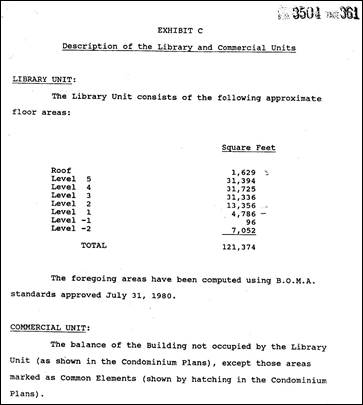
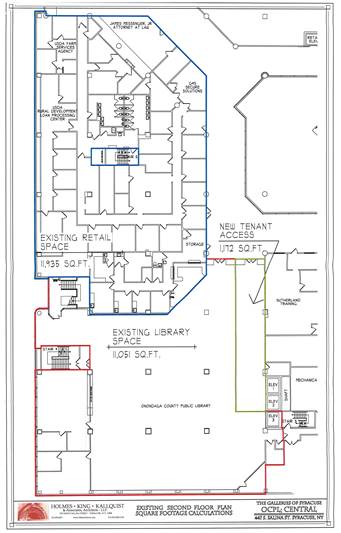 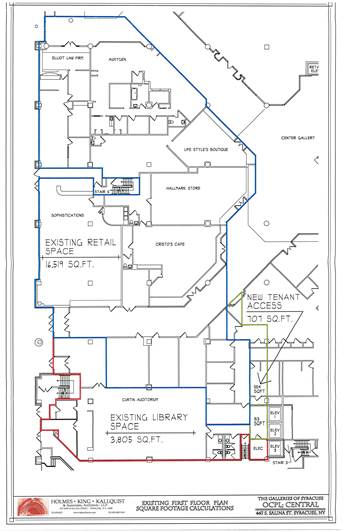
-
Current plan to vacate 4th and 5th floors; library staff on 5 will be moved to 1, 2 or 3; collections and other items on 4 also moved to 1, 2 or 3; local history and genealogy would move to 3
-
Create smaller library – 30% smaller; less expensive to operate; i.e.: currently pay money to other condo owner for HVAC, comes out of library’s budget
-
Going forward lease payments from Upstate would pay for 4th and 5th floor allocations of those costs; less space - will pay less for heat and chilled water as examples
Mrs. Rapp asked if it is two fifths less. Mr. Fisher responded approximately. Right now, the County is paying $11,000 to $12,000 per month, which is $145,000 to $150,000 per year. It will save $60,000 to the library.
Mr. Ryan asked if they are expanding space on one. Mr. Fisher agreed, and stated the County is leasing 29,440 sq. ft. There is an engineering firm, Holmes-King-Kallquist, through RFP that is contracted to do design work. On the first floor there is Cristo’s Café, Hallmark store, Staples on the east side, and on the west side a café that was open until recently. All the space on Salina between the two entrances, all the way back to where Cristo’s Café is now, will be leased on one. On two, it will be the same footprint as one, but the County already has some of that space. It will be stacked so everything seen from Salina Street between the two entrances will be library space of about 30,000 to 31,000 sq. ft. The library will be taking up more space on one and two, but it is roughly 30,000 sq. ft., and they are giving up 60,000 sq. ft. on four and five. Mr. Fisher agreed with Mr. Ryan that the County is picking up space on one and two. Mr. Ryan stated the County still owns four and five, and will be renting it back to Upstate. Mr. Fisher agreed. Mr. Ryan said the County has expanded the amount of space it owns, and asked what happens if the hospital wants to pull out in five years. The County would be on the hook for more space, paying for more, and maybe cannot find a tenant for the space; now there is a problem. Mr. Fisher responded they are planning to generate more money from renting four and five, then needed for rent space in one and two. The money will be held in reserve. Upstate will be leasing over ten years, with the option for two five year renewals. The County is leasing the space from the Galleries for twenty-three years. The County will be generating a reserve each year, and adding to that. Some of that may be used by Facilities. As a landlord, the County will have to fix things that break. Mr. Fisher is anticipating a significant reserve will build up over the ten year period. Mr. Fisher agreed with Mr. Ryan that without a tenant the County can absorb the cost with the money that was built up. Mr. Fisher commented that the County has to lease the space long enough to pay off the bonds, which some were issued last summer. It has to be a twenty-five year lease from the date of the bonds, so it will be a twenty-three year lease starting in June of next year. The hope is to start building out the new library at that time, open it the following spring, and occupy it for twenty-two years after.
Mr. Dougherty stated Upstate is renting for the next ten years. If they decide they do not want to be there anymore, are they still on the hook for payment? Mr. Fisher answered yes. As a state university, this will be approved by the Chancellor and their board. SUNY has the financial stability to do that. Mr. Dougherty is not worried about their financial stability, but a short term decision being made. Mr. Fisher agreed with Mrs. Rapp that they are obligated. Mr. Fisher stated Upstate is signing a ten year lease. Mr. Dougherty asked if there is an early termination clause that they can get out of it, or if there is a penalty. Mrs. Berger replied they can terminate, but will have to pay back the County any costs incurred during the lease. Mrs. Berger responded to Mr. Dougherty that it is any costs related to the build out. Mr. Dougherty asked if the County put forward money to make the space suitable for Upstate, and they stay for less than ten years, then they do not have to pay for the remainder of the lease. Mrs. Berger replied not the full remainder of the lease, but costs. Mr. Fisher stated they need to make sure to put in an allowance for a tenant fit out, and will be advertising that for ten years. If the County is not renting it for ten years, then it needs to get the money back. It is hard to imagine the County needing to get another tenant, when this is Upstate’s IT department and they are the largest organization in the County. Mrs. Rapp asked for language to be put in stating if something happens, then Upstate would be obligated to find a tenant to fill the space. Mr. Fisher will ask Law to come back with information for the Legislature with what contingencies there are, and what would happen under different scenarios. Mr. Dougherty agreed with Mr. Fisher that it is unlikely, but bets the people at Widewaters were thinking the same thing.
Mr. Fisher:
- Meeting in early March; Upstate looking for place to move IT when lease with Widewaters expires June 30th next year
-
Finance looking for space; CFO of hospital not entire university; lease expires October 2016; looking for 60,000 sq. ft.
-
Upstate is gov’t like the County, so need to advertise/solicit, advertised through NYS contract reporter; essentially an RFP and County submitted proposal; requirements: 10 year lease, in County, downtown, 60,000 sq. ft.
-
Only thing changed – Upstate wants 10 years to begin when second space occupied; first space lease is 11 years and couple months; 2nd space will be 10 years; 2026 when lease expires with two 5 year options
-
County response to RFP – proposed 3rd and 4th floor; Susan Mitchell asked team to think about whether 3 and 4 or 4 and 5 would be the right place to vacate
-
Conclusion to vacate 5 so staff and public facing library could consolidate on 1, 2 & 3; greater efficiencies
-
Addressed concern about passionate supporters of history and genealogy – make only by appointment; space to be deployed as public facing central library; think it’s a better way to offer collection and access to it
-
Proposed a per sq. ft. of $11.40; only paying $8 ,but have to pay for tenant fit out; on County to do fit out
-
Project money to build library (not on tenant); getting allowance of $40/sq. ft. times 60,000 sq. ft. which is $2.4 mil
-
Over 10 year lease; amortize that so $240,000 each year comes out of lease and pays the County back
-
County puts money in, hires architect, puts out for bid, and delivers built out space over next ten years; $4.40 out of the $11.40 goes to repay builder; other $7 the County keeps – no capital costs, don’t pay taxes
-
Will have to pay Facilities to keep space up and recoup any costs in delivering base building to tenant, will have to pay Onondaga Galleries for heat and chilled water
-
Will keep some money for reserve; if don’t have tenant, can still pay lease on floor 1; numbers work so projecting more than $100,000/yr added to reserve; over 10 years should have about $1 mil which is probably 3 years of rent of 1st, 2nd, and 3rd floors
Mr. Ryan stated $8 per month times 60,000 sq. ft. times three years. Mr. Fisher agreed with Mr. Ryan that the County could absorb three years without a tenant. Mr. Ryan asked where Mr. Fisher got the $7. Mr. Fisher responded to Mr. Ryan that $4.40 per sq. ft. per year times 60,000 sq. ft. is what is required to pull out of the rent to pay the County back. Mr. Fisher stated they will take what the Comptroller calls pooled cash, not fund balance, spend it, and put $2.4 million into it. The first year the County will take out $240,000 for rent, then replace it. Every year more and more will be replaced until it is fully replaced. They did something similar with the stadium by using $4 million, then using naming rights to pay the County back. Mr. Fisher replied to Mr. Dougherty that the County will take in $11.40 per sq. ft. per year; $4.40 times 60,000 sq. ft. is $268,000. It cannot be called interest, but in essence the County is receiving two percent interest. Mr. Fisher stated the County cannot charge interest to another municipality, but they are paying the County more than $2.4 million. Mr. Fisher responded to Mr. Dougherty that 60,000 times $4 would be $240,000. Mr. Dougherty stated the $4 is the difference between what the County is charging Upstate, and what the County is paying in rent. Mr. Fisher commented that the County is only renting 30,000 sq. ft., and Upstate is renting 60,000 sq. ft.
Chair Tassone asked if what the committee is looking at is the proposed contract. Mr. Fisher replied the proposal, and what the County got back from Upstate, is a lease agreement. It is a standard SUNY lease, and the lawyers have been working on it. Chair Tassone asked if they have an actual term on the lease. Mr. Fisher responded they do not have a final lease agreement, but hope to have a near final version by Friday (for when the local laws need to be on the desks). There are always things the lawyers need to change, and will let the Legislature know of anything that needs to be changed. If Law or the Legislature feels this needs to come back because the changes were big, then they would bring it back. Mr. Fisher anticipates it will be primarily legal changes. SUNY said they are starting with their lease, and when the County starts changing it, SUNY may not like certain changes. It will take some amount of time (couple months) before it goes to the SUNY Board of Trustees for approval. Mr. Fisher expects to have something that lays out the business terms and conditions in their final form on the desks by Friday.
Chair Tassone stated they will not be voting on item 1b until the Legislature has the actual terms of the lease.
Mr. Ryan asked if the lease agreement will be made available to the committee as it stands. Mr. Ryan is not looking to get rich on this thing, and does not want to see the tax payers on the hook for this. Mr. Fisher responded he will file one with the Clerk of the Legislature. The local law will reference the version of the lease that is on file with the Clerk, and the Clerk can make it available. Mr. Ryan would like to see that the County is on track to accumulate what has been forecasted after ten or eleven years. Mr. Fisher agreed. Mr. Dougherty said it would be good to have some of those details before approving either one. Mr. Dougherty said it seems to be a well thought out idea.
Chair Tassone asked if the committee did not want to vote on 1a. Mr. Dougherty would have a hard time voting in favor of it without knowing the details of 1b. Chair Tassone stated the committee will not vote, and asked Mr. Fisher for more information. Mr. Fisher agreed, and said the funding source for 1a is 1b, so they have to be taken in tandem.
Mrs. Rapp stated it is a very good outcome compared to what it looked like in January, and Mr. Dougherty agreed. Mrs. Rapp said the build out should be marketable as well with the type of space not being a library (office space). Mr. Fisher agreed, and said the enhancement to the HVAC will accommodate more people. Mr. Fisher believes when the tenant leaves, everything is owned by the County, and Mrs. Berger agreed. Mr. Fisher clarified that any permanent fixtures will belong to the County.
Mr. Dougherty asked where the four hundred parking spaces are. Mr. Fisher responded the city agreed to provide, at market rate, four hundred parking spaces at the Harrison Street garage. They are keen on seeing these jobs come downtown, and are willing to carve out four hundred spaces in their city owned garage for the next ten years. Mrs. Rapp asked about the adjacent garage. Mr. Fisher commented that it should be reopened when the Red House project comes to fruition. They are expecting to open and release 200 to 300 of those parking spaces; perhaps the whole garage. Mr. Fisher said this would be great. The County’s condominium partner lost all of their spaces there, and are parking people in the County’s open parking lot. That is good for the County, but they would rather be adjacent. Mr. Dougherty would like it to be fixed for curb appeal. Mr. Shepard asked if the four hundred spaces are outside the $11.40 per sq. ft. Upstate is paying. Mr. Fisher said yes, and Upstate will be paying that directly. It may be a license that comes through the County, but the County will not have any financial obligations to the city. Mr. Fisher stated the County will not subsidize it. Whatever the rate agreement is between the city and Upstate, is the rate.
2. FACILITIES MANAGEMENT: Duane Owens, Commissioner
a. Amending the 2014 County Budget to Make Funds Available for use in Making Repairs to the Roof Over the Civic Center Theaters ($300,000)
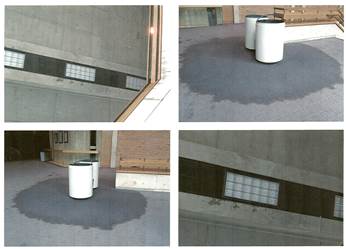 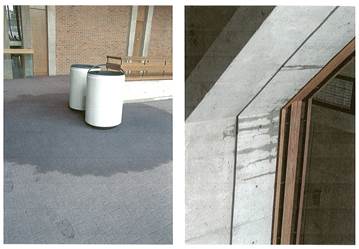
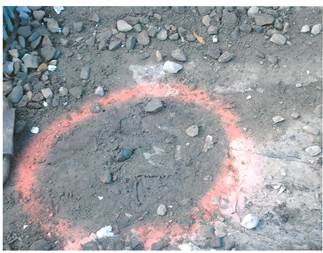 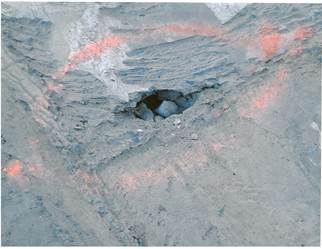
- Asking committee to release contingency funding for roof repair to Civic Center theater
- Pictures above are from just before an event to took place the same evening; happened during the day
- Right before the steps; repair needed; took liberty to peel back roof; cracks and holes; roof past useful life span
Chair Tassone asked if they put out bids. Mr. Owens responded yes, and they have contracted Dewald. Mr. Owens replied to Mr. Ryan that they are local. Chair Tassone asked what the price is. Mr. Owens answered they came in a little higher than anticipated at $573,000; originally looking at $510,000. Mr. Owens is proposing that they possibly make up the difference through savings realized in operations. Chair Tassone stated they have $200,000 in past projects. Mr. Owens said they have that plus the $300,000 in contingency ($500,000), and they will make up the $73,000 in other savings or possibly capital funding. Mrs. Rapp asked if they have to split with the projects account. Mr. Owens said yes.
Mr. Dougherty asked how old the roof is. Mr. Wixson stated it is the original roof circa 1974. Mr. Owens replied to Mr. Dougherty that the life expectancy of a roof is twenty to twenty-five years tops. Mrs. Rapp asked if the roof is flat. Mr. Owens answered yes. A lot of manufacturers say twenty to twenty-five years for the life expectancy of the materials, and the weather here plays a big factor in that. Mrs. Rapp stated it’s been forty years, and Mr. Owens agreed. Mr. Owens said it is way past expectancy. The Civic Center office tower roof is just as bad, but they have not had the urgency yet. They are working on the design, and will come back to the Legislature to replace it. The Civic Center roof is more critical (even though it has not leaked like this one), because the IT equipment is right underneath it.
Chair Tassone stated the resolution is to amend the County budget for the $300,000 in contingency.
Mr. Shepard asked what the square footage of the roof is. Mr. Wixson responded it is under 50,000 sq. ft.
Mr. Owens replied to Mr. Dougherty that there were five companies who bid. Originally there was a sixth with a lower bid, but they requested to be pulled out. Their numbers were wrong, which they realized after the fact.
A motion was made by Mrs. Rapp, seconded by Mr. Dougherty, to approve this item. Passed unanimously; MOTION CARRIED.
Mr. Dougherty asked when it will be started and completed. Mr. Owens responded they have already started it, and it will probably be done in another six weeks.
3. PARKS AND RECREATION: Bill Lansley, Commissioner
a. Amending the 2014 County Budget to Provide Funding for Planning and Design Work Related to the Expansion at the Onondaga County Veterans Memorial Cemetery ($69,850)
- Historically opened an acre at a time as cost savings measure; not mowing areas of cemetery that are unused
-
At level to open another acre; want to release funds in account dedicated toward perpetual care of cemetery to open (or assess) another acre, and do a full assessment of all 52 acres
- Assessment - what property to use for burial and what to avoid (areas with heavy rock or water issues)
-
On contract engineering firm estimate of $69,850 for full assessment of property; will give understanding for today and future of how 52 acres should be used; immediate need to get 1 acre identified and cleared to continue burials
-
Approximately 200 plots left, which will take the department through late spring to mid-summer next year; comfort level to have an acre ready so there are no issues
Mr. Lansley responded to Mr. Ryan that the open area currently has two hundred plots, and there is no plan for where to go next for additional plots. Mr. Lansley said they have gone in a progressive manor. Mr. Ryan asked how many plots are in an acre, and Mr. Lansley answered thousands. It is about three years of plots per acre. Currently the department is doing burials at a higher rate than years before; typically three or four a week, and now eleven. Mr. Lansley replied to Mr. Ryan that there are fifty-two total acres developed with nine or ten on the veteran’s side. They have already developed out the chapel, parking lots and roadways. Loomis Hill is on the other side which takes another ten acres. There are about thirty acres left to deal with. Mr. Ryan asked how many acres the engineering firm is going to engineer out. Mr. Lansley responded they will be assessing the entire property. This is a master plan for everything the County owns.
Mr. Lansley replied to Mr. Dougherty that it is not a project account. When a veteran purchases a plot, they pay $500, which goes into an interest bearing account. When they are buried, there is a $450 charge that goes against the burial fee, and the remaining $50 stays in the account (interest bearing). There is $310,000 in the account. Mr. Dougherty stated this is money Parks already has allocated, and it is not additional money. Mr. Lansley agreed, and said this is releasing money the department already has. Mr. Lansley is asking for authorization to spend money that is designed for this project.
A motion was made by Mr. Dougherty, seconded by Mr. Ryan, to approve this item. Passed unanimously; MOTION CARRIED.
4. INFORMATIONAL: Syracuse Chargers Annual Regatta - David Holder, Conventions and Visitors Bureau
Mr. Holder:
Mr. Bufano thanked Chair Tassone and the committee for allowing him to speak at the meeting. Mr. Bufano:
- President of Syracuse Chargers for 4 years; born and raised in Liverpool, graduated from Liverpool High School, received scholarship for Syracuse, coached for City girls program and won national championship in 2002
- Looking for direction, help, and feedback
- 2013 – CVB approached about bringing regattas back to Syracuse; some may recall large regattas in past
- Strategic planning for where to go in the future; two major initiatives came out
- Proposal hoping to share with County, but will start with the history (proposal at the end of the presentation)
 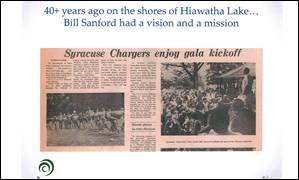
 
 
 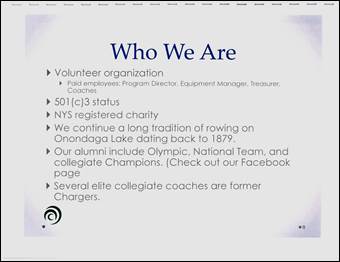
 
 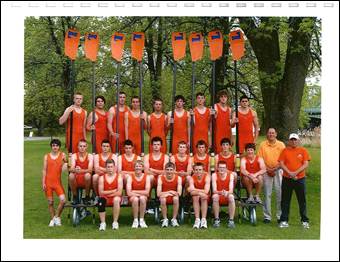

 
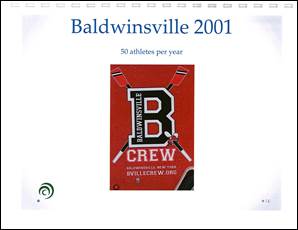 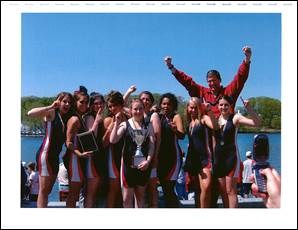
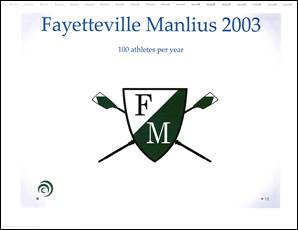 
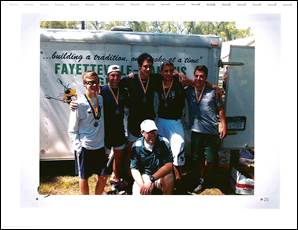 
 
 
 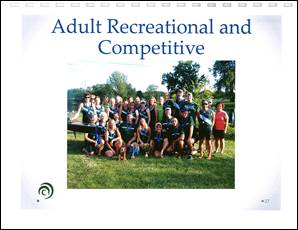
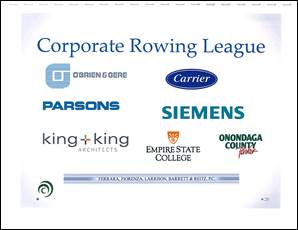 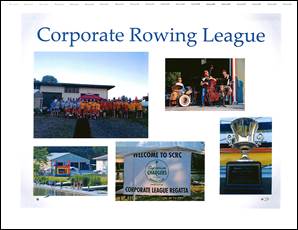
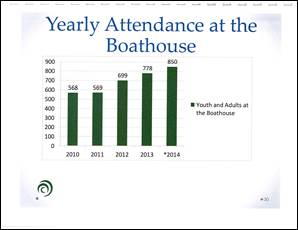 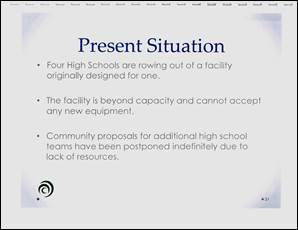
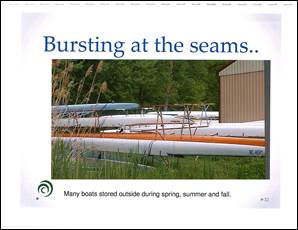 
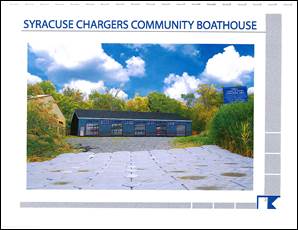 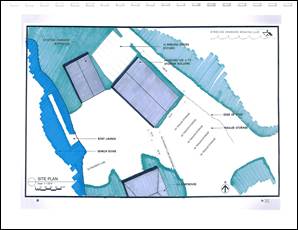
 
- Boathouse – fundraised approx. $190,000 to construct, commitment through Al Stirpe’s office for $135,000
Mr. Bufano responded to Mrs. Rapp that this would add space to the existing boathouse. Mr. Bufano stated they have approval from the state, and waiting to sign the lease for where the boathouse will be. Mrs. Rapp asked if this would be for storage, and Mr. Bufano agreed.
Mr. Dougherty commented it seems expensive at half a million dollars. Mr. Bufano said it is due to the size of the boathouse, and the second floor (for training opportunities with rowing machines). Mr. Bufano would like to store the race course as well. Bringing racing back to Syracuse is their second initiative, and they will need a facility large enough for the race course.
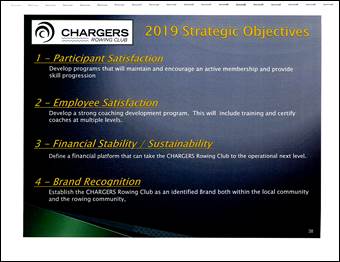 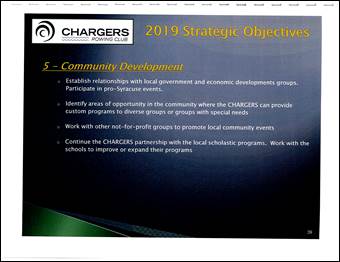
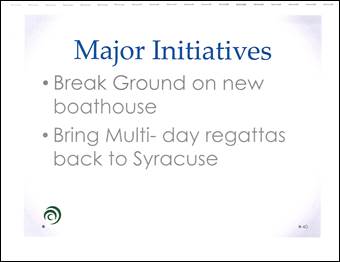 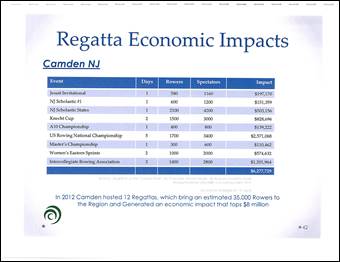
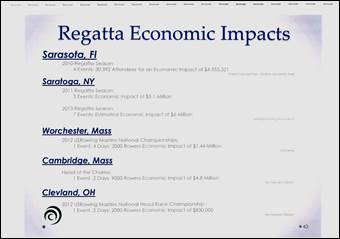 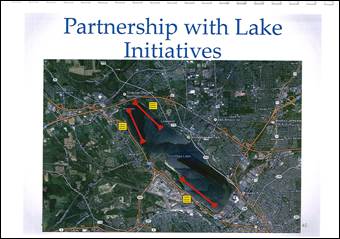

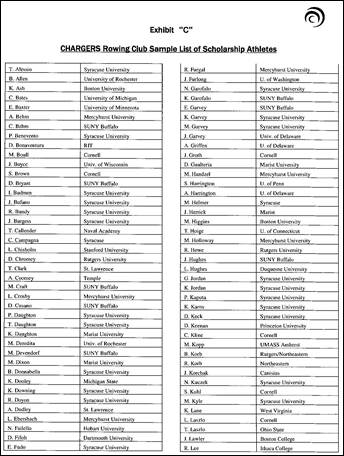 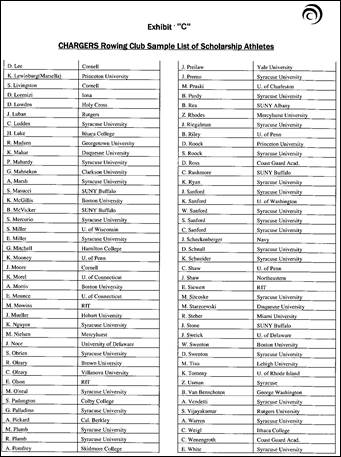
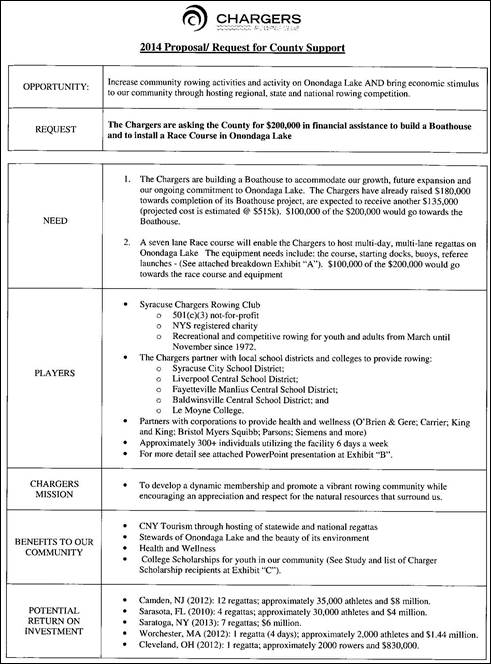
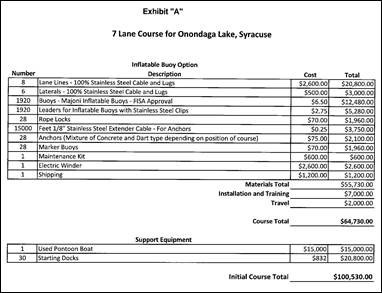
Chair Tassone asked if the money from Mr. Stirpe’s office is guaranteed. Mr. Bufano replied it is a reimbursement grant that Mr. Bufano is still signing and doing paperwork for; cannot say it is guaranteed. Chair Tassone asked what happens if they lose it. Mr. Bufano had asked that question, and was told it does not matter. Mr. Bufano responded to Mr. Dougherty that the grant has been issued.
Chair Tassone asked how often the Chargers have fundraisers. Mr. Bufano responded that they have been fundraising for ten years for the boathouse, which is the main focus. Every year the Chargers fundraise through the regatta, they hold fundraisers that host hall of fame events with an entry fee, and they accept donations. Chair Tassone asked if they are charging schools and individuals for use of the boathouse. Mr. Bufano responded they are charged a facility fee for access and usage of the equipment (boats). A brand new boat for a high school is approximately $30,000, and a used boat is about $15,000. The fees pay for the equipment, motors, coaching launches, docks, etc.
Chair Tassone stated the main reason for this is to boost the economy by bringing in regattas. Chair Tassone asked Mr. Bufano to explain about the regatta, and how many people they are talking about. Mr. Bufano stated the bottom of the proposal page shows the economic data, and page 42 and 43 (of the powerpoint) show samples of regattas in other locations (number of spectators, rowers and financial impact). Mr. Holder commented:
-
Made contacts through trade shows; made connections with High School Rowing Association of NY – currently use Saratoga as base for most events; interested in coming to Syracuse
-
Cannot guarantee, but likely to shift some business to Syracuse – bring travelers including teams, family, spectators
-
Made contact with USA rowing (national rowing governing body) interested in Syracuse for NE location
-
Potential for bringing in regional and national championships; will be spaced over a few different years, but would be highly likely groups would bring some competition to Syracuse on regular basis; in addition to what Chargers do
Chair Tassone asked where nationals are held in the northeast currently. Mr. Holder responded Camden, New Jersey, and Mr. Holder is sure they would like to go to a different city. Mr. Bufano commented they currently have a regatta in the spring (a Saturday), which runs all day. Starts in the morning with qualifiers, then heats, semi-finals and finals. Families will set up tents along the shore, come in the night before, stay at hotels, and eat at restaurants. Mr. Bufano stated their goal is to bid for the NYS championship, which would bring ninety teams from across NYS to Syracuse. Mr. Ryan asked how many days that is. Mr. Bufano replied two to three days (Friday and Saturday). Mr. Ryan said this is a good project, commended them for fundraising, and stated a lot of people ask for help, so the return on investment is big. Mr. Ryan stated Mr. Holder’s group does a fantastic job, and is probably already promoting. Mr. Ryan asked how many regattas per year are the Syracuse Chargers looking to do, and will the County’s return on investment compare to what the examples are. Mr. Bufano responded they anticipate ramping up, which would include at least two regattas in the spring (local and NYS championship), one or two during the summer, and one during the fall. Once they have their hands around those, they will make the determination if they can handle more. Mr. Bufano stated at the very least they would host five regattas a year. Mr. Ryan asked how many athletes total. Mr. Bufano answered there are ninety teams in NYS with fifty athletes per team, and then they are the parents, coaches, etc.
Mr. Holder stated he can do a realistic view of what the business looks like, what the events would look like, and how the events would be potentially spaced in. They know the next open dates for NYS and USA rowing, and know other events that are being tossed around. There are a lot of unknowns out there like possibly collegiate events they could attract. Mr. Holder stated they can look forward to when those events can come in, the attendance levels and overall estimated visitor spending. Chair Tassone commented that would help a lot. Mr. Ryan said they have done bowling, talked baseball and softball, so let’s talk rowing.
Mr. Dougherty looked at the picture of the proposed boathouse, and asked if this is what they are looking to build. Mr. Bufano agreed, and said a lot of the cost is the foundation. The foundation has to be solid because of the nature of the land. They tried cutting costs by looking at a pull barn, but the ground is too unstable. Mr. Bufano responded to Mr. Dougherty that the second floor is not in the drawing, and it will be raised higher for it. The last piece is the growth which has been halted, because they have no more room. Mr. Bufano said to buy equipment and store it outside in the elements, does not make sense. The city and Baldwinsville have only girls programs, and asked the Chargers to start boys programs, but they cannot. They are open to it, and have a proposal from the city to start a boys program when the boathouse is built. Mr. Bufano replied to Mr. Dougherty that the schools pay a facility fee.
Mrs. Rapp asked what they are asking for from the Legislature; gap funding. Mr. Bufano said yes. It would include the race course, and whatever the gap would be for getting the boathouse completed. Mr. Holder commented the Chargers could ask for the race course itself, but it cannot exist without the expansion. Mrs. Rapp asked what it is. Mr. Dougherty responded $200,000. Mr. Bufano stated it is $64,000 plus the buoy lines, racing launch and starting docks that go along with it. Mrs. Rapp asked about tourism money. Mr. Holder does not know the specifics on Mr. Stirpe’s money, but they could go after REDC money (application would not go in until June at the earliest). Chair Tassone stated this is just an informational.
Mr. Ryan said if there is mention of other schools that want to do this and this is that big, then maybe they should be thinking bigger. If there are other schools out there with the possibly of more events, then the County could make more money on the original investment. Mr. Bufano commented that they are thinking big, and would like to see rowing in other high schools. Jamesville-Dewitt had an individual that wanted it. The Chargers would like to see West Genesee start a team because they are close to the lake. Mr. Bufano said they have those goals in mind. Mr. Ryan said he does not mean subsidizing school programs, but getting events to Syracuse, and getting people to come here for regattas. Mr. Bufano stated if they have a race course that is seven lanes wide, then they will see people from across the country. The Masters Nationals is a national regatta with people coming from across the country. Mr. Dougherty said he does not know anything about the sport, and asked why a seven lane course would draw so many people. Mr. Bufano responded:
- Initial investment to be made; course needs to be tried and true; welcoming
- Onondaga Lake – trail along the course; spectators from start to finish; coaches can ride a bike from start to finish to watch their athletes
- Location – majority of rowing is in the northeast, and this is centrally located
Mr. Holder said an advantage to the course they priced out, is that it is capable of being installed in different parts of the lake; bringing attention to the west shore with new development or east shore with the park. There is a lot of flexibility that will allow the Chargers to showcase the lake. It is a great opportunity to bring visitors into the lake experience. Mr. Ryan commented there will be two new hotels in the inner harbor and a creek walk connecting it to Armory Square. Mr. Holder agreed with Mr. Ryan that there is huge potential.
Mr. Bufano stated in terms of location there are three potential places for the race course (page 45). The top right hand is the tried and true location where the IRA Regatta was in the seventies and eighties. The calmest waters are at the top left, and they are very interested in the Honeywell locations. That would be ideal during the summertime, and the view from the bluffs and west shore trail are beautiful.
Mr. Dougherty likes this, and feels the cost is high, but the concept is fantastic. Mr. Dougherty asked what the Chargers would do if the Legislature gave less than the $200,000. What would they give up? Mr. Bufano responded that the course is the course, so they cannot give that up. The Chargers would have to continue to fundraise. Mr. Bufano said they tried to cheapen the boathouse with a pull barn, but engineers said they cannot do pull barn construction. Mr. Bufano agreed with Chair Tassone that they will continue to fundraise. Mr. Holder said it would be a timing issue. Mrs. Rapp asked if they could bond for it, and pay overtime. Mr. Bufano replied perhaps, but have not looked into it. Chair Tassone commented that in the long run the County will get a lot out of this. Mr. Holder said there are cities out there that put their eggs in the rowing basket (i.e. Oklahoma City), and it has been a major payoff.
Mr. Bufano responded to Mr. Ryan that he is not familiar with too many regattas that go on during the winter, as most racing runs through fall.
Mr. Bufano thanked the committee for their time.
The meeting was adjourned at 11:46 a.m.
Respectfully submitted,

Jamie M. McNamara, Assistant Clerk
Onondaga County Legislature
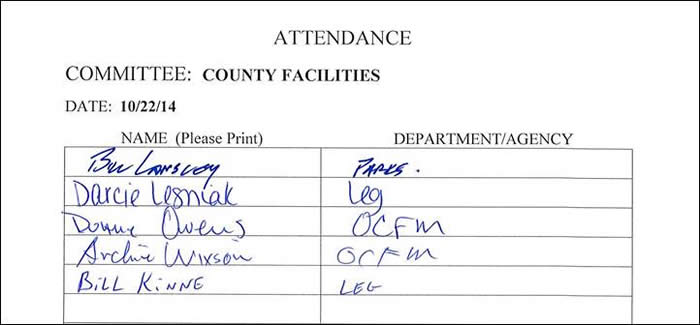
* * *
HEALTH COMMITTEE MINUTES - OCTOBER 23, 2014
DANNY J. LIEDKA, CHAIRMAN
MEMBERS PRESENT: Mr. Corl, Mrs. Tassone, Dr. Chase
MEMBERS ABSENT: Ms. Williams
ALSO PRESENT: Also see attached list
Chairman Liedka called the meeting to order at 9:30 a.m. A motion was made by Mrs. Tassone, seconded by Dr. Chase to waive the reading of the minutes of the previous committee. A motion was made by Mrs. Tassone, seconded by Mr. Corl, to approve the minutes of the previous committee. MOTION CARRIED.
1. HEALTH: Michelle Mignano, Deputy Commissioner
a. Amending the 2014 County Budget to Appropriate Additional Funds Related to the Provision of Medical Examiner Services to Oneida County ($50,000)
Ms. Mignano stated the County negotiated with Oneida to provide services to Oneida County, and anticipated a $50,000 increase in the budget. As the negotiations finalized, it was beyond the time frame to make changes to the budget, and this money is needed to run the MEO. Ms. Unger stated the contract amount is $560,000.
A motion was made by Dr. Chase, seconded by Mr. Corl, to approve this item. Passed unanimously; MOTION CARRIED.
b. Ebola Virus Update: Dr. Nguyen, Medical Director
 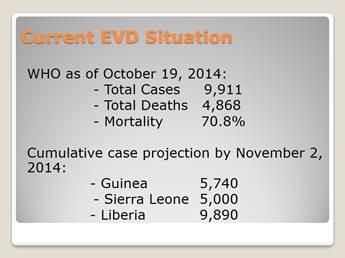
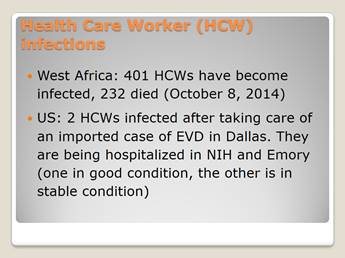



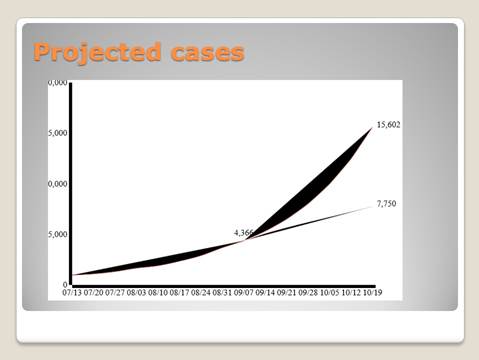
- Scientists follow certain modules for every epidemic; several ways to put everything in
- Disease around since 1976, but in isolated areas; first time perfect storm; hit populated area of impoverished country
- If nothings done, not under control and still die at same rate – by next January 1.4 mil people will be infected
- US, WHO, United Nations have personnel, expertise, equipment in these countries that don’t have good infrastructure

-
Passengers coming from those countries will book flight ending in one of the 5 airports; CDC has personnel at departure in those countries and in the 5 airports in the US to ensure they have screening information for all people
-
All risks will be followed up with; CDC and border patrol will tell state where final destinations are, and state will tell OCHD which ones will come to Onondaga County
-
OCHD is in charge of following these people for 21 days after the last time they were in one of those countries
-
Last few days – 120 passengers landed in JFK from those countries; most went to NYC; 4 went to different counties in NYS (waiting to hear from NYS if Onondaga County has any)
-
Issue is when they will hear from the state; NYS set up an electronic record so the counties can lock in to see who it is
Ms. Mignano stated the Health Department has not been notified of any recent passengers that have gone through JFK, been identified as coming to New York, and have come to Onondaga County. There are a few individuals that are being followed, but the concerns and threats in the County are low. Chair Tassone asked if the state is required to let the Health Department know. Ms. Mignano said yes. NYS requires an active response (not a voicemail), so the Health Department will know via phone call, fax or email.
Dr. Nguyen:
-
Governor designated 8 regional hospitals to accept the patients; locally SUNY Upstate - their prep is very intensive; set aside a floor, train personnel on how to process a person with Ebola, and have correct equipment
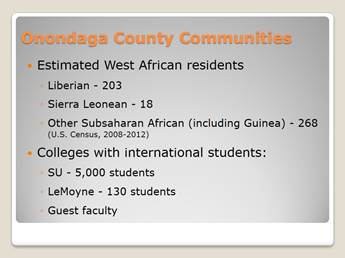 
Ms. Mignano:
-
Conversations about how many refugees are in area; number of NYS central urban areas are home to relocation programs; suggested that refugees could be sources for Ebola, but that is very unlikely
-
Refugees that are brought over have extensive health checks, are screened rigorously, have medical care and are not moving from one place to another when they relocate to the US
Dr. Nguyen commented that almost all refugees stay in the refugee camps for several months or years, and those camps are not in those areas.
Dr. Chase stated there have been three countries targeted for special handling, and asked what if a person does not come directly from Liberia (goes from Liberia to France, then enters the US). What kind of safety net do they have? Dr. Nguyen responded there are two ways to look at this. All of the official channels will catch most of those people when they are buying a ticket with the destination of the USA. There are safeguards depending on the type of passport the person carries. The person would probably still have to carry the original country passport unless they are a citizen of the US. Besides the official channels, there is always a lengthy questionnaire at each airport before boarding. Dr. Chase asked if all of the international airports have this screening. Dr. Nguyen agreed, and said there will be cases where they do not know exactly every stop that the person makes. A recent article looked at the number of people traveling out of these countries, and estimated, every month or so, there would be a risk of three people leaving these countries possibly having Ebola (2/3 would go to other countries, 1/3 would go to western countries). The risk is about 1 out of 100,000 of arrival. Hopefully those people will come forward, and be straightforward with the health care workers. The hospitals here getting prepared to be able to catch them. Dr. Chase said there is a fairly large refugee population in Onondaga County that are in different parts of the county. A lot of the people Dr. Chase has seen at the free clinic are family members of people who have settled here, and have no health care. Dr. Chase asked if there is a plan to include the clinics and the people who volunteer with the educational process. Those people are more likely to find the local neighborhood doctor or clinic. Dr. Nguyen state the NYS acting commissioner has ordered to make sure that all facilities that take care of patients are to follow his order. They are waiting for clarification with NYS to see what signage to put up in those clinics, how to train the healthcare workers, how to train to protect the workers, and how to train to detect these cases. Dr. Nguyen said there might be some concern, but they are planning to deal with it.
Ms. Mignano:
-
Putting responses in layers: immediate response (1) keep public and healthcare workers safe; (2) tracking, and having all of the systems in place; confident that they are finalizing where they are; (3) broad health education
-
If someone comes through NYC, then population best to serve whether person could be ill (i.e. Ebola, TB)
-
Will be working with walk-in clinics; regularly communicating with providers; constantly sharing information
- Finalizing general community preparations which includes first responders
- If clinic were to have patient, they would contact OCHD for help - transport/direct patient to appropriate health care
- Would be in best interest not to be in Liberia until the disease is more controlled
- Expect it will be long term; not under control until well into 2015; cases not symptomatic or contagious

-
People with symptoms within 21 days of traveling from one of the three countries are under investigation
-
If providers or hospital identify a person, call OCHD, discuss patient characteristics, and see where person fits in criteria; if patient is high risk, then they would be isolated; workers have appropriate gear
-
If person isolated, have to coordinate with EMS and ambulance services to see where person would go
-
If person highly suspect, here in 21 days, then would go to Upstate – designated treatment center
-
When person gets to hospital, OCHD job doesn’t end but begins; link person with NYSHD, and lab in Albany to provide the specific tasks for person
-
When person identified, initiate investigation of where person has been, where they stay, who has contact with person – will go to commissioner of NYSDH to see what they have to do
-
Job done day in/day out (for TB, whooping cough, etc.); difficulty - i.e. 1 person in Texas generated 100 follow-ups

Ms. Mignano stated 911 is ready. They have a set of questions, and they have guidelines. In progress refers to how to prepare for something suspect, which is hard to do until it comes up. Dr. Nguyen said in progress because they recently had a meeting where every department was there. Dr. Nguyen continued:
 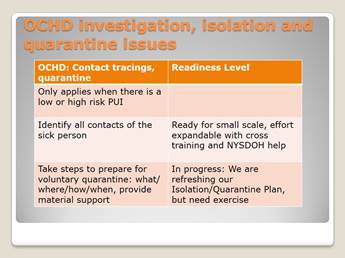
-
First section on quarantine issues: already obsolete; mandated by federal authority to follow every single person – not high or low risk anymore; every passenger that comes from those countries has to be followed
-
Third section – have to involve the judicial system, work with law enforcement, Red Cross – if there were cases, then people have to stay home for 21 days; not supposed to go out in public
Ms. Mignano:
- Two choices: voluntary quarantine or formal quarantine
-
Voluntary – unless someone was breaking quarantine, and needed a court order; working on some aspect of checking in to make sure they are abiding by it; based on if they are under investigation or known Ebola case
-
If it were to be an Ebola case, may quarantine anyway; want to make sure person has enough support for grocery supplies; limiting, isolating and quarantining
Dr. Nguyen:

Ms. Mignano:
-
Difference between someone that is compliant, and someone that isn’t; this will be a commissioner’s order – public health order; great if order is issued, but what about following the order; want to talk about this, and what to do
Dr. Nguyen:
- Conclude that Ebola is a wakeup call; has silver lining – raises awareness that health of citizens in the County affects everyone; have to be ready to take care of them, protect health care workers, have things in place to support service
- Lucky to have well-trained and dedicated staff, and can deal with most of these issues
- Help needed in future would be more money for training, equipment, and how to track these people
- Ebola will change the County; NY times article - questioned doing CPR on person in street; what to do – changes everything; local health department is small, but up to the challenge; will do best to be prepared for any scenario
Ms. Mignano:
- Had meeting with 911, first responders, airport – discuss border patrol, and process of what to do
-
Ebola is scary; transmission and how impacting West Africa is horrifying; how to treat and safeguard health workers is intense; requires a lot of material, time and money; fortunate for the health care in America
-
Anthrax can live forever, and Ebola cannot; Ebola does not live outside a body or fluids, and is killed by sunlight
-
If a person traveled to one of the three countries and was injured (possible blood splatter), someone tries to help them, then that person that helped goes home, washes up - will they pass it to their children? Answer is no
-
It can only be passed if it is symptomatic; will work together to keep community safe for individuals and families
Dr. Chase said she understands their role in investigating and monitoring, but where are they with treatment of this. Dr. Nguyen responded:
Mr. Corl asked if a person is under investigation from NYC, then who checks in with them. Dr. Nguyen clarified that Mr. Corl means if a person has a risk factor like travel, or a person is staying in the same house with a person sick with Ebola. If a person is staying in the same house with someone that is sick in the twenty-one day period, then that person will be in the high risk level of follow-up. They would be asked to stay home, not expose other people, and monitor an average of twice a day (call the OCHD). Ms. Mignano stated Mr. Corl is talking about a high risk person coming from one of those countries into the US that are supposed to come into the County. If a person arrives in NY, they should identify the place where they are going to be. That information is transmitted to the NYC Department of Health, and that person will be assigned someone to follow-up with (visiting or phone calls). If there was a Liberian in Onondaga County that was being contacted and they are no longer here, then the OCHD would pick up the phone and notify the County where the person is traveling to (same as NYC). Some details are being finalized today about checking in, and tracking all passengers to ensure the highest level of safety. Dr. Nguyen stated if an international passenger comes into JFK, then they are given four or five laminated cards that will instruct them what to do. If they get sick, then they are to hand the card in. This is one last line of defense if they do not here from those people.
The meeting was adjourned at 10:26 a.m.
Respectfully submitted,

Jamie M. McNamara, Assistant Clerk
Onondaga County Legislature
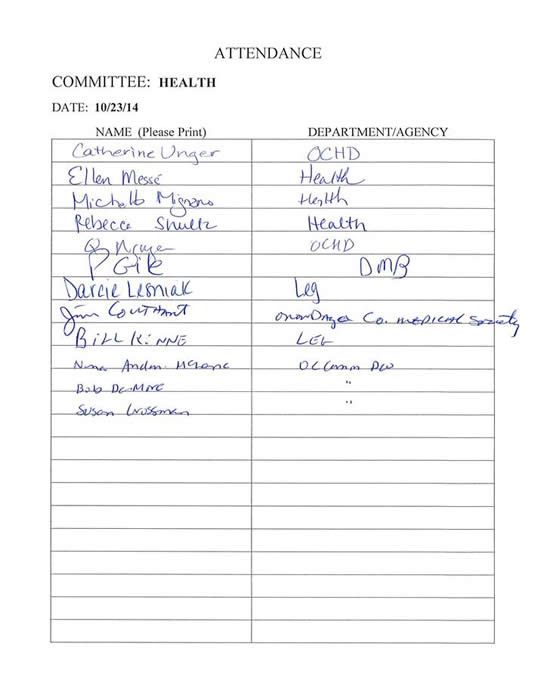
* * *
PLANNING & ECONOMIC DEVELOPMENT COMMITTEE MINUTES - OCTOBER 23, 2014
KATHLEEN A. RAPP, CHAIR
MEMBERS PRESENT: 1Mr. Liedka, Mr. Corl, Mr. Knapp
MEMBERS ABSENT: Mr. Plochocki
ALSO ATTENDING: Mr. McMahon, Mr. Ryan, Mrs. Ervin, and see attached list
Chair Rapp called the meeting to order at 10:38 AM. A motion was made by Mr. Knapp, seconded by Mr. Liedka to waive the reading and approve the minutes of the previous committee. MOTION CARRIED.
1. ONCENTER: William Fisher, Deputy County Executive
a. INFORMATIONAL: Designating the Former Hotel Syracuse as the Convention Center Headquarters Hotel and Authorizing the Execution of Agreements to Implement the Intent of this Resolution
Mr. Fisher:
-
Hope to send resolution to Ways and Means, think contract will be ready tomorrow; latest draft sent to developer Ed Riley and his attorney on Tuesday, hope to meet with them today and get feedback
-
Already approved $1.1M used for acquisition, City used eminent domain to take the property, court completed that phase of eminent domain and turned title over to Mr. Riley; parallel process will determine actual price paid under eminent domain, money is sitting in judges hands, process may take a while meanwhile title has transferred and Mr. Riley can develop his property, has nearly completed all financing, 2 pieces to be finished are bank financing, understand local bank will be leading financing, waiting on announce from Regional Economic Development Council of $3.9M grant
Chair Rapp asked how he could get financing, if they don’t know how much they are going to pay for the hotel. Mr. Fisher said that Mr. Riley has reached an agreement with SIDA to pay up to $1.6 million for the acquisition of the hotel. SIDA previously obtained an appraisal that the property was worth $825,000. Mr. Riley will then pay up to $1.6 million and SIDA then assumes the risk above that number. Mr. Riley has literally mortgaged his house and has provided evidence that he has the $1.6 million SIDA would need.
Mr. Knapp asked if the $1.6 million would go to the previous owner or for back taxes. Mr. Fisher said that this was up to the judge, but his understanding is that the City and County, as taxing authorities, are paid first; always get their money before secured creditors do with eminent domain.
-
Few years ago Senator Schumer advocated for new market tax credits, fell through, in spring big gap opened in Mr. Riley’s financing stack, REDC agreed to advocated for additional state dollars to come into the deal, with those dollars, bank financing, which they believe is imminent and equity financing that he will need to complete, believe he has the $61M needed to complete the project
- Hotel agreement summary and Attachment A to Room Block Agreement reviewed
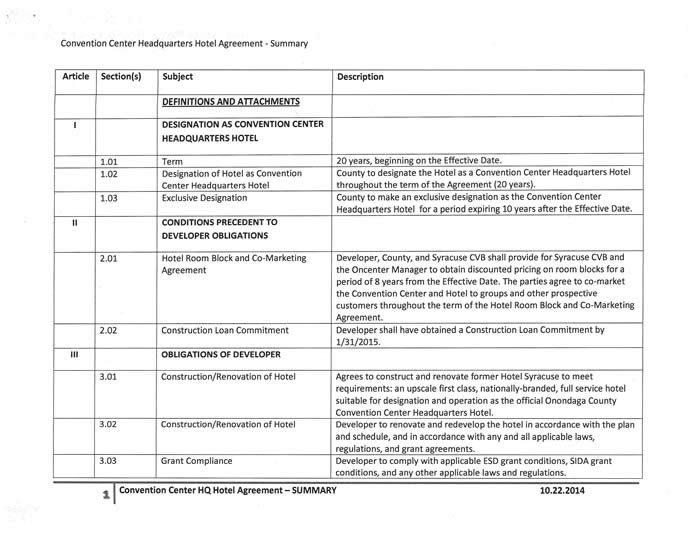
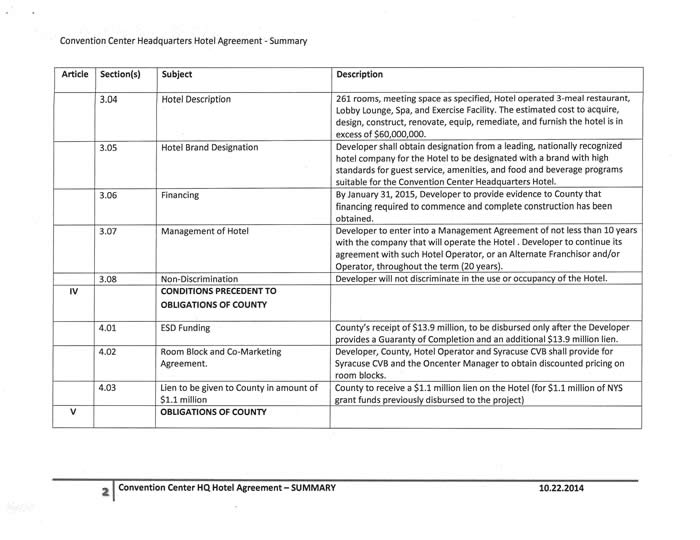
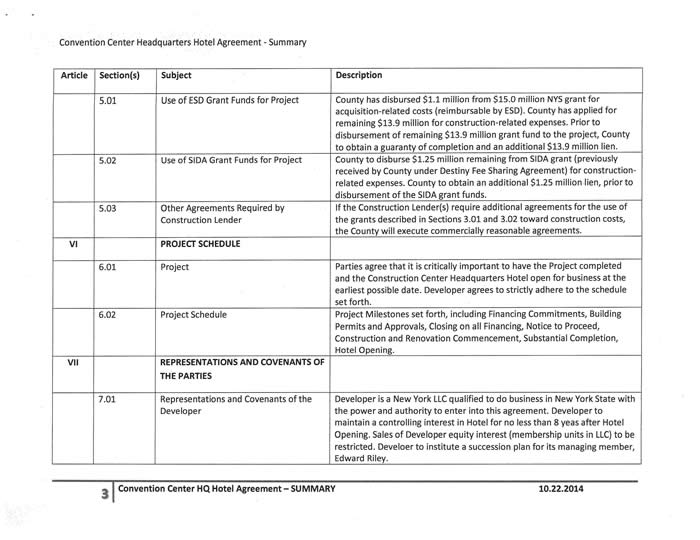
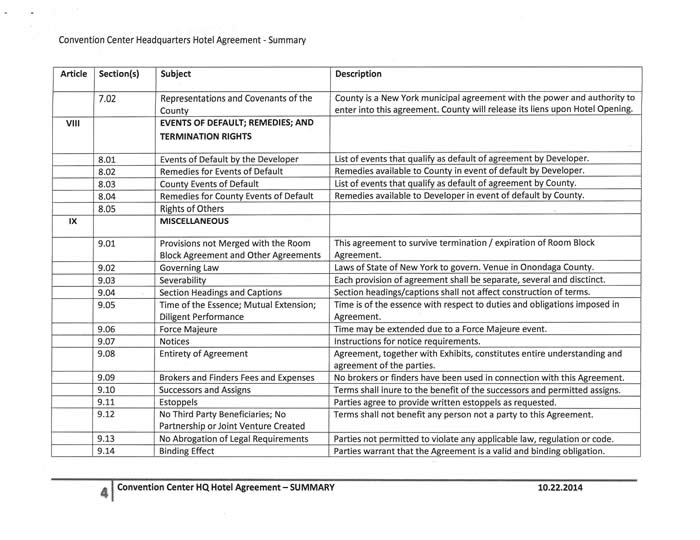

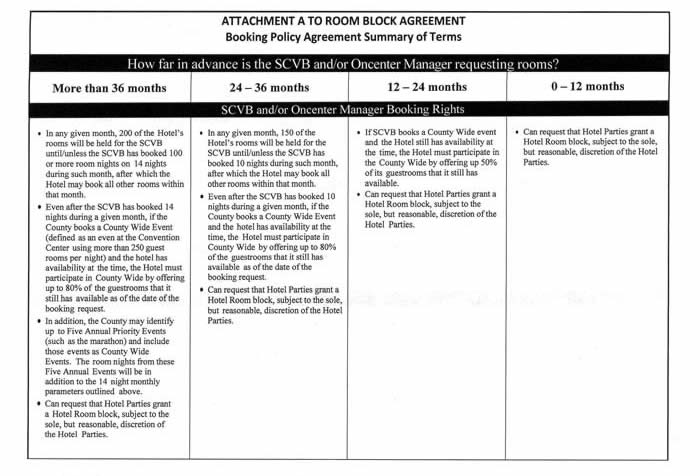
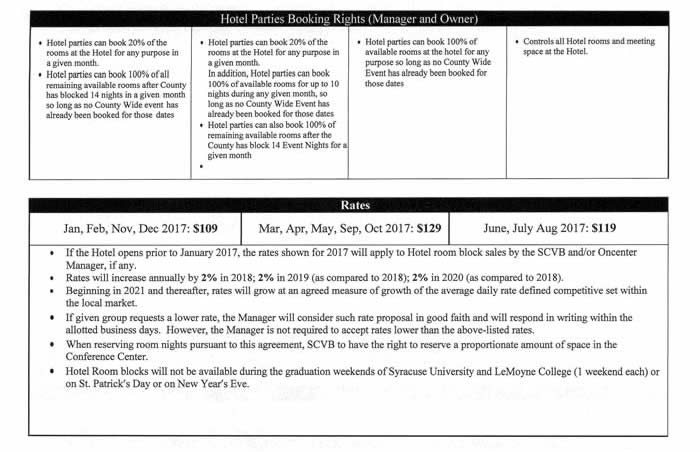
-
Agreement contains specific dates when evidence must be provided, all the milestones a bank would need, not putting any more money in until all money is in one place and have guarantee project will be completed
-
Agreement designates this hotel as the Designated Convention Center Headquarter Hotel for 20 years, defines a region in which it will be on the only hotel, region essentially from Adams to Townsend to Jefferson to Salina; exclusive designation for 10 years but able to call his hotel a Convention Center Headquarter Hotel for 20 years, in return will do things for us, see above summary of room block agreement, pricing below expected average daily rate, room rate competitive but not so low as to hurt other hotels in town, specifics of how room blocks are set located in summary
-
County will use its best efforts but not guaranteeing any rooms, if they fall short of joint targets won’t need a make up payment; was part of prior discussion, committee had some concerns, has been removed from the deal
Mr. Liedka asked if the inventory hold was a blanket 7 days a week and if not, would the rate vary based on the day of the week, i.e. Tuesday, Wednesday, Thursday is when hotels typically make their hay. Mr. Fisher responded that the rate would not vary by the day. Mr. Liedka said that as a hotel owner it seems like they are leaving money on the table. This makes a difference if they are selling to an association and they can are able to get in here midweek and pay $109 dollars. Mr. Fisher said the only limitations are the graduation weekend for SU and Le Moyne, St. Patrick’s Day and New Year’s Eve are not included. In answer to Mr. Liedka, Mr. Fisher said that they could only pull back inventory with the County’s consent, but they have to sit down with them on a quarterly basis to discuss this. The alliance model that exists today will be the forum for this, every 90 days, SCVB, Oncenter management and hotel management will review. The legislature has the opportunity to be a part of the review and he encourages them to be part of the alliance. The contract won’t specify a specific hotel chain, Hyatt remains very interested and others have expressed interest as well; contract language will say it most an upscale first class hotel. There are hotel organizations that have their own robust sales team and in the 24-36 months period in particular, their sales organization starts to kick in, so they want them to sit down every 90 days and review what it looks like; can work together to fill any holes, as they want the success to be mutual.
Mr. Liedka said that not only is the name on the building important, whomever is holding the management contract is important. When people drive by and see a name on a hotel, they assume that company owns it. In the company, he works for there are 4,000 Marriott’s and the Marriott family owns six of them. The sales systems are tied to whomever is managing the hotel. The success of this hotel will clearly be driven by who is managing, not necessarily the name on the hotel, they need both. Mr. Fisher said they agree. Currently the hotel management companies have been narrowed the down to four and have been very open about telling them who they are and explaining how their business model works. In the contract, they have to sign an agreement that is standard in the industry for at least 10 years. To keep the designation throughout the 20 years they must keep a relationship with a first class hotel operator throughout the 20-year period.
Mrs. Rapp asked if this would preclude them from building a hotel on the County lot for the next 20 years. Mr. Fisher said that it would be for a shorter period. Chairman McMahon said that the draft says 10 years. Mr. Fisher said that the last draft has a blank; one of the things that has to be resolved.
Mr. Liedka asked if this would be a union hotel. Mr. Fisher said that all facets of the 261-hotel rooms would operate as a union hotel. In answer to Mr. Liedka, Mr. Fisher confirmed that food and beverage could be subbed out. Mrs. Rapp said that this was part of getting the $15 million from the state. Mr. Fisher agreed, adding that to get the state grant they must follow the states rules, which are built into Mr. Riley’s model, and he knows what it is going to cost. His company has done many union and nonunion hotels and he knows how to get the work rules he needs. To Mr. Liedka’s point, it will be one of two union hotels in town and they think it will be attractive because the unions have a lot of conferences and trade shows. Mr. Liedka added that they will not go anywhere but a union hotel, unless they have to a in a city that doesn’t have one.
Mrs. Rapp said that before they vote on the resolution, they would have the number for that period and asked if where any other blanks. Mr. Fisher responded, not that he can think of.
-
Block and Co-Marketing Agreement 8 year term, expect hotel to be stable in 8 years, SCVB able to sell room blocks in advance, if 8th year sell something 3 years out will be able to bind that so in some respects 8 years becomes 11 or 11.5 years of preferential pricing; beyond this term developer and County will set down and determine if it is still in their best interest, if only hotel in the district might still be, if not would probably want different agreement where multiple hotels have the right to co-market with the County and the County has the right to get to room blocks in more than 1 hotel
Mrs. Rapp said that for 8 year they could not co-market with any other hotel. Mr. Fisher added, within the Convention Center Hotel District, outside of this there are no restrictions. The hotels that exists today are all outside of this district so they can continue to do what they are currently doing already. They would not have the same room block agreement and the same co-marketing, which is a more intensive level and the County would be barred for some period from entering into a room block agreement on substantially similar terms. However, this would not stop them from doing what they do every day; SCVB is out selling to any number of hotels for a large event like the bowlers. In addition, they have to have this because this hotel will not be big enough for the room nights that they expect to come through.
Chairman McMahon asked for a breakdown of every dollar of public benefit in this deal. Adding that this was progress, but he wants everyone to understand what they are endorsing.
Chairman McMahon said that Mr. Riley took out a loan to move this process forward and asked if this agreement allowed him to get his equity back. Mr. Fisher said that he would only be able to get his equity back after satisfying all the liens; will be liens for each grant and the $1.1 million already approved. Chair Rapp said that the County would get their money before he does. Chairman McMahon reiterated that this is a financial deal and again asked that they break out the cost of the building, all grants, and what the loan is so that the public gets a since of what equity is really in this deal. In addition, he asked for confirmation that the release of state money and the SIDA grant would be coming back to the Legislature, if this were approved in November. Mr. Fisher said that the SIDA grant was approved in 2007; the grant disbursement for the $15 million would have to come back to the Legislature.
Mr. Liedka said that since it looks like this will move forward and will be a tremendous investment in that area, he questions if anything has or can be explored to find a way to bridge the gap from the Oncenter to the hotel as part of this agreement. He thinks that having that egress would assure a successful venture and is something he would like to see. Mr. Fisher said that they have had numerous discussions along those lines with them and SMG. Mr. Riley has a renowned architect working on this because he knows that it is an important element of his success. Mr. Liedka added that they are not in San Diego, unfortunately. In answer to Chair Rapp, Mr. Fisher said that there is nothing in the contract that says exactly how this will happen but he is working… Chair Rapp interjected and asked if there was anything in the contract that states it will happen, not necessarily how it will happen and should they put it in. Mr. Fisher said that they could look at how to do that. It is somewhat of a “chicken and egg process”, it is hard to be certain what they will spend their money on until they complete the design and they cannot complete the design sometimes until they have millions of dollars. They have heard consistently that Mr. Riley is going to be counting on business from the Oncenter so he has to finds a way for it to be a good experience or people will only come here once. Mr. Fisher said that they could look at this.
Mr. Liedka said that one thing Mr. Riley needs to keep in mind in order to set the SCVB team up for success they need resolve the tunnel issue. For people that know this area well, this will be their first question, perhaps their second - 1st will be the Hotel Syracuse, and they have to overcome that, question 1a will be have they resolved the tunnel. If they have something in their back pocket it is a dealmaker and invaluable. Mr. Liedka asked if he was speaking out of turn and Mr. Holder said that he was prophesizing. Mr. Liedka said this was going to be their number one strength or weakness.
Mr. Fisher said that it there is probably a 99.9% chance that it won’t be called the Hotel Syracuse as that brand is so tarnished in the mind of meeting planners and people that came here in 1999 and 2000. Chairman McMahon said that even though people will say this is the old Hotel Syracuse. Mr. Fisher said that it won’t be as they a gutting everything. Mr. Liedka said that he did not agree, what happened in the last few years tarnished its reputation but if they look at the life of the property it has fond memories and every woman in Central New York wants to get married in the Hotel Syracuse Grand Ballroom. It is all in marketing and the sales pitch, if open the Hotel Syracuse with a fresh coat of paint and don’t change the infrastructure it is the same Hotel Syracuse. Mr. Fisher said that all he can tell them is that people that are coming from the various chains are bringing forward their plans for different names. Mr. Liedka said that there is a hotel in NYC called the Lexington Hotel on the corner of 48th and Lexington, was the same type of hotel, got bed bugs and roaches, now partnered up with a big brand and called the New Lexington Hotel, and is kicking the tail out of everyone in the area.
Chairman McMahon said that one his concerns is that they work collaboratively and aren’t competing against themselves and asked if anything in the agreement addresses association business. One of the reasons they have been successful with SMG and the reason why this year SMG asked for $200,000 less from the taxpayer because this is key to their success model. He doesn’t mind new organizations going to the hotel, but he does mind if the Oncenter is losing current association business to the Hotel Syracuse. If agreement doesn’t address that they aren’t competing against the Onondaga County taxpayers, he does not know that he will be comfortable supporting this when the state, city and County taxpayers are essentially subsidizing this project. This is something that needs to be addressed. Mr. Fisher said that he did not really understand the concern. Mr. Holder said that if he is interpreting this correctly, this is about state associations that would normally book at the Oncenter… Chairman McMahon interjected stating that it was about association business going from the County facility to the Hotel Syracuse, which would then be doing convention business as part of their model. They are letting Mr. Riley create a potential competitor to themselves and are funding it, which makes no since, therefore there should be something that addresses this issue. He does not think that it would be difficult to address; the hotel is not allowed to pursue existing association business currently at the Oncenter. In answer to Mr. Fisher, Chairman McMahon said he was referring to meeting space, not room nights.
Mr. Liedka asked if meeting space was being held along with the rooms, as it would be foolish to reserve the rooms without the space. Mr. Fisher said that they are not going to be selling Mr. Riley’s meeting space for him. Mr. Holder said they would be selling meeting space for both. Chairman McMahon said that his point was that Mr. Riley has the ability to sell meeting space on his own. Once they look at the financial breakdown, they will see why he is a little frustrated, if this isn’t addressed. This is the most subsidized deal this community has ever seen. Many people can make the argument why there is a good reason to do so, but when they start getting into the fact that the County is getting one benefit from the sale of room blocks but potentially losing business as Mr. Riley can use the convention center brand to compete against the Oncenter it becomes a loser. Mr. Fisher said that he assumes they could figure out how much meeting space they sell that would compete with his meeting space. His guess would be that it would small. When the Oncenter makes money from associations it is from the larger exhibit halls that Mr. Riley doesn’t have. Mr. Liedka said that Mr. Riley had two large spaces. Chairman McMahon said that they have time to figure this out over the next 2 or 3 weeks, but it is a concern. As SMG does their job and becomes more efficient freeing up more ROT frees up to invest in other space, they don’t want to do anything that will hurt that trend. Mr. Fisher said that they could pull this together. Over the 18 months working with SMG, he has never heard them say that a key part of their business model is selling meeting space to associations. Chair Rapp said that when they built the arena there was a lot of competition and they want to learn from the last procurement.
- Project schedule included in agreement:
- Construction loan commitment letter by 1/31/15
- Building permits and approvals and closing on all financing by 3/31/15
- Notice to proceed and commencement of construction renovation by 7/1/15
- Brand designation & management agreement of hotel operator meeting County standards by 3/31/15
- Substantially complete by Nov. 2016 & open by end of 2016; opening goal Spring 2016
- Developer needs designation as Convention Center Hotel to complete financing
In answer to Chair Rapp, Mr. Fisher said that the resolution is a Convention Center Hotel Agreement that designates the hotel as a convention center hotel for 20 years, the exclusive convention center hotel within the district for 10 years and describes the other public money coming to Mr. Riley through the County. In answer to Chair Rapp, Mr. Fisher said that the agreement should be here tomorrow and is a part of the same resolution. Chair Rapp said that they had just received the information and there is a lot to digest.
In answer to Mr. Liedka, Mr. Fisher confirmed that they would like to have the item voted on at the November session. Mr. Liedka pointed out all the information they would need to review for this, along with all the other information for items they had before them. Chair Rapp said that there is a lot, adding that they weren’t voting today, as they don’t have the agreement. She would suggest thinking about what their questions might be and if they are not ready by November, December follows.
2. CENTERSTATE CEO: William Fisher; Deputy County Executive; Tom Blanchard, Senior Vice President & Chief Economic Development Officer
a. INFORMATIONAL: Amending the 2014 County Budget to Make Funds Available for Distribution to CenterState Corporation for Economic Opportunity for its Regional Marketing Program ($25,000)
Mr. Fisher:
-
County Executive initiative proposed in fall 2009 (copy of 2010 Annual Budget documents on file with Clerk): Economic Development Dept. used to have a Development Manager, went to tradeshows, looked for companies to attract here, Director of Economic Development and County Executive worked together to change this, replace Development Manager with Project Development Specialist
-
Same time started putting City and County offices together, shifting focus of County Economic Development away marketing and development and towards closing the deal once attracted and retaining business already here
-
Job description of Project Development Specialist in 2010 budget very different from Development Manager; worked with MDA to shift business development responsibilities to them, now CenterState CEO, Co. Ex. requested $25,000 appropriation to help MDA market this region to companies around the world
-
Once company interested, i.e. Agrana, County very involved on project basis, gets bid package together, works with the state and everyone else needed including CenterState
-
CenterState fundamentally responsible for regional marketing since 2010 budget; 2014 funds in contingency, looking for release, also ask that they consider releasing 2015 funds be used in the way they have since 2010
Chair Rapp said that at the time, she thought they would handle the attraction as they were better at going out and doing the sales and the County would handle the retention and the development of companies looking to come in.
Mr. Blanchard:
-
Michael Novakowski, Director of Business Development & Investor Relations normally presents - was at Greenbuild International Expo, New Orleans, 3 days, meeting with 140 companies; 1000’s of companies present, many in HVAC, 1 of this region’s most prominent & competitive sector, good use of resources to be there
-
Thanked committee and County Legislature for support of economic development efforts, particularly business attraction and regional marketing, critical, County dollars help leverage funds from ESD, National Grid, other counties within region; County contributed $100k in funding over 4 yrs., helped them carryout structured business attraction effort, engage fulltime sales professional – Mr. Novakowski, target sectors where they can demonstrate competitive advantage, market regional assets, to be on the ground at regional events, i.e. Greenbuild, engage new efforts around core direct investment, i.e. China, Europe - would not be able to do as an organization, county or region without support
-
Business attraction takes years of relationship building, focusing on right individual/ company in sector of economy where the region has competitive advantages; had some success:
-
Wipro, India based IT firm, 80 employees located in AXA Towers
-
CSC, IT firm, in process of ramping up to 105 positions
-
Working with Asian based wood manufacturer, went on site tour of Salina Power Park last winter, Chair Rapp accompanied, very close to signing deal, entered partnership agreement with SUNY ESF under START-UP NY, incentive offer through ESD, hopefully weeks away from announcing $3M investment with 45-50 new jobs
-
Mr. Novakowski developed major pipeline, about 80 companies, job creation between 5 & 200 per company, potential investment ranges from just under $1M to exceeding $3M in capital expenditure
-
Next year’s focus 4 specific areas:
-
Continue to engage pipeline companies, regularly respond to information request, conduct site tours, assemble incentive packages and partner with County Economic Development Office
-
Take advantage of new leads through ROI, Canadian consultant engaged 6 months ago, great contacts Quebec Ontario sector, Montreal, Ottawa, Kingston, and Toronto, introduced them to 24 companies in sectors software, robotics, building systems, & unmanned aerial vehicles (UAV); working in tandem with NUAIR, FAA test site and companies attracted to test site, don’t have to be in Oneida, companies doing R&D and potential manufacturing; Onondaga County has Hancock Airpark, academic and university assets companies will be looking for
-
Maintaining presence at important trade and industry shows, Hannover Messe show March 2015, biggest in the world; secured partnership agreement with German American Chamber of Commerce, hosting event in NYC, 50-60 German companies looking to be in the US – CenterState will bringing them up from NYC, hopefully Dec. 8-9 to meet with companies, the County and CenterState, to learn about the region and learn why they should be here to expand
Chair Rapp asked if this was the group, they had hoped to have here this week. Mr. Blanchard said that it was but this was working out just as well because they are going to co-market the CenterState event and the companies are already coming over from Germany; couldn’t ask for better timing.
-
Resolution requests funding for 2 day program, December 8th and 9th, inviting companies from Germany, Greenbuild and site selection consultants, will receive presentations, tours, meet with company representatives, Economic Development officials, discuss why Onondaga County is right place for them
-
Unique, interesting and useful event, budget of $15k for event – hotel, food, ground transportation, subsidize some airfare; key is getting right people here
Chair Rapp asked if they had any commitments. Mr. Blanchard said that they are waiting on the pending approval of this legislation before sending the invitations; they are ready to go.
-
Off to a good start, can show job creation investment in Onondaga County, attraction work is long term have to be on the ground year after year, have good product to sell and good person selling
-
Would appreciate support of this resolution and 2015 allocation; come back and brief them on progress and share plans for next year
In answer to Chairman McMahon, Mr. Blanchard said that it was a coincidence that the German American Chamber of Commerce was hosting one of their Invest in USA Conferences. In addition, they have agreed to help promote CenterState’s event to companies coming from Germany to their event. In answer to Chairman McMahon, Mr. Blanchard said that the date for CenterState’s event is December 8th and 9th. Chair Rapp said that CenterState had changed the date of their event to coincide with the conference in NYC. Chairman McMahon said that this makes since.
Chairman McMahon said that this was a big use of the money and the legislature likes to see money in economic development space invested to create more economic development or sales tax. They have done this with CVB and the arts. If this money is spent on something else, for whatever reason, he can promise them that next year this money won’t be there. Mr. Blanchard said that this was totally understood.
A motion was made by Mr. Knapp, seconded by Mr. Corl to approve this item. Passed unanimously; MOTION CARRIED.
Chair Rapp suggested that they invite Legislators to the event. Mr. Blanchard said that they would be sure to do so.
3. COMMUNITY DEVELOPMENT: Robert DeMore, Director; Nina Andon-McLane, Administrative Planning and Funding Coordinator; Susan Grossman, Housing Program Coordinator
a. INFORMATIONAL: Authorizing the Transfer of Tax Delinquent Properties to the Onondaga County Housing Development Fund Company
Mr. DeMore:
- Request for 2014 tax sale properties, auction 10/28/14
- Received $3.9M in lead funds this year, Ms. Grossman completed the application
In answer to Chair Rapp, Mr. DeMore said that last year’s allocation was all spoken for. Chair Rapp said that this was good. Mr. Knapp said that given how some other communities faired this is a huge hat’s off to Mr. DeMore and his team for receiving these funds. They have heard for horror stories about other communities. Mr. DeMore agreed adding that that they get their work done on time and this is what happens.
Tax Sale Property 2013
Town of Onondaga
124 W Roswell Avenue
Nedrow
 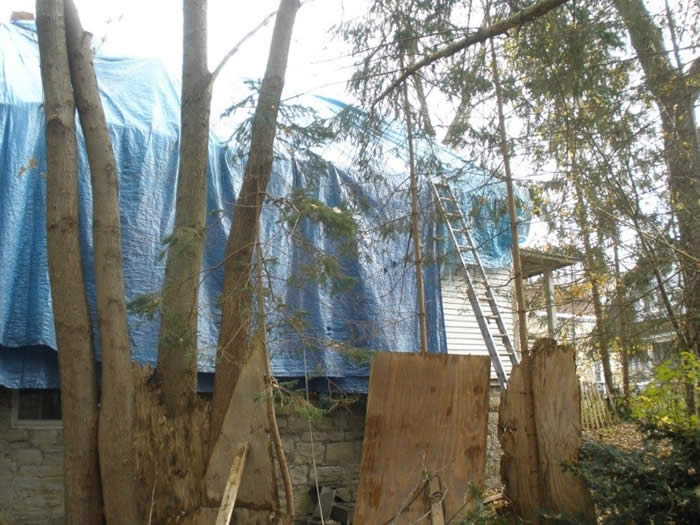
- Tree threw roof on west side of house, good bones, better than a number in area though houses around it are nice
 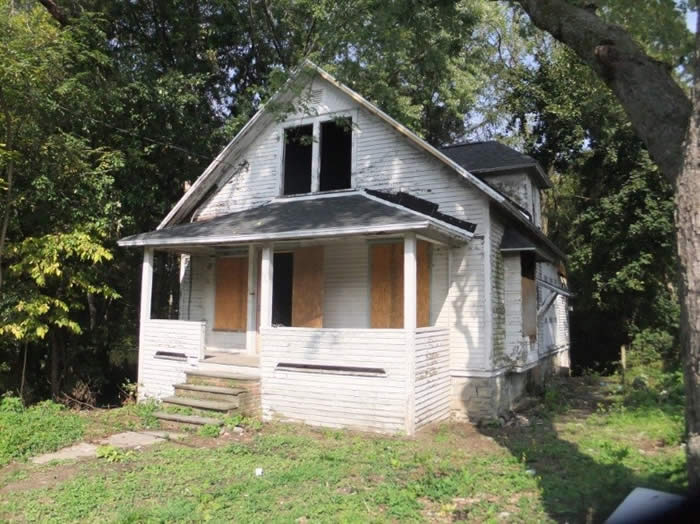
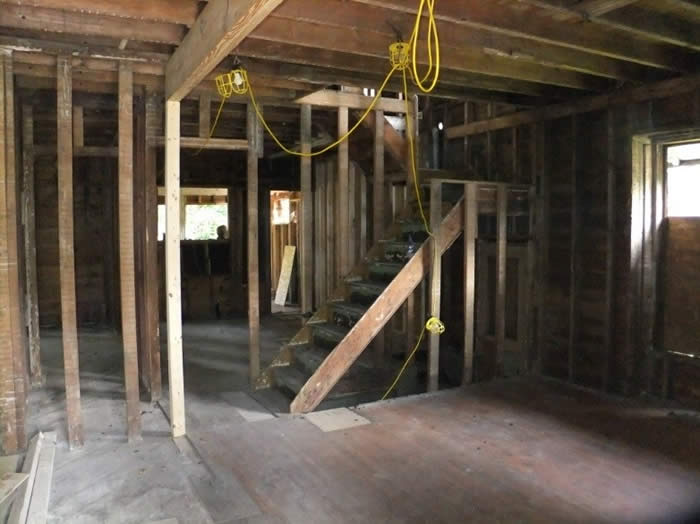 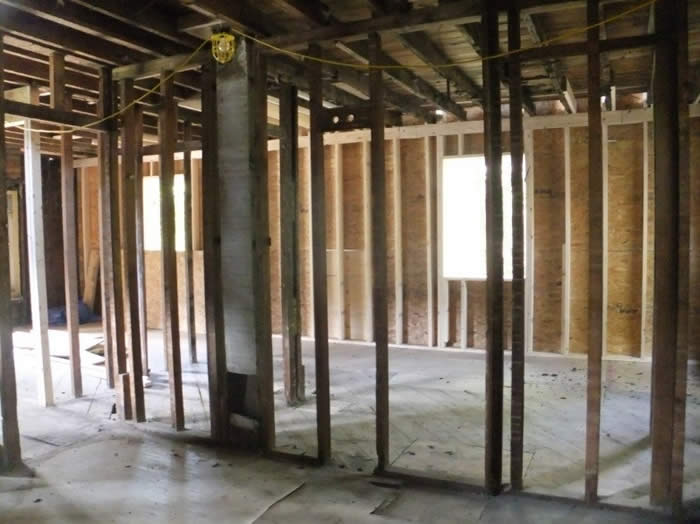
- Gutted inside down to frame, new framing on west side due to roof leak
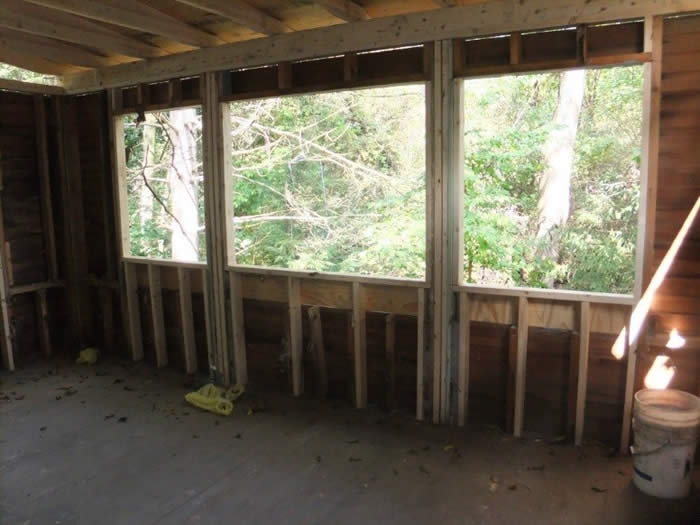
4) Enclosed back porch for family room; will ask for vacant lot next-door this year
Payments to date: 124 West Roswell Ave
CLAIMDATE |
AMOUNT |
BUSNAME |
1_/8_/2014 |
476.21 |
County Taxes |
1/16/2014 |
500.00 |
Pitcher Hill Construction |
3/6/2014 |
280.00 |
Ecospect Inc |
7/28/2014 |
14,650.00 |
Bellavia Remodeling Inc. |
9/16/2014 |
575.00 |
Chicago Title Insurance Co |
9/18/2014 |
32,325.00 |
Bellavia Remodeling Inc. |
$48,806 Payments through 10/23/2014
Remaining construction/repairs: $45-50,000
Estimated Project Total: $95,000-100,000
Tax Sale Property 2014
Vacant Lot next to
124 W Roswell Ave Nedrow
 
- Asking for vacant lot to go with Roswell Ave. home for parking, if approved will clean up and attach to Roswell property
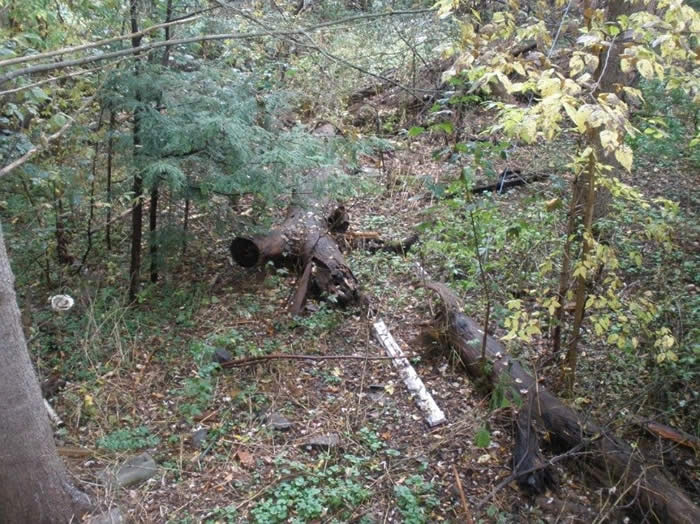 
In answer to Chair Rapp, Mr. DeMore said that there were two small lots, perhaps 60 feet wide but it adds to the house right next to it and they are tight on parking at the house itself. Mr. Knapp added that the lot would not be buildable. Chair Rap said that it provides some privacy land. Mr. DeMore agreed, adding that it just gives them parking that they wouldn’t have. The same people that owned the house own the lot and have since left the lot.
In answer to Chair Rapp, Mr. DeMore said that they put in about $100,000, but some of it was lead money that doesn’t have to be reimbursed. They should just about break even. Mr. Knapp said that it was going to be an improvement to the neighborhood. Mr. DeMore agreed, adding that the neighbors are very happy. Chair Rapp said that they gutted the house and rebuilt it for $100,000. Mr. DeMore agreed.
TAX SALE Property 2013
Town of Pompey
8951 Delphi Falls Road
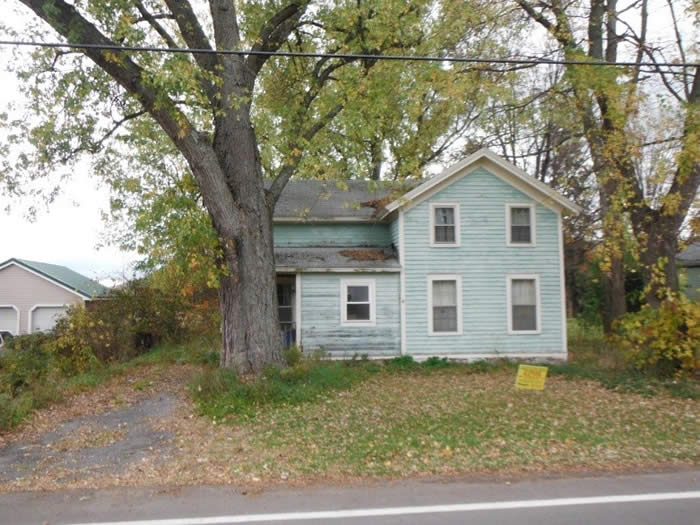 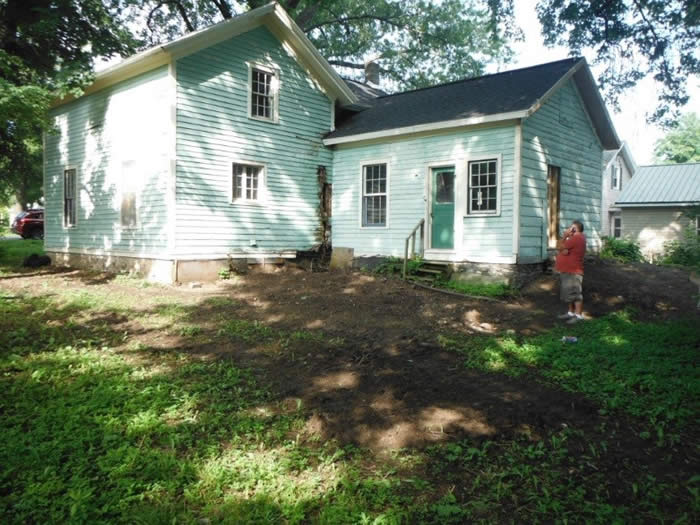
-
Looked nice but septic system was shot and well failed, into quite a bit of money, will break even, nice house, surrounding houses nice, neighbors happy its being fixed up, had to take tree out of the front
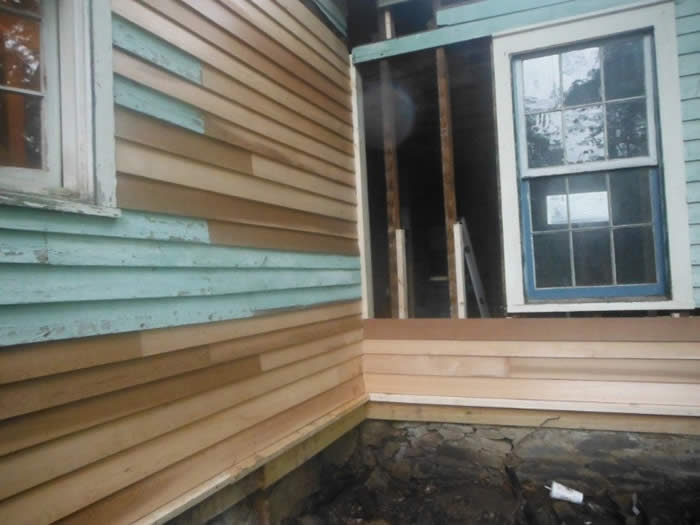 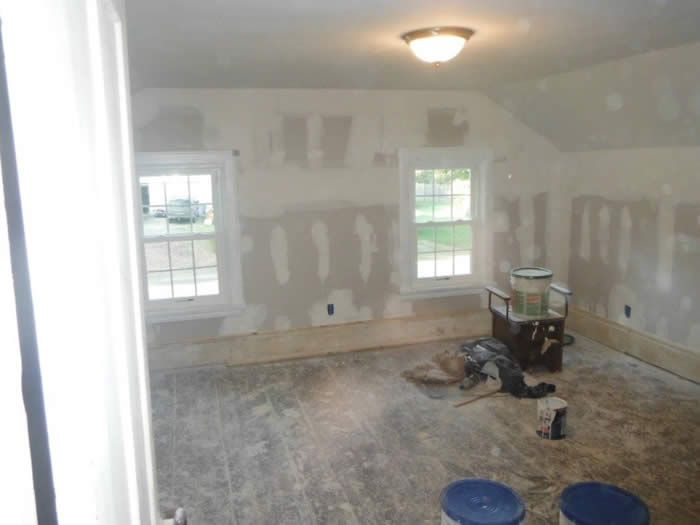
- Had to gut the upstairs, saved pine blank floors, will refinish
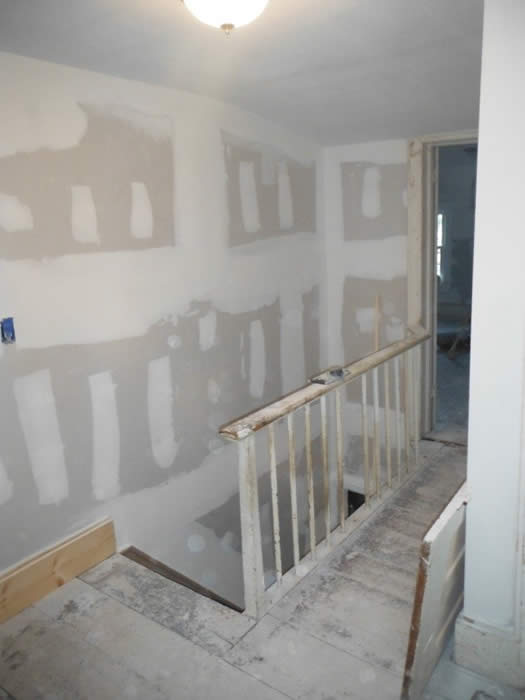 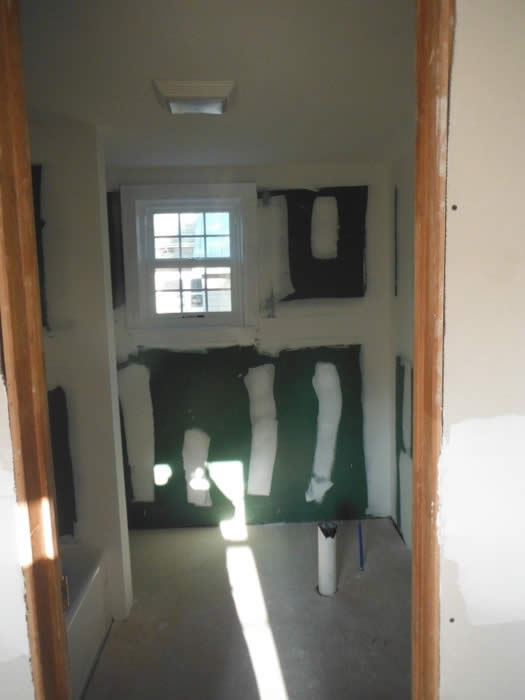
- Hope to save original banister, sheet rocked and insulated upstairs
Payments to Date: 8951 Delphi Falls
CLAIMDATE |
AMOUNT |
BUSNAME |
1/8/2014 |
682.12 |
County Taxes |
2/13/2014 |
18.44 |
National Grid/Niagara Mohawk |
3/4/2014 |
2,200.00 |
Mike Witaszek Remodeling & Construction |
3/6/2014 |
280.00 |
Ecospect Inc |
3/13/2014 |
94.25 |
Environmental Hazards Services LLC |
3/14/2014 |
37.49 |
National Grid/Niagara Mohawk |
3/25/2014 |
295.00 |
Bowden Plumbing & Heating |
4/4/2014 |
30.29 |
National Grid/Niagara Mohawk |
4/22/2014 |
7,200.00 |
Thomas Townsend |
5/12/2014 |
20.65 |
National Grid/Niagara Mohawk |
6/16/2014 |
19.41 |
National Grid/Niagara Mohawk |
6/30/2014 |
19.02 |
National Grid/Niagara Mohawk |
7/15/2014 |
400.00 |
Shutes Water Systems |
8/1/2014 |
25,090.00 |
Bellavia Remodeling Inc. |
8/6/2014 |
23.09 |
National Grid/Niagara Mohawk |
8/25/2014 |
52.36 |
National Grid/Niagara Mohawk |
8/28/2014 |
750.00 |
Christopherson Land Surveying |
9/9/2014 |
2,985.00 |
Walker Tree Care Inc |
9/16/2014 |
625.00 |
Chicago Title Insurance Co |
9/30/2014 |
1,500.00 |
Edward Reid Engineering, PLLC |
10/6/2014 |
30,615.00 |
Bellavia Remodeling Inc. |
$ 72,937 Pmts through 10/23/2014
Remaining construction/repairs: $15-20,000
Estimated Project Total: $85,000-90,000
- Should breakeven with lead money
Tax Sale Property 2013
124 Christopher Drive
Town of Van Buren
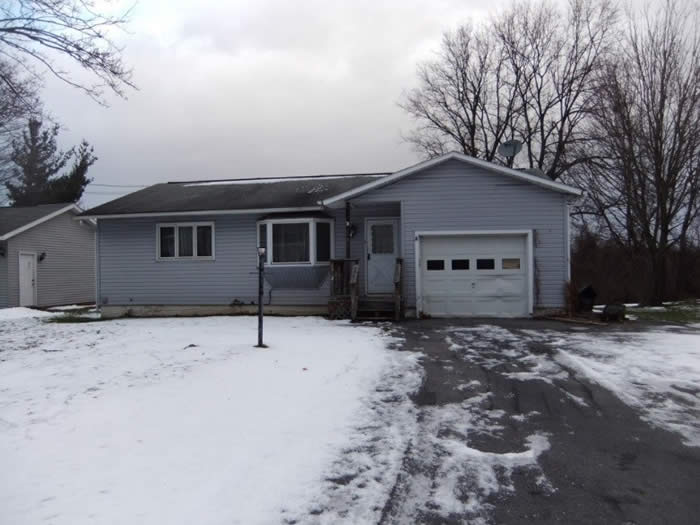 
- Easier fix, messy when acquired
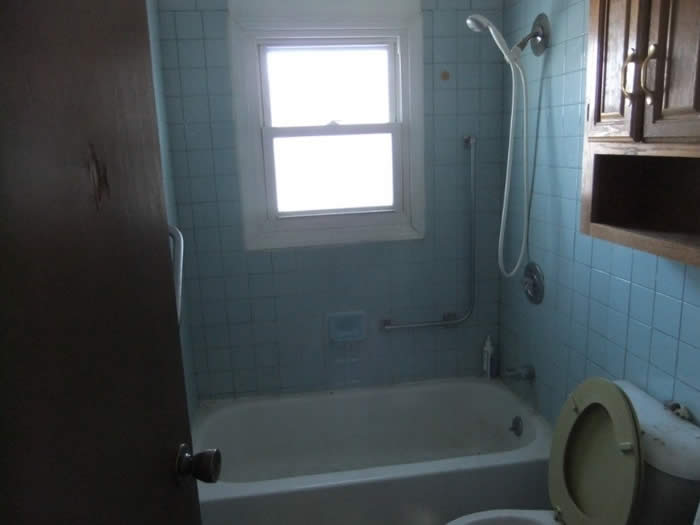 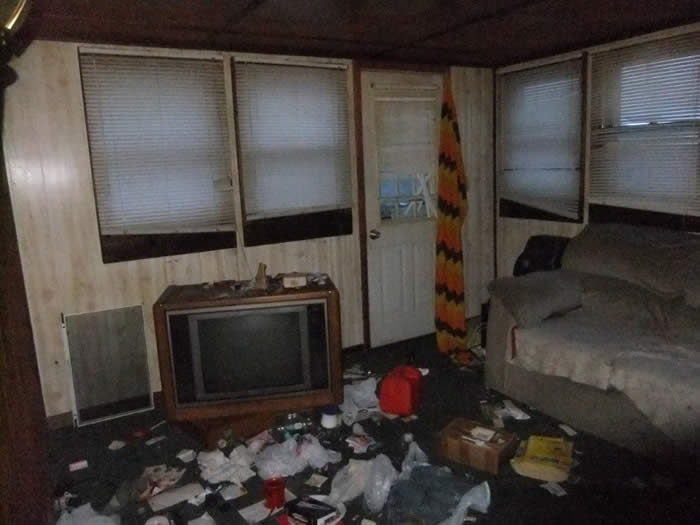
 
- Nice little house, sold, should close in a few weeks
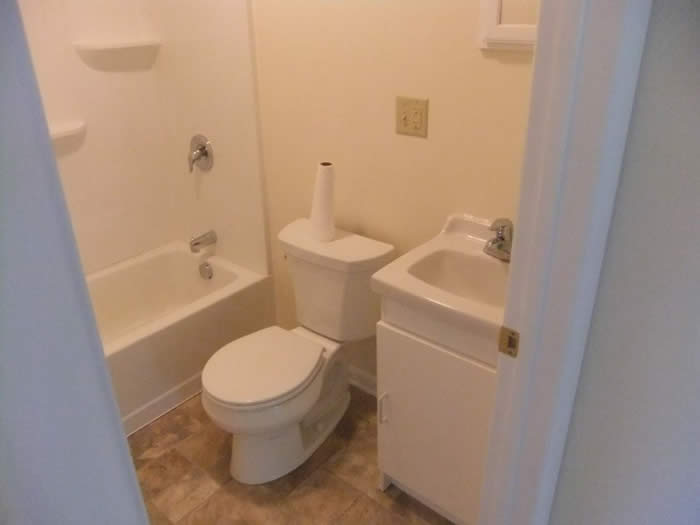 
Tax Sale 2013
Village of East Syracuse
304 E Heman Street
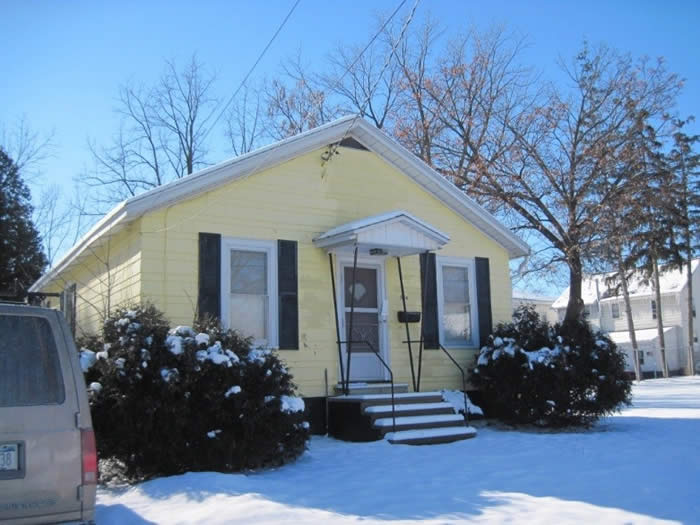 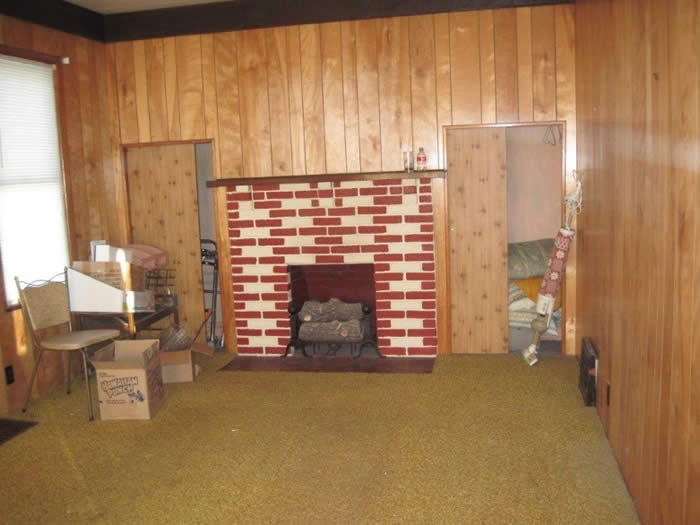
- Land Bank property, acquired at auction, fixed up with funds Land Bank received from Attorney General Settlement
 
 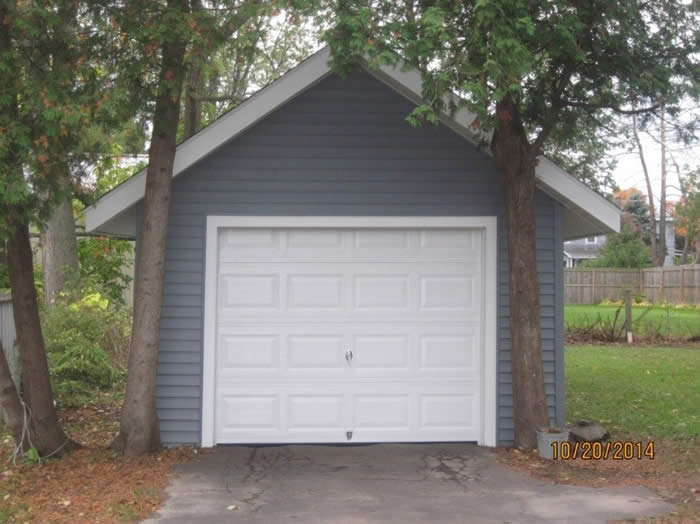
- Cute little house, garage located in the back
 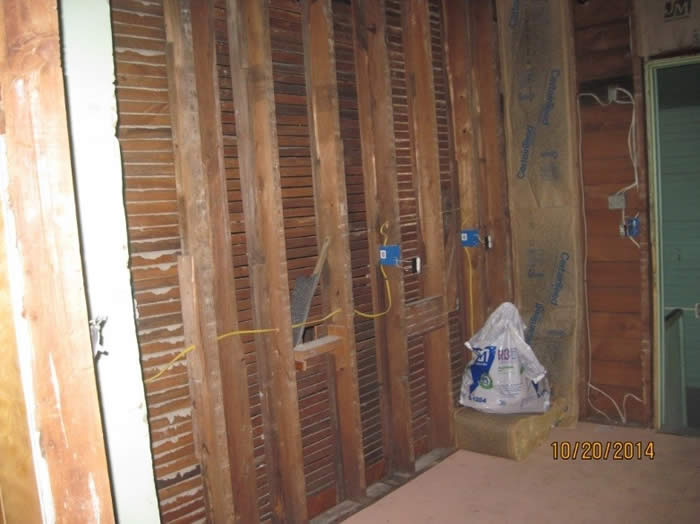
- Used lead money, may make a little money; gutted, added new wiring, will insult and sheetrock, should be ready to sell shortly
Tax Sale 2012
Town of Onondaga
4179 Griffin Rd
 
-
Home from 2 years ago shows what they get into at times, located Onondaga Hill, former garage on the left garage was converted to family room, risk of tax sales - garage wall was collapsing, had to pull garage on left out
 
-
Put garage back where it was before, had bedroom downstairs and 2 upstairs, sold, nice lot, nice view 1.5 acre lawn beautiful spot; never know what they are going to get into with tax deals
Payments 4179 Griffin Road
CLAIMDATE |
AMOUNT |
BUSNAME |
12/31/2012 |
750.00 |
Christopherson Land Surveying |
12/31/2012 |
608.00 |
Independent Title Agency LLC |
1/9/2013 |
3,743.53 |
County Taxes |
3/12/2013 |
280.00 |
Ecospect Inc |
5/6/2013 |
30,000.00 |
Filips Home Remodeling |
5/29/2013 |
25,000.00 |
Filips Home Remodeling |
10/29/2013 |
20,000.00 |
Filips Home Remodeling |
11/25/2013 |
330.00 |
John P Owens |
11/26/2013 |
75.00 |
Environmental Hazards Services LLC |
1/8/2014 |
3.21 |
County Taxes |
4/24/2014 |
36,470.00 |
Filips Home Remodeling |
6/4/2014 |
150.00 |
Chicago Title Insurance Co |
6/30/2014 |
350.00 |
Christopherson Land Surveying |
$117,760. Total Payments
Property sold on 7/17/2014 for $118,000
Profit: $240
- Frugal spending, try to break even
Mr. Knapp asked if there were restrictions, on whom the homes could be sold to. Mr. DeMore said there are restrictions pertaining to income, low to moderate. Ms. Grossman added that for a family of 4 it is around $54,000. In answer to Mr. Knapp, Mr. DeMore said that buyer is financing at a lesser amount; Community Development holds a second mortgage for $30,000, which they don’t pay on. They work with Geddes, Seneca Federal and are trying to get Solvay Bank involved for financing, as it is easier with smaller banks; give credits on closing costs and interest rates. They work with all banks and credit unions, but find it easier to work with those three; buyer determines bank used.
Tax Sale 2012
Town of Onondaga
159 Meredith Avenue
 
- Located in Nedrow, removed ramp
 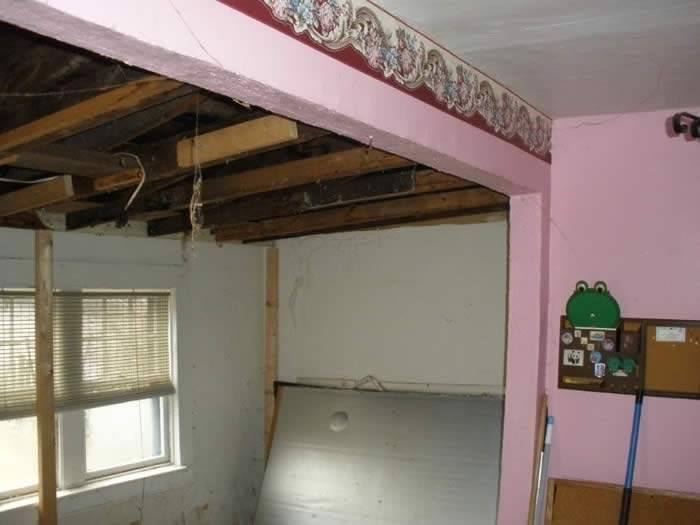
-
Back of home had small addition, wasn’t attached correctly and falling off, probably should have tried to fix it but removed it and added a deck which made kitchen smaller, sold, small house but nice
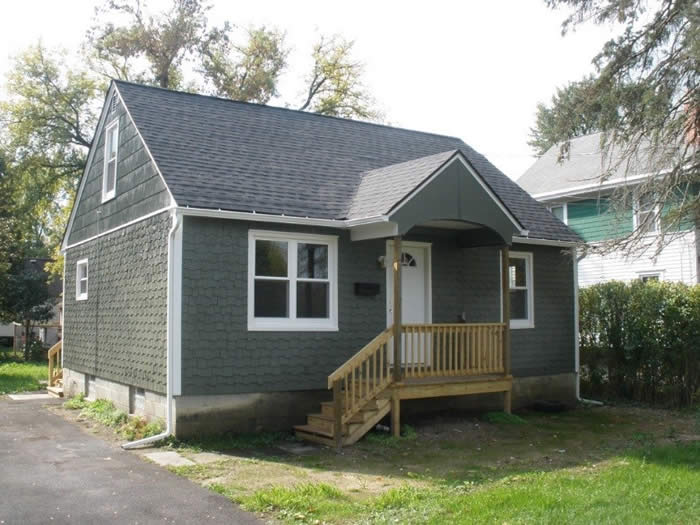 
 
Private Party Purchase
220 Orchard Avenue
Town of Onondaga
 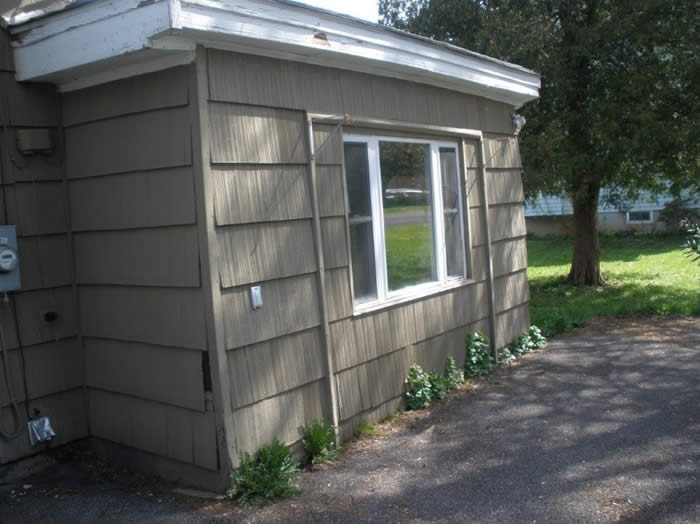
-
Even when able to look at a house don’t always know what you’re getting, home located in Nedrow, purchased for $30,000 spring of 2014, right side was garage converted to family room
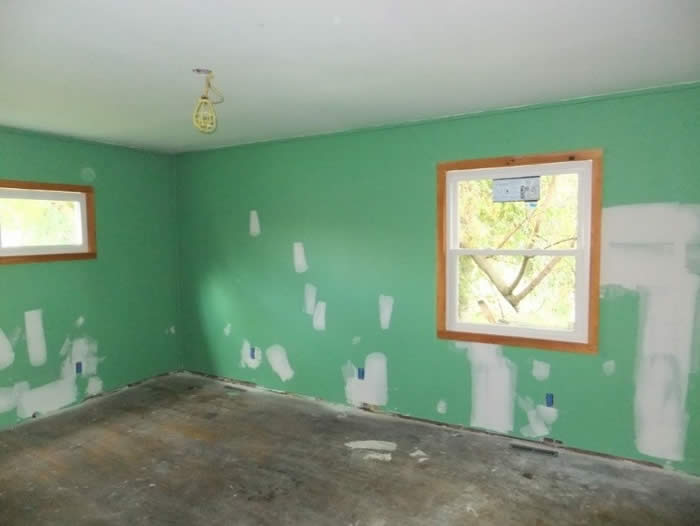 
-
Planned to convert family room into 2 bedrooms, smell was unbelievable, removed flooring, found they never put in foundation just laid rafters over tarred driveway
 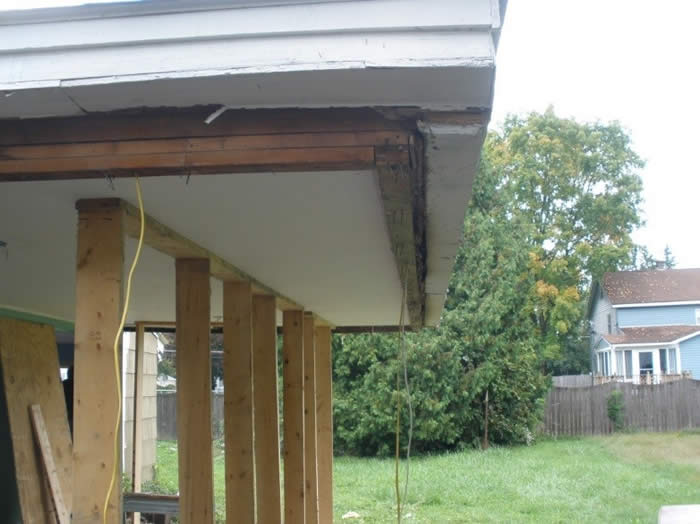
- Had to tear it all apart, couldn’t tell this until they go into
 
- Living room with new windows, added new carpet
 
- Will break even or make a little
-
Works with Mr. Weber from tax department and tracks houses that may go to auction; looked at 4 houses yesterday, inspectors looking at houses today
-
Taxes can be paid before the auction and the home is removed from the list, can’t choose houses now, don’t know what will be available; would like authorization to buy 5 or 6 houses, plus vacant lot, will present to Ways & Means on Monday, still won’t know which houses but will know on Tuesday; would like resolution voted on at November 3rd session - important to get into home before it freezes, much better off in November than December
Chair Rapp asked if the County was last in the processes, adding that if someone from the private sector wanted to buy the houses they wouldn’t want to bid against them, as they would then lose the tax revenue. Mr. DeMore said that this was a choice they had to make and provided a chart (see next page), which shows how their properties fared compared to private sales. Chair Rapp is correct, they do lose the tax money when they transfer houses to Community Development but in the end, their assessments fare much better. No one in the private sector would be able to fix the houses the way they do and return them to a higher tax base; just doesn’t happen. Often people buy these places, get them cheap, put a little into them and may sell them but they don’t improve the house. The small amount of tax money they are losing would not be a good investment compared to what Community Development can do. Again, someone could not fix the house in Nedrow or Delphi Falls the way they did. Chair Rapp said they would lose.

In answer to Chair Rapp, Mr. DeMore confirmed that he would pull the houses from the auction on Monday, but the owner can still pay off the taxes before the auction.
Chair Rapp asked what happens if someone comes to the auction and wants the houses that he has chosen. Mr. DeMore asked if she was speaking of a private person. Chair Rapp said that he remembers Mr. Stanczyk and “cherry picking”. Mr. DeMore said that they could see he is not “cherry picking”. Homes he chooses would be removed from the auction list. Chair Rapp said that people look at the house ahead of time. Mr. DeMore said that was correct but the list gets smaller every day and they wouldn’t know if the house went to him or if the homeowner paid off the taxes. Chairman McMahon said that the other advantage is that Mr. DeMore is going to sell the house to owner occupants. He is taking a neighbor-blighted asset and temporarily removing it from the tax role and controlling the ownership. Most people that go to the auction are more or less investor owners and probably won’t fix up the houses to this degree. He believes that what Mr. DeMore does is great. If he breaks even on deal it is a win, it is true community development and a good job. Chair Rapp said that she understands this and her district has been a beneficiary of this, it has been wonderful. Mr. Knapp added that a private developer couldn’t just breakeven; they have to make a living. Mr. DeMore said that it was not feasible they just cannot do it.
In answer to Chair Rapp, Mr. DeMore confirmed that he would like the resolution moved forward to Ways and Means and voted on at the November Session, and would provide information on the houses they picked up, but couldn’t tell them today. Mr. Knapp said that this could change tomorrow.
Chair Rapp moved the item forward to Ways and Means.
Chair Rapp took the agenda out of order.
5. b. Amending the 2014 County Budget to Accept Funds in Support of the Western Onondaga Lake Revitalization Effort, and Authorizing the County Executive to Enter Into Agreements ($30,000,000) (Sponsored by Mr. McMahon)
Chair McMahon:
-
$30M state grant for Western Shore Revitalization Project; addresses topics to be funded, includes Bridge Street Project, Milton Avenue Project, senior housing redevelopment, Milton Ave redevelopment, deconstruction for blighted properties, residential loan components for homeowners, brownfield remediation credit, and other village infrastructure issues
-
Still a number of moving parts, bids are still out for some of the projects, don’t want to identify the dollar figure before the bids come back or would be guaranteeing bid comes back at that dollar amount
Chair Rapp asked when the bids were due. Chairman McMahon said that some haven’t started yet; are working through Bridge Street and Milton Avenue.
-
Resolution places $27M in the Economic Development Incentive Fund, of which 2 members of this committee are on, and earmarks what can be spent, another item is wastewater issues for northern towns
-
Economic Development Fund would look at the budget as the bids come through, make recommendations and the projects would be done
-
$3M piece is for the Onondaga County Neighborhood Initiative for the residential loan component, no reason to put into Economic Development Fund, already have program set up, will be Phase 2, already dealt with Phase 1 and appropriated the numbers
- essentially how the dollars will be distributed
Chair Rapp asked if they have had any action with the Neighborhood Initiative. Chairman McMahon said they are waiting for the kickoff; Law has to work through a couple issues. He spoke to Ms. Tarolli today and said that if Law cannot fix some of the issues that have been stalling this; it is a major problem for them to move forward with a lot of this legislation. Chair Rapp said that she has sent people over. Chairman McMahon said that Kerry Quaglia has told him the Chair Rapp is probably the greatest marketing tool for the program as he has about eight homeowners that have come to him from Chair Rapp. They are waiting to get started. Law has been working with Purchasing, not sure what the holdup is but Ms. Tarolli has promised to have it fixed by days end.
Chair Rapp said that they haven’t seen or read this.
Mr. Corl asked how he though the wastewater treatment issues for the northern towns would play out. Chairman McMahon said that currently Legislatures have been trying to work on projects that would buildup capacity for strategic development opportunities. This line item is a usage of the funds so that once plans are solidified on what is, with some of the projects that Mr. Corl and Chair Rapp have been working on, he believes the committee could then appropriate the necessary funds to make those projects a reality. When looking at a public/private partnership they don’t want to tell the private partner the dollar figure available, when they may be willing to put more money into the partnership; one of the things that needs to mature a little bit.
In answer to Chair Rapp, Chairman McMahon said that the resolutions would accept the funds from the state, appropriate them to the Economic Development Incentive Fund, which would be required to use the funds on the topics listed. Chair Rapp said that $3 million would go the Neighborhood Initiative and $27,000 would be broken down in some way among the topics listed; depending on the how the bids come back. Chairman McMahon added, and conversations with the private partners. Chair Rapp added, and to make sure that all of these things are addressed within the $27 million. Chairman McMahon said that this was correct.
Chair Rapp asked of the committee was comfortable with this. In answer to Mr. Knapp, Chairman McMahon said that the oversight committee would break down the $27 million and will have a meeting to change the rules for this project; rules would be only four voting members and would need a majority of three to advance anything. In answer to Chair Rapp, Chairman McMahon said that David Knapp, Jim Corl, Travis Glazier and Ben Dublin are on the members. Mr. Knapp added that Julie Cerio would be the coordinator.
A motion was made by Mr. Knapp, seconded by Mr. Corl to approve this item. Passed unanimously; MOTION CARRIED.
4. INFORMATION TECHNOLOGY: William Fisher, Deputy County Executive
a. INFORMATIONAL: Authorizing an Intermunicipal Agreement with the City of Syracuse Regarding the Provision of Services for PeopleSoft Financials and Hyperion Software Systems and Amending the 2014 Budget ($125,000)
Mr. Fisher:
- Described a little during Mr. Sexton’s budget presentation; Intermunicipal agreement with City of Syracuse for work they would like the County to do
- No appropriation of dollars, would generate revenue up to $125k from the City, paying for services provided; no revenue guarantee but guarantee work provided will be paid in full, no obligation for the County to spend more than $125k
- Straight forward contract –
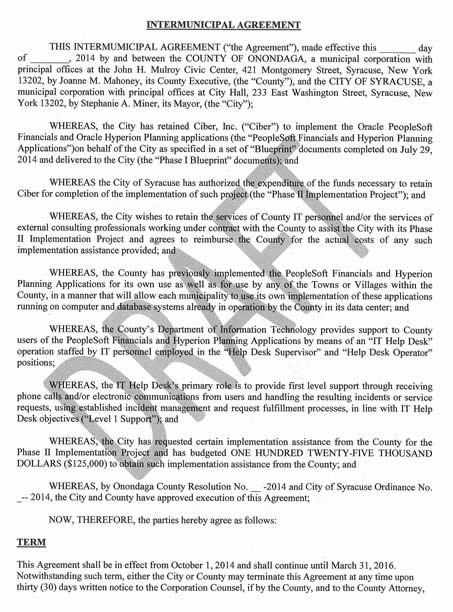 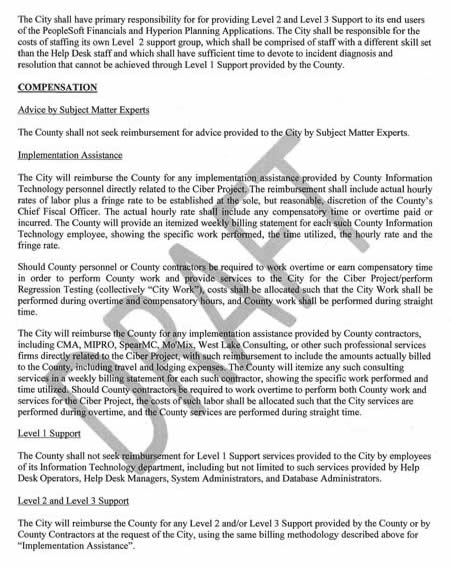
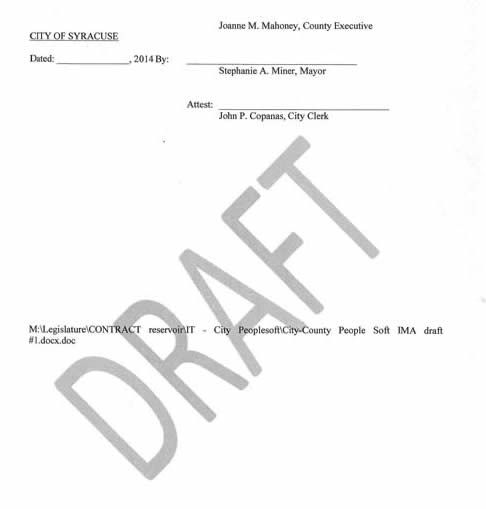
- Scope of services - PeopleSoft used as County financial system; number of people in various departments’ i.e. Comptroller, Finance, County Executive that are “Subject Matter Experts” and can give advice to the City but aren’t required to do so, not billable
- Implementation assistance billable, changes system to work differently, City has different business processes
Chair Rapp asked why the City wouldn’t change their system to match the County. Mr. Fisher, i.e. Comptroller has always had index codes, simplifies things, instead of entering the fund, department, and project, groups the three items into one speed type and people entering a requisition simply enter the speed type. The City would rather not have this customization and will enter the fund, department and project. By in large the system runs the way it was delivered but where the Comptroller’s office wanted customization it works differently. If the City wants that customization undone, because their system runs differently, they will pay the costs to remove the customization. In answer to Chair Rapp, Mr. Fisher said that the systems would run simultaneously, they are on the same hardware and are in the same database. From a security standpoint, each entity will see their own data only. However, the City doesn’t want some of the customized user interfaces and the County will charge them to change it back to the default. Chair Rapp said that they have their own programs and cloud folder on the County system. Mr. Fisher said that this was a good way to think about it.
- City hired consulting firm, budgeted $1.5M to get themselves running on County system; realized County consultants would have do work
In answer to Chair Rapp, Mr. Fisher confirmed that the agreement assures that the County would be compensated for anything paid out on the City’s behalf. If the City goes over $125,000, the County will stop work and the City will have to put more money into this contract. The contract lasts until March 31, 2016, but they will stop doing work a week or two before they run out of money.
In answer to Chair Rapp, Mr. Fisher confirmed that they would pay as they go, billed twice a month. They also have a program manager that all requests must go through. His time is billable and he will be reporting to the IT department and the County Executive’s office on a weekly basis letting them know where things stand.
In answer to Chair Rapp, Mr. Fisher confirmed that this was a cost savings for City as opposed to doing what the County did on their own. Chair Rapp added that when the County bought PeopleSoft they also bought licenses for all County towns and villages, but they would not add the City for that same price. If towns and villages want to become part of the system, they could do so. Mr. Fisher said that once the City is running they will see the concept and it if is working for the City there should be no question on their ability to do this for towns and villages. Chair Rapp said that the agreement was basically just a contract for service. Mr. Fisher agreed.
Mr. Corl asked if this would be County IT personnel. Mr. Fisher responded that some would be IT personnel and some would be consultants under contract and onsite doing work for the County; would bill City for any work done on their behalf. Mr. Corl said that in his experience, County IT personnel have their hands full and his concern is stretching them thinner. The County Clerk has been having significant problems and he experienced this last week; took forever to file a recorded document, doesn’t know if this is a separate issue. Mr. Fisher said that this is a separate issue but it is the same department and he believes that Mr. Sexton will be coming to the Legislature next month to talk about contingency funds set up for next year’s budget. Chairman McMahon wanted the Clerk’s issues addressed and they will be prepared to address them. The people that built the system for the Clerk are not the people that are running the PeopleSoft system, are completely different groups within IT but management would have to look over both projects. Mr. Corl said that he did not want to spread anyone too thin when their own in-house issues. Mr. Knapp agreed. Mr. Sexton said that they have had issues with the Clerk’s office but have their best people working to resolve this issue.
Mr. Knapp asked if this application was to help on the purchasing side or the budget side. Mr. Fisher:
-
County creates budgets in Hyperion, then loads into PeopleSoft, run requisitions, purchase orders, checks, and produces financial statements through PeopleSoft, City will be doing all of this also
-
Purchasing department has been issuing purchase orders for the City in a different system; one efficiency is everyone in the Purchasing department will be running the same system
Mr. Knapp said that the County handles purchasing for the City and the City School District. Mr. Fisher responded that he believes this was put into contingency so it is potential. From a purchasing perspective, they buy certain things for the City School District but they still have purchasing personnel. Mr. Knapp said that he was going there next, as it stands today, they do many things for the City School District and asked if the County does all the purchasing for the City. Mr. Fisher said that the City reserved the right to do professional service agreements and other RFP’s and has one person left in their Purchasing department. In answer to Mr. Knapp, Mr. Fisher said that this would make the County Purchasing departments life easier. Mr. Knapp said that once the three individuals from the City School District come over to the County that will be pretty much be everything for the District, minus some professional service agreements or something like this. Mr. Fisher agreed. Mr. Knapp said that this would place everyone on the same “sheet of music” so to speak.
Mr. Corl asked the hourly rate. Mr. Fisher said that it would depend, they have consultants that are anywhere from the low 100’s to the high 100’s and the County rates are based on the position. The City will pay for the actual rate, any overtime premium and a fringe rate on top of the base; all costs to the County would be covered by the City. Mr. Corl asked if they would be provided with a copy of the rate schedule. Mr. Fisher said that the agreement states that the County CFO will determine the fringe rate. They don’t know which people will be required to do work, when they work they the City will be billed and accept Mr. Morgan’s determination of the fringe rate.
A motion was made by Mr. Knapp, seconded by Mr. Liedka to approve this item. Passes unanimously; MOTION CARRIED.
5. WESTERN ONONDAGA LAKE REVITALIZATION: Mary Beth Primo, Deputy County Executive/Physical Services; Bob Duclos, Vice President C&S Companies
a. A Local Law Authorizing Lease of County Property to Syracuse SMSA Limited Partnership for a Distributed Antennae System as Part of the Lakeview Amphitheater Project (Sponsored by Mr. McMahon)
Ms. Primo:
-
Verizon proposed creating better connectivity at amphitheater site, huge benefit to County, won’t pay for Verizon infrastructure; increased connectivity beneficial to all at the amphitheater, i.e. employees, emergency responders, patrons, entertainers
- Lease allows Verizon to install, operate and maintain their equipment
In answer to Chair Rapp, Ms. Primo stated that they wouldn’t be building a tower. It would primarily be located underground, underground conduit fibers.
- County to construct concrete slab for Verizon, Verizon will construct small building on top of slab to house equipment
-
5 year lease with 4 options to renew 5 year period (*term revised see below)
-
Per lease Verizon agrees to be neutral host of the equipment, allowing other service provides use of equipment at reasonable cost, i.e. AT&T; reasonable cost relative to Verizon’s costs for installing equipment
Mr. Duclos:
-
Several million dollars’ worth of equipment installed at Verizon’s expense, commonly done in large scale venues, i.e. Carrier Dome; primary reason - proliferation of wireless requires strong infrastructure to service high demand
-
Will blend into the facade
-
Benefit - no supplementary construction or digging, won’t ruin work already done by the County, very desirable to have Verizon interested in doing this while planning and construction of the amphitheater is taking place
Chair Rapp asked if there was a business benefit to having all this installation by Verizon if the amphitheater never gets off the ground. Mr. Duclos said that there would be no installation required if there was no amphitheater project. Chair Rapp asked if the two were tied to one another. Ms. Primo said that she does not think that Verizon would want to install all of this equipment without the amphitheater. Mr. Liedka provided an example - several years ago the dome pushed an idea that people would wirelessly order food from their seat and it crashed Verizon’s service in that area. The next game they had a huge temporary trailer, then they installed a permanent facility similar to this. This is necessary for them to provide the level of service they need for the people that use it. It would serve no purpose to be there if there weren’t 16,000 people. Mr. Knapp asked if the state fair would benefit. Chair Rapp said that she was wondering about down south where there is a void of cell service. Mr. Knapp said that Verizon upgraded their facilities for the LaFayette Apple Festival because it was crashing their network and it worked out well this year.
Mr. Duclos said that as part of this agreement, and another benefit, Verizon would be putting in new fiber optic service all the way back to amphitheater project. The County would be able to use the fiber optic cable, brought in and paid for by Verizon, for outside access to the world or internet, i.e. streaming concerts. For outside connectivity, the County would be able to utilize the infrastructure. Chair Rapp added that there is no cost to the County. Ms. Primo said that there is negligible costs as they are going to pour a concrete foundation.
Ms. Primp said the Verizon would be using electric at the site and would reimburse the County for the costs incurred on their behalf.
*Ms. Primo said that Ms. Tarolli just informed her that the lease is changing; the initial term will be 10 years with three options for 5-year renewals.
Chair Rapp said that they have heard a lot about construction on this site and asked if just pouring a concrete pad was going to work. Mr. Duclos said that the County would be pouring the concrete pad because of the site conditions and the special procedures that need to be followed. Verizon preferred not to do any underground construction. Chair Rapp said that this could be an expensive pad. Mr. Duclos said that with regard to the overall project the costs are minimal compared to many of the other things that would be done for the project. This is something that the County is doing to facilitate the agreement with Verizon. In answer to Chair Rapp, Ms. Primo confirmed that the pad would come out of the $50 million and would be included in the project costs. Chair Rapp said that if the project doesn’t go through, none of this would go through. Ms. Primo agreed, adding that she did not know if there was a provision in the lease. Ms. Tarolli said that they wouldn’t sign the lease. Ms. Primo added, until they have a project.
Mr. Knapp said that this is wonderful and will make the venue that much more attractive but wondered what was in it for Verizon. This is a million dollar facility and they don’t just throw a million dollars around. Mr. Duclos said that they actually do. Sean Carroll asked those questions very early. Verizon establishes capital budgets yearly to support funding infrastructure projects like this but the short answer is that they are solely doing this for the purpose of making sure that their wireless network can adequately support their customers. Whether at the Apple Festival or the Dome, if their service crashes it reflects poorly on them and this is their primary motivation for doing this. At the State Fair they set up many temporary wireless towers to support the people that go there and if they didn’t have them the network would succumb to all the primary usage.
Chair Rapp asked if an ancillary benefit would be that the State Fair would also operate from this. Mr. Duclos said that this is a targeted network for the amphitheater venue. The antenna would be pointed in a certain direction to provide coverage of the parklands around the amphitheater and wouldn’t carryover to the State Fair because then they would be looking at towers and things of that nature. In answer to Chair Rapp, Mr. Duclos said that houses nearby would not be able to tap into the fiber, it is solely for the amphitheater venue.
Ms. Primo said that Verizon is not the only company that does these types of projects and she believes that Verizon and AT&T have an agreement carving out geographically areas for each to develop and share. They all recognize that this is important for their business operations. Mr. Liedka said that 16,000 people sending a bunch of pictures drives up their data and they make money from that.
A motion was made by Mr. Liedka to approve this item.
In answer to Mr. Knapp, Ms. Primo said that they are voting on a local law authorizing the lease.
Seconded by Mr. Knapp.
Mrs. Stanczyk said that the local law they are voting on is not the local law that would be presented, as the lease terms are different. Ms. Tarolli said that they would correct them. Ms. Primo said that this item has the term at 5 years with four 5 year options but what they really want them to authorize is an initially lease of 10 years with three 5 year options.
A motion was made by Mr. Liedka, seconded by Mr. Knapp to amend the lease terms to 10 years with three renewal options of 5 years and approve the item as amended. Passed unanimously; MOTION CARRIED.
c. Accepting the Results of a Project Labor Agreement Study Related to the Construction of the Lakeview Amphitheater
Ms. Primo:
- Hired consultant (Tim Seeler – Seeler Engineering, P.C.), helped negotiate and perform analysis of final PLA (Study on file with Clerk)
- Very involved process, requirement of design build legislation, PLA required for amphitheater project with design build project delivery system
Chair Rapp said that they previously approved the design build and the design build requires a PLA. Ms. Primo interjected saying that the Chairman asked that they present this item. Chair Rapp said that they are essentially voting to agree with the results of the study and asked why. Ms. Tarolli statement was inaudible. Ms. Primo said that the design build states they must have a PLA but a PLA cannot be used unless the Legislature agrees that study results indicate the PLA would benefit the County. In answer to Mr. Liedka, Ms. Primo said that the design build specifically says they must have a PLA. Chair Rapp that this was why she was a little confused and asked for clarification.
Ms. Primo said that now they want to look at the study and make sure that the PLA in place and analyzed by the consultant would benefit the County. Chair Rapp said that not every PLA is the same; each is negotiated based on the project. Ms. Primo said that she understands they are just considering this item today but the resolution isn’t authorizing the County Executive to sign the agreement, it is accepting the findings of the consultant and the analysis performed in which he says that this PLA will be beneficial to the County. Chair Rapp added that they would save money. In answer to Mr. Liedka, Ms. Primo said that this resolution requires the Legislature to accept the findings. Chair Rapp said that they understand that they had to have a PLA and are now concerned with the terms and conditions of the PLA. Ms. Primo said that the study would elicit whether or not the terms and conditions of employment for this project make since for the County.
Mr. Seeler joined the meeting via Skype. Ms. Primo informed Mr. Seeler of the discussion thus far and he agreed that before the County could use a PLA the Legislature had to accept the findings of the study, agreeing that the PLA would benefit the County with economic and other intangible benefits.
Ms. Primo:
-
Mr. Seeler is the expert, Sean Carroll also, Mr. Carroll worked with Mr. Seeler to negotiate the agreement; Mr. Carroll was out of town and Mr. Seeler couldn’t be there because of family health issues – planned to be there up until last night
-
PLA is an agreement between labor and prime contractor, will be design contractor on this project, establishes conditions and terms of employment; using PLA because of requirement of design build legislation, County isn’t party to the agreement
-
County very involved in negotiation terms because of direct effect on the County – affects the way work is done on major construction project; primary goal to control costs - prevailing wage required and ensure project moves along in efficient and effective manner
-
Some groups are not happy with PLA’s in general; County Comptroller audited PLA used for the lake project, about 15 different projects done over a period of time, audit not completely favorable but indicated PLA benefited the County by ensuring more local labor and businesses were involved than would have been without PLA; to be clear criticism of PLA was that potential cost savings described in agreement didn’t really pan out – however that project is totally different than this, project was difficult to get a handle on because of the number of different projects done over a long period of time, very difficult to figure hours of labor on the different projects, when that data was off the cost savings were off; overall audit was favorable for use of PLA’s
-
County wanted to achieve number of goals via agreement, reduce costs and stable work environment, wanted project to be economic driver for community, agreement terms prioritize use of local businesses and labor, provides opportunities for all sorts of companies and a wide spectrum of the workforce, recognize community has organized union and nonunion companies, organized labor and unaffiliated employment, wanted everyone to have opportunity to work on project - achieved these goals with this PLA
In answer to Ms. Primo, Mr. Seeler agreed that the PLA achieved the County’s goals.
Mr. Seeler:
-
Critical issue –can the agreement provide economic benefit, study demonstrates this via concessions offered through negotiation process, i.e. increased productivity - longer work day allowance without premiums, some work rules allowing labor management of the project – essentially components not available outside of a PLA with prevailing wage; negotiating team successful in getting these concessions
Ms. Primo:
- Prevailing wage rate must be used for the project, wanted to mitigate its effect on the project
- Negotiated 10 hour work days, 2 additional hours aren’t charged overtime rate, working 4 10-hour days; helps mitigate prevailing wage affect, creates more efficient construction process as portion of hours is setup and takedown
Mr. Knapp said that this is something highway departments do all summer long because it makes them more efficient. Ms. Primo said that the point she was trying to make is that PLA’s are not all the same and many PLA’s just allow for an 8-hour workday.
Mr. Seeler:
-
Negotiated paid holidays out of the PLA, reducing labor costs of prevailing wage to the project
-
Reduced premiums for 2nd shift or additional shift rates, significant hours on 2nd shift to complete project on time; premiums very greatly but average 15% of the base wage, negotiated reduction to 5%; cost savings spelled out in report
-
Elements not specifically spelled out are terms and conditions tailored to address small businesses, often nonunion, female owned or minority businesses, unique to CNY, 1st agreement able to negotiate these kinds of terms, very strong emphasis in negotiation per the County; defined small business by business volume, those falling within the volume are allowed different wage staffing, gives small business opportunity to bring more of their people to the job, also flexible way of paying for benefits which are mandated in by prevailing wage rate, can compensate people in way more reflective of their current business practices
Ms. Primo said for instance the tag along policy. Generally, nonunion companies or contractors must pick up union employees from the union hall. Mr. Seller said that this was correct. Most agreements spell out a percentage, often only about 12%, which is a very small and restrictive percentage of their workforce. In the broader since they were able to negotiate a 25% tag along for anyone, that does not qualify under the small or minority business conditions. However, they have been able to negotiate a 50/50 agreement so that their own staff would staff half of the project.
Mr. Seeler:
-
Not just the ratio, the way the project gets staffed, conditions allow small business opportunity to bring their own staff to the workforce first, standard tag along usually dictates union halls provide the 1st certain percentage of labor, followed by the staffing of the non-represented – in this instance they flipped that, structure provides family and small businesses opportunity to bring core employees to project first
-
Primary concern for small business – gathering staff they are unfamiliar with and perhaps reducing their productivity; not an issue for large contractors, core employees often applied to projects on an active basis and moved around effectively, will go to call list and bring individuals when needed for a particular project; personal call list alternative to union hiring hall
-
Receipts under $1M per year considered small business in this agreement
-
Concessions extracted through negotiation, hard negotiation, CNY trades not used to dealing with these terms, due to top priority of County were able to work terms into agreement; special recognition for small business, entire process designation has never appeared in agreement in CNY before
Ms. Primo asked if he meant the definition of small business being a million dollars in revenue. Mr. Seeler responded the specific parallel for small business, yes. Ms. Primo asked about some of the other terms, adding that the apprenticeship ratio to journeymen changed to reduce cost and help get others onto the job site. Mr. Seeler:
-
Couple of other very important terms; NYS law requires use of apprentice rate under prevailing wage, apprentice must come from rigid approved NYS level, many small business can’t afford to go through entire qualifying process and maintain consent certification, under standard PLA projects small businesses are limited in bringing young people in, are required to pay journeyman rate – a cost disadvantage; this PLA allows small businesses to request apprentices from individual trades, taking advantage of approved apprentice programs trades already have in place, provides opportunity for small business to bring younger/newer individuals on board and opportunity to bid in more cost effective manner by reflecting true cost of that labor onto the project, one of many important aspects of the project
-
Also important, language related to apprentice program, could reach into the community and staff with minority and women through formalized and structured recruitment and training program, agreement allows unions to bring 1st year apprentices to the project under their formal apprentice program, able to enhance workforce diversity without affecting cost of the project
Ms. Primo said that how benefits would be paid was a real point of contention for nonunion employees working for nonunion contractors. Mr. Seeler:
-
Important aspect of the agreement, prevailing wage rate requires anyone working in a rate job be paid specific amount of money in terms of benefits – reflects health and welfare payments, retirement and training, a number of things in that set amount; agreement allows existing contractors continued use of their benefit programs in place, employee gets value dictated by prevailing wage and maintains their benefit program; small businesses sometimes have only a portion of these benefits in a formalized program, i.e. 401K or health insurance plan, remaining money paid directly to individual, able to purchase in marketplace themselves
-
Difficult portion of negotiation, were successful in reflecting something characteristic of CNY marketplace
Ms. Primo said that this PLA created an open shop so that union and nonunion workforces can participate in the project, but this is unlike most PLA’s and asked if this was correct. Mr. Seeler said that PLA’s very, it is not uncommon that this is restricted but in the interest of PLA’s instituted in Upstate and Western NY these allow any contractor, regardless of affiliation, to participate in any aspect of the project.
Ms. Primo said that the County wanted to restrict the scope of the project and carve out work so that everything constructed on the project wasn’t subject to the PLA. Major roadwork, Verizon and concession work won’t be subject to the PLA; were able to carve out different aspects of the work and have narrowed the scope so that once the amphitheater is a completed project, nothing further on the site will be subject to a PLA. Mr. Seeler confirmed that this was correct.
-
Always 1st subject matter in negotiation - what is and is not included in the scope
-
Trades looking to gather as much work opportunity for their membership as possible, usually most contentious portion of a negotiation; some disappointment relative to how the scope was defined
- Use this tool to focus in on what is most effective for the project, defining scope in this way was part of that
Chair Rapp asked the percentage of the work carved out. Mr. Duclos said that somewhere between 80%-90% would be PLA. Transportation improvements and other items mentioned - audiovisual work, concessions, security and things of this nature would not be part of the PLA. Chair Rapp said that the PLA would primarily pertain to building the building. Mr. Duclos said the building infrastructure. Ms. Primo added that going forward anything that hasn’t been contemplated now would not be subject to a PLA.
Ms. Primo said that the potential project savings is 5% - 7%. Mr. Seeler:
-
5% - 7% of the cost of labor; clearly some cost advantages
-
Another item that does not show up, attempted to reflect in study line item Management Rights - 15 to 17 different bargaining agreements covering this work, that’s 15-17 different sets of rules governing how labor is applied to the job, managing project with this kind of complexity under those guidelines is challenging, management rights clause in agreement levels the field and establishes set of rules and operating conditions standardized for all, advantage to any contractor in terms of implementing work; another important aspect of what was negotiated
Mr. Duclos:
-
Use of the PLA dictated because of state legislation passed in June, gave Onondaga County the ability to construct amphitheater project through design build procurement methodology
-
Only two projects given this authorization in NYS - Tappan Zee Bridge and the amphitheater project
-
County able to take advantage of significant advantages by following design build procurement methodology with regard to quality, schedule and costs, provides flexibility not allowed in conventional bidding environment, i.e. absolutely selecting contractor based on lowest bid as compared to things like quality, past performance and things of that nature
-
Design build contractor and team part of the design team, better able to control costs during construction
-
$700,000 potential savings on labor outlined in report, in addition have all the other benefits afforded to the County as a result of being able to do the project under design build
Chair Rapp said that it was compelling to read the number of union contracts that were up for negotiation during the time when the amphitheater would be built, typically a time when there is leverage that can be managed - work shut down. Mr. Seeler said that Chair Rapp was correct. It is more than typical it is almost always the time when things get difficult so the opportunity to keep that issue off the table and out of the project is a significant value although they don’t attach a dollar savings to it.
1Mr. Liedka left the meeting.
Mr. Knapp asked if CNY has the number of people needed for this project. The last thing anyone wants to see is out of state license plates at the worksite, while some Central New Yorkers’ are sitting home. Mr. Seeler:
-
CNY has the labor force needed, question was part of the analysis, looked at labor loadings relative to percentages, particular numbers are never shared with them, trade secret proprietary number, reviewed labor loading anticipated and were assured it was staffable with local trade councils’
-
Note additional language attempts to staff the project with individuals within 50 mile radius, not a requirement but encourages this kind of staffing
-
Must continue to manage the process, mechanism in agreement for monitoring everyone’s commitments throughout duration of the project, opportunity to push back if things are getting off-track
- Certain they are capable of providing quality people needed from CNY
Mr. Corl asked that Mr. Seeler expand on the training component, adding that he feels this is important. Building an amphitheater is unique and if skills that are necessary from the local workforce, he believes there is a component in the agreement. Mr. Seeler:
-
Project contains clear aggressive objectives for workforce participation
-
Agreement spells out formalized mechanism for rapidly qualifying individuals into an apprentice program, quickly qualifying them and providing support necessary to get prequalified into training programs, once entered agreement allows for up to 50% of the apprentices coming to the project to be 1st year apprentices; can be significant number of new faces, is an allowance - not mandatory, allows contractor to make good decisions on completing work in a timely, safe and quality manner
-
Allows unions to bring new faces to the projects, has been very successful in Rochester, ongoing for 3-4 years, significantly changed the face of the workforce in a positive way without affecting time, quality or safety
-
Again a new aspect coming to CNY agreements; clearly working in Rochester region, with effort and cooperation can see significant success very quickly
Chair Rapp said that this is essentially getting people to work that might not have jobs. Mr. Seeler agreed and added:
- 2 groups specifically named or targeted in the agreement 1) minority and women workforce 2) military
-
Veteran’s returning home from military assignments are recognized and allowed special access to the project, couple this with ability to step into formalized training program allowing individuals to get prequalified, nice structure, allows new individuals that may not have a job an opportunity to participate in solid carrier path, opportunity to start
Chair Rapp thanked Mr. Seeler. Mr. Seeler apologized for the confusion and thanked them for their tolerance.
Ms. Primo asked if Mr. Lancette had anything further to add. Mr. Lancette:
-
Nice to have hired planning professional explain much of this, might seem a little bias coming from him
-
PLA’s are like snowflakes, all tailored differently based on scope of the project, timeframe for delivery and size; this PLA very moderate in that aspect
-
Onondaga County has been under ACJ agreement for 15 years, one of the older agreements, agreements prior - Carrier Dome, some of the Le Moyne College Campus and thing such as this; agreement County has heard about or dealt with is the ACJ
-
This PLA is most modern agreement in CNY, has components never achieved, newly formed components that allow them to tailor local hire; very tough to tone down the language even in a PLA because one can’t violate NYS competitive bid laws, provisions in agreement prevents the out of state license plates and provides carrier path opportunities to individuals trying to get into programs
-
Love the returning vet portion, some of the last demographics that work every day with little absenteeism, another win/win opportunity
-
Also allows small businesses without benefit programs to participate in their self-administered benefit plans that are 30-60 years old, at no cost to the employer if they choose to do so, gives them more choice, unique aspect
-
Training programs alluded to are apprenticeship programs funded 100% by the unions and training programs themselves, members self-fund, not publically funded, don’t have to plead for money for workforce development, some are 125 years old, are self-sustainable; funding mechanism comes in by hours worked on construction projects, members contribute to training which then trains the new workforce
Chair Rapp asked how long it would take for a military veteran, coming in cold, to work on the project. Mr. Lancette said that they could go in as a 1st year apprentice, i.e. plumber or steamfitter by trade. Working on the amphitheater would give them almost a one year and then they would need four more years of experience and class training to become a journeyman. In answer to Chair Rapp, Mr. Lancette confirmed that they could hire off the street and go straight into the program. Mr. Knapp said that the apprentice program was a very good program.
In answer to Chair Rapp, Mr. Lancette said that 25% of the workforce could be apprentices; it is usually 15% to 20% but of the 25% apprentice workforce half of them may be 1st year apprentices. They wouldn’t want to tip over this point too much. Chair Rapp said that she could appreciate that. Mr. Lancette said their pay is commensurate with their experience and skill set. Their pay is lower and the county experiences a savings but they also don’t have the knowledge base yet and they want this to be a long lasting project with the proper oversight and training for the apprentices.
Chair Rapp said that they weren’t going to vote on this today, as she doesn’t believe anyone received the information until this morning. Ms. Primo asked that anyone with questions let her know and she will get the answer for them. Chair Rapp said that her experience is that Mr. Lancette is available also. Mr. Lancette said that is available if they need him.
Chair Rapp thanked everyone for sitting through such a long meeting.
The meeting adjourned at 1:13 PM.
Respectfully submitted,

KATHERINE M. FRENCH, Deputy Clerk
Onondaga County Legislature
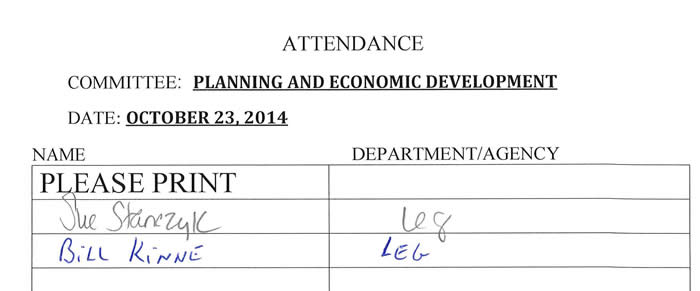
* * *
ENVIRONMENTAL PROTECTION COMMITTEE MINUTES - OCTOBER 24, 2014
MICHAEL E. PLOCHOCKI, CHAIRMAN
MEMBERS PRESENT: Mr. Corl, Dr. Chase, Mr. Shepard, 1Mrs. Rapp
ALSO ATTENDING: See attached list
Chairman Plochocki called the meeting to order at 9:05 AM. A motion was made by Dr. Chase, seconded by Mr. Shepard to waive the reading of the minutes of the previous committee. MOTION CARRIED. A motion was made by Dr. Chase, seconded by Mr. Shepard to approve the minutes of the previous committee. MOTION CARRIED.
1. WATER ENVIRONMENT PROTECTION: Tom Rhoads, P.E., Commissioner; Nick Capozza, Sewer Maintenance & Inspection Engineer; Michael Lannon, Deputy Commissioner
a. Resolution Calling for a Public Hearing in Connection with Proposed Improvements for the Onondaga County Sanitary District at the Baldwinsville Treatment Plant ($3,400,000)
Mr. Rhoads:
-
Capital project process requires Commissioner’s hearing, followed by Legislative public hearing; items 1a – 1e requesting Legislative public hearing
-
Back next month with bonding resolutions and project specifics
In answer to Dr. Chase, Chairman Plochocki said that they are just authorizing the public hearing to occur. They are not voting for or against the project. They will vote on the actual projects at next month’s committee meeting; not all questions need to be answered at this time.
1Mrs. Rapp arrived at the meeting.
- Mr. Capozza responsible for items relating to conveyances and pump stations; Mr. Lannon responsible for treatment plant works
- Fact sheets included with agenda provides basics
Mr. Rhoads said that they would speak briefly to each project. Chairman Plochocki said that he would prefer the more detailed discussion of projects take place next month. Mr. Rhoads said that if there were questions, they would be able to better prepare for next month and provide all the information Legislators are looking for because these are much needed and important projects. They would like to be responsive to any questions or concerns.
Chair Plochocki said that Mr. Capozza has the reputation for knowing where every sewer line in the CSD is, has it memorized in his head. Dr. Chase said that this was impressive. Chairman Plochocki said that he was only exaggerating slightly.
-
Baldwinsville WWTP has SPDES condition; SPDES is state pollution permitting system, DEC requiring new disinfection system, chlorinate and de-chlorinate
-
Must meet permit deadline
-
Some asset management – unable to get replacement parts for some pieces, 1982 plant not energy efficient, requires much maintenance, all things seen with 1982 car are seen with 1982 WWTP
Mr. Lannon:
-
Over 68% of assets are over 30 years old, a lot of original equipment, by time of construction equipment will be over 35 years old, absolutely need to replace
- Looking to enhance odor control, want to be good neighbors, noise abatement also
Chairman Plochocki said that while the plant needs updating what is really driving this project is the SPDES issue, which are state requirements. Much of this is bringing the plant into state mandated compliance. Mr. Rhoads agreed, adding that they have a hardline SPDES permit limit of May 2018. They need to go into the engineering and then construction afterwards to stay after this. Chairman Plochocki said that while they are doing this it makes since to complete the needed upgrades. Mr. Rhoads responded that he did not want to call them upgrades. They really have to replace significant assets or they will not be able to maintain compliance. They are at the end of life on many parts of this facility.
Mrs. Rapp asked if the projects were all being paid for via sewer use fees. Mr. Rhoads responded that until they get to the last one. This particular project is part of the consolidated sanitary district so they would borrow money and then the CSD unit charge would pay for the costs.
A motion was made by Dr. Chase, seconded by Mr. Shepard to approve this item. Passed unanimously; MOTION CARRIED.
b. Resolution Calling for a Public Hearing in Connection with Proposed Improvements for the Onondaga County Sanitary District for the Hiawatha Trunk Sewer Rehabilitation Project ($4,800,000)
Mr. Rhoads:
- Trunk sewer comes from the upper Northside of Syracuse, down Hiawatha to Solar, built in 1927
- Obstructions in sewer block and constrain flow, constraints affect ability for economic growth in the area
- Blockages on Solar Street piece release into Inner Harbor area, combined sewer overflow more frequent because of blockages
- Environmental and aging asset issue
Mr. Capozza:
- His job is to make sure wastewater is conveyed to WWTP’s for cleaning and treatment
- Photos included with fact sheet shows significant tuberculation – material leaching into pipe and causing restrictions like a block artery
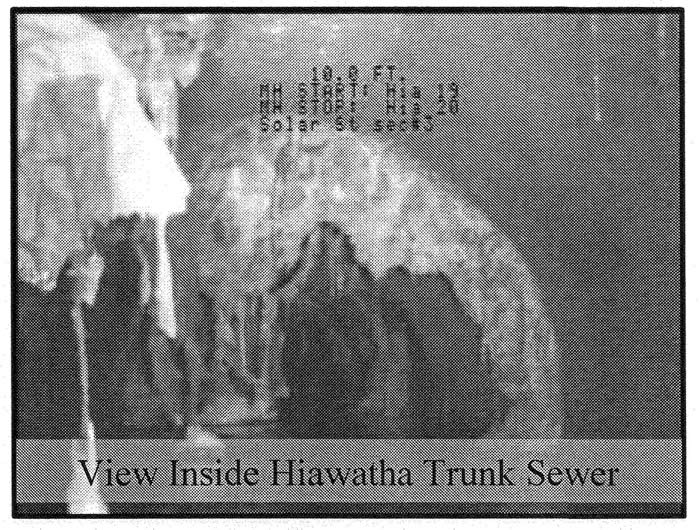 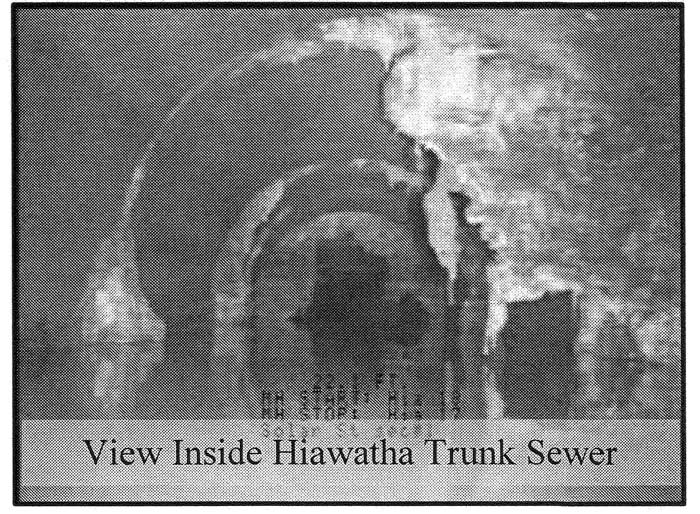
-
Former Oil City location with unique challenges, can’t just dig up and replace, will use newer technology – liner slipped through pipe, blown up with air and cooked with UV light to cure, provides new pipe that will last longer than anyone in the room, good environmental fix, restores capacity and provide for economic development in large CSO 74 service area
In answer to Mrs. Rapp, Mr. Capozza confirmed that the sewer would be cleaned out first and then they would drag the sock through and inflate it. They would have to bypass pump while the work was being done but they have already selected a contractor via bid and know what the pricing will be.
A motion was made by Mrs. Rapp, seconded by Dr. Chase to approve this item. Passed unanimously; MOTION CARRIED.
c. Resolution Calling for a Public Hearing in Connection with Proposed Improvements for the Onondaga County Sanitary District at the Ley Creek Pump Station ($5,480,000)
Mr. Rhoads:
- Largest pump station, previously was Ley Creek WWTP, converted into pump station
- Ageing asset issue
- Several flooding incidents, want additional flood protection for huge service area
Mr. Capozza:
-
1 of the oldest service areas in CSD, dates back to the 30’s as a separate sewer area, extends back to East Syracuse, encompasses most of the Town of Salina and Village of Liverpool, large portions of Dewitt and small portion of the City
- April 2011 thought facility was going to go underwater, only had ½” of water before electrical equipment got wet
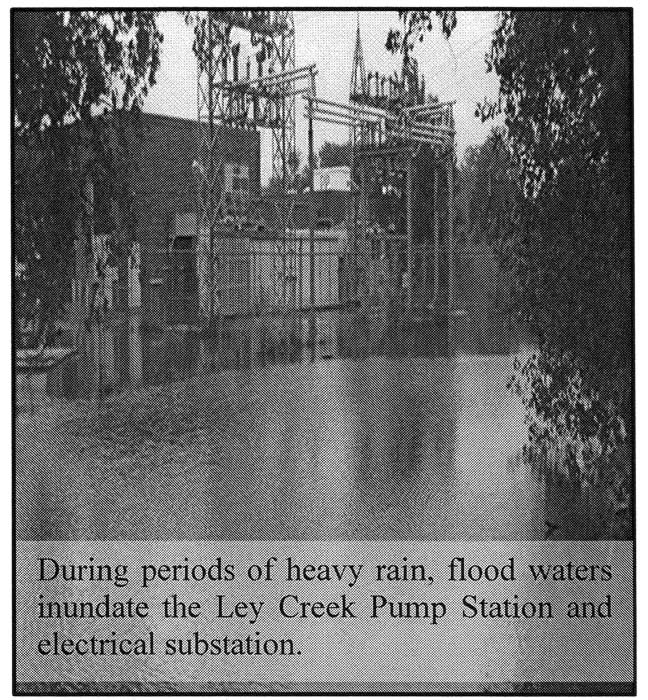 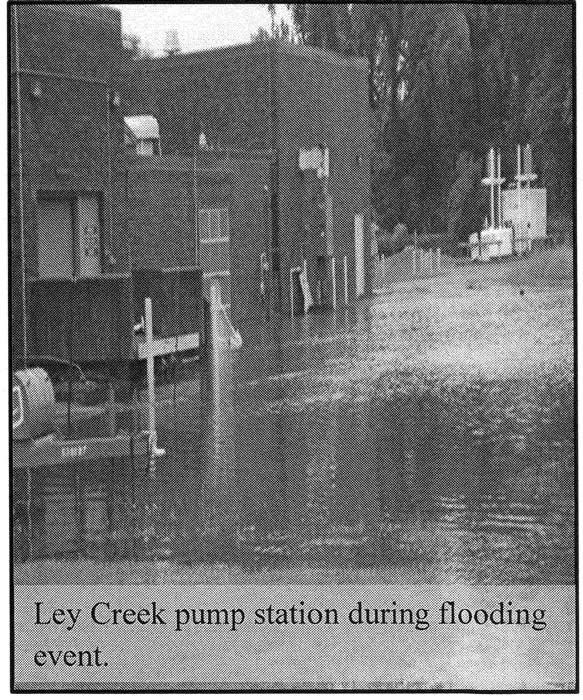
- Aging and critical asset issue
In answer to Mrs. Rapp, Mr. Capozza said that it is located on Ley Creek Drive, near the transfer station. Bear-Trap Creek and Ley Creek are right next to each other and during that April, they left their banks and actually converged on their property. He had to wade through waste deep water to get to one of the control rooms. They were bailing and if it didn’t stop raining, it would have probably been catastrophic.
- Also maintains capacity; much vacant land in eastern suburbs and Town of Salina at old industrial complexes ripe for redevelopment
Mr. Rhoads:
- Ley Creek exposed to a lot of I & I during wet weather events
-
1,000 horsepower pumps, largest pumps at largest pump station – really critical asset, potential for backups throughout big portion of the area if pump station went down
Mr. Capozza said that the low-lying areas would probably have significant damage.
A motion was made by Mrs. Rapp to approve this item.
Chairman Plochocki said that he believes the timing was just coincidental, but asked if this had anything to do with the DEC’s announcement regarding the mitigation of Ley Creek. Mr. Capozza confirmed that it was just coincidental, adding that this is an aging and critical asset for WEP. Chairman Plochocki said that it happens to be very good timing, he was just curious.
Seconded by Dr. Chase. Passed unanimously; MOTION CARRIED.
d. Resolution Calling for a Public Hearing in Connection with Proposed Improvements for the Onondaga County Sanitary District Related to the Relocation of the Westside Pump Station ($16,000,000)
Mr. Rhoads:
Chairman Plochocki said that the resolution, if approved, would be for $1.6 million.
- Station located behind Honeywell Visitors Center along Rt. 690; old brown building constructed in 1962
- 2nd largest asset on the pump station side; aging asset, are adding a lot of traffic to this area
- Unable to perform in wet weather conditions, frequent sanitary sewer overflows, important environmental issue
- Upgrade part of larger package on the Westside everyone has heard about
- Part of engineering goal - evaluate possibility of moving more waste flow out of Baldwinsville-Seneca Knolls service area and portions of Geddes, want to move more load to Metro and avoid paying for capacity at other treatment plants - by doing I & I work in Solvay, Geddes and Westside, and upgrading this pump station, hope to move more flow and take some of northern Geddes and Van Buren area and push into area that would then be Metro serviced
- Aging asset
Mr. Capozza:
- Located near State Fair Exit 7 off Rt. 690, pump station on the shore of Onondaga Lake, near visitor’s center
- Received 3 odor complaints from NYS DEC; completed some mitigation to work through this, credit staff for ability to think out of the box but pump station is older asset with limitations
Mrs. Rapp asked if they would rebuild or recharge the pump station. Mr. Capozza said that it would have to be rebuilt. Mr. Rhoads interjected saying that they are evaluating alternatives. As part of the engineering, they are looking at alternatives that might include relocation in that vicinity, evaluating reconstruction/replace and what the alternatives might be. In answer to Chair Rapp, Mr. Rhoads said that they have moving the location as a thought. Mrs. Rapp said that there a many things going on in that area. Mr. Rhoads reiterated that they are evaluating the different options and it is premature to say that they will move it. It is part of the feasibility analysis. Mrs. Rapp said that if they are going to rebuild the whole thing they might as well put it where they want it. Mr. Capozza said there is a cost for rebuilding the conveyances, the pipelines, the electrical and all the other large infrastructure that would have to be moved to get the water in and out of the facility. In addition, earlier this year the pump station was overwhelmed by flow, two pumps fail and damaged property on Freeman Avenue, water backed up at Chemtrade and the Law department is dealing with a large claim. They deal with these things every day and want to be able to remove extraneous flow from the system and increase the capacity so that these things don’t happen. They don’t want to be discharging raw sewage into Onondaga Lake under any circumstance, especially from a separate sanitary system. They would get another consent order and he is trying to get of two of them now. If he is able to off load them, hopefully they can proactively make this happen.
Mr. Corl asked when they anticipated the work for this particular project because as Mrs. Rapp said there is potential development in that area. Mr. Capozza:
-
Will go through lengthy analysis for appropriate site, look at pumping capacities and everything that goes along with that, then lengthy SEQRA process if location is moved
-
If not feasible to move, would build new pump station on same site, would include significant odor control facilities and significant aesthetics to make facility palatable for lakefront of Onondaga Lake; have done before, i.e. Clinton facility located on trolley lot, no one knows what the facility is, would rather put money into infrastructure and building than aesthetics - there is a balance
-
Design period about 1 year; O’Brien and Gere project engineer, have idea what it would look like, won’t be reinventing the wheel, just design enhancements and building off of existing projects
Mr. Rhoads:
-
Consultant selected, had cash in 906 capital account; to proceed with design need bonding, which would be about 1 year, then several regulatory approvals for project this size, also EFC funding approval
- Earliest build mid 2016; must come back for construction authorization, only approving public hearing for engineering
Mr. Capozza said that they are asking for $1.3 million. Mr. Rhoads added, of a $1.6 million project. Mr. Lannon said that they already have $300,000. Mr. Capozza said that the bonding would be for the balance of the $1.6 million, which is $1.3 million. Mr. Rhoads agreed.
Mr. Capozza:
- Relocation would require coming back to the Legislature for land taking – no small task
Mrs. Rapp asked where they would put this. Mr. Rhoads said that this would have to be discussed in executive session.
Chair Plochocki said that to be clear even though they are going to be voting on $1.6 million as amended, this project is part of the $100,000 million Western Shore Revitalization Project. This is the $15,000 million for sewer infrastructure, which was talked about at the hearings and shown on the slides, and is now going through this part of the process.
Chairman Plochocki said that part of the goal is to reroute many of the flows from the Baldwinsville – Lysander area. Generally, they would use pipes that are already in place from Baldwinsville to Geddes and asked if an excessive amount of pipes would have to be rebuilt for this. Mr. Capozza:
-
In initial stage of looking at this; looking for path of least resistance, cheapest and most feasible
-
Anheuser-Busch has historic pipeline, runs from Baldwinsville to Allied wastebed, originally thought it was a larger pipe and abandoned, found out Anheuser-Busch is planning on utilizing and repurposing pipe, doesn’t offer as much capacity as thought
- Looking at low hanging fruit to turn around some flow from Baldwinsville to southern Van Buren and Geddes area
Chairman Plochocki interjected saying that it was not up into Lysander, just the lower portion of Baldwinsville. Mr. Capozza said that he was correct but it would take off the burden, as it is all the same service area. They have looked at all the flows, it is not a ton but it does offer the economic benefits that they are looking for. The Penn Traffic facility is still essentially vacant and there is a lot of property out there with potential, i.e. Farrell Road area. They want to make sure they keep their options open and don’t have to tell people no because of capacity issues.
Chairman Plochocki said that he would ask his question a little bit differently. In broad strokes, he understands that there is no specific route, but are they talking about building a new pipe and digging a huge trench from Baldwinsville to Geddes or are they connecting or widening a trunk in Geddes to change the situation. Mr. Capozza addressed the map provided in the fact sheet. Mr. Rhoads noted that the committee did not have a color copy. Mr. Capozza distributed color copies to committee members.
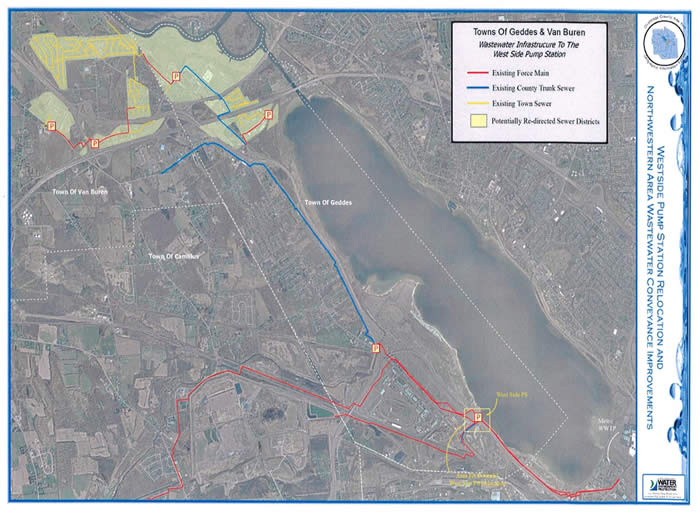
-
Blue line running along the lake has trunk sewer, runs from Quaker Steak and Lube, not quite this far but is the most notable landmark in the area, goes down along Rt. 690 to the West Side Pump Station, next to Daniella’s; trunk sewer has significant capacity for conveyance, consultants believe small improvements to that truck sewer would allow more water to move down through it
-
Would most likely turn around Farrell Road Pump Station, pumping to the Lakeside Pump, do basic upgrades to Lakeside Trunk and Lakeside Pump Station, would be a separate project
-
Are some opportunities; executive summary will have scoping costs
Mr. Rhoads said that engineering for this project would evaluate different feasibilities and they would then be able to answer specifics. Chairman Plochocki said that the color map was very helpful. It looks like there is a gap between the two systems west of Maple Bay. The northwestern shore of the lake area near Farrell Road is where the connection needs to occur and some sort of a new line would need to be built. He wanted to be make sure that something existed where the blue line is. They would be talking about a very different project if they were putting in a new truck all of the way but most of the infrastructure needed is in place. Mr. Capozza said that was correct, except for a pressure pipe at Farrell Road that would take the wastewater from the Baldwinsville service area, which is in green on the map. It would be rerouted and then become part of the Metro service area; build pressure pipe from Farrell Road to Lakeside Trunk, not easy but doable, requires crossing of NYS Thruway and part of Rt. 690 interchange.
Chairman Plochocki clarified that they are voting on a public hearing for $1.6 million in engineering costs, as amended. Mr. Rhoads said that the amount might have to be clarified sometime before session as to whether bond counsel wants the amount to be $1.3 million or $1.6 million.
Chairman Plochocki said that they are approving a public hearing for up to $1.6 million in engineering costs, amended from the $15 million listed on the resolution.
A motion was made by Dr. Chase, seconded by Mr. Corl to approve the item as amended. Passed unanimously; MOTION CARRIED.
e. Resolution Calling for a Public Hearing in Connection with Proposed Improvements for the Onondaga County Sanitary District Related to the Burnet Avenue Maintenance Garage ($500,000)
Mr. Rhoads said that this is not a sanitary district project. This is a flood district project for an interesting asset well beyond its life, a demolition project.
Mr. Capozza:
-
Another hat he wears - Flow Control, operates and maintains 4 flood districts: Bear Trap-Ley Creek, Meadowbrook, Bloody Brook & Harbor Brook; Bear Trap-Ley Creek is basically Town of Dewitt, portions of City of Syracuse and Town of Salina; they operate and maintain the channels
-
When district was formed in 1970’s County took over old Dewitt highway garage, morphed into combination facility, did some sanitary sewer work from there, shared facility, had to get out of there, was poor facility in the 1970’s, just used for storage, major disrepair, have been trying to get this on the docket for demolition
-
Hired engineer, will do some Phase 1 site assessment things and some Phase 2 site assessment including soil, asbestos, and lead sampling; vehicle maintenance done on property, has couple of in-floor lifts
-
Needs to be demolished, safety hazard and detriment, in disrepair, one of the worst facilities, haven’t been putting money into it, trying to mothball and keep standing until approval for demolition
In answer to Mrs. Rapp, Mr. Capozza said that the facility was located on Carr Street, near Bristol Meyer Squibb, drive past Bristol heading toward Erie Blvd, there is a small street on the side, and the building is located on the right-hand side, tucked back in. They also have a chemical feed system that occupies the same property. Dr. Chase said that if they were going down Burnet Avenue past Thompson Road this would be located on their right before they got to the bridge to get into East Syracuse. Mr. Capozza agreed. Mr. Rhoads said that if they remember where the recycling facility was that caught on fire this is how they used to get back to this, the small side street located on the south side of the railroad.
Mrs. Rapp questioned the cost a half million dollars to take it down. Mr. Rhoads said that they because of some of the vestiges of environmental, they wanted to make sure that they had enough funds to do appropriate cleanup. In answer to Mrs. Rapp, Mr. Capozza:
-
Building was part of 1970’s drainage district deal
-
History - district formed because of Hurricane Agnes, major flooding wiped out a number of properties along Ley Creek and Bear-Trap Creek, push to create draining district to improve condition and conveyance capacity of Ley Creek Channel
- Building was turned over as a convenience
Mrs. Rapp said that now they wouldn’t touch this building with a ten-foot pole. Mr. Capozza agreed saying that they absolutely would not:
-
In-floor lifts really concern him; used to do a lot of that work, anticipates that when the floor is excavated there will be an underground tank housing hydraulic fluid, depending the on soil conditions may just be there, could take a couple roll off dumpsters to High Acres or other landfill
-
Issue is if they have to do asbestos and lead paint remediation, and some soil disposal, could run costs up
Mr. Rhoads add, maybe some PCP’s. The engineers have to do a total prescreening and evaluation and they want to make sure that there are enough funds to manage and appropriately mitigate any environmental concerns during demolition. Mr. Corl asked if they had gotten any bids yet. Mr. Rhoads responded that the $500,000 would be for the demolition but they have not completed the engineering yet.
Chairman Plochocki said that he agreed with Mrs. Rapp, this seems like an awful lot to take down a building. He would like to think that a lot of building wouldn’t cost this much to buy, let alone demolish. With that being said, he understands the environmental concerns and certainly wouldn’t hold up the public hearing over that. They need to move forward at this point.
A motion was made by Mrs. Rapp, seconded by Dr. Chase to approve this item. Passed unanimously; MOTION CARRIED.
Chairman Plochocki thanked the presenters, adding that they would have further discussion next month on all of these items.
2. METROPOLITAN WATER BOARD: I. Holly Rosenthal, Executive Director
a. Authorizing a Public Hearing to Consider Recommendations of the Metropolitan Water Board to Amend the Currently Effective Schedule of Rates to be Charged for Water and Water Service Provided by the Onondaga County Water District
Ms. Rosenthal:
- Hopes they save tens of millions of dollars for MWB, will be looking for water treatment plant improvements in the near future
- Here today for public hearing for MWB rate change; now $.04 per thousand as opposed to $.13 per thousand requested
Chairman Plochocki said that everyone knows this issue very well from budget. As Ms. Rosenthal pointed out this is a much lower rate than originally proposed. Because of the level of detailed discussion received during budget, he does not know to what extend there are still questions but if there are, Ms. Rosenthal is here.
Mrs. Rapp asked how they would bridge the gap between the proposed increase and the increase authorized. Ms. Rosenthal:
-
Rate change was expected to cover increase in debt service, debt service still exists
-
Legislature cut back other operations and maintenance accounts to accommodate increase in debt service, impacted accounts are provision for capital projects, and maintenance, utilities and rents; evaluated how they can make this work and they will, if they need to come back they will
Dr. Chase asked how they were doing with getting other customers; is Phoenix going with them. Ms. Rosenthal said that they hadn’t heard any more from Phoenix. They reached out to consulting engineer and were told that they are still deliberating. They have met and given them all the information they need to make a decision. Keep in mind that a customer like Phoenix is perhaps $60,000 in revenue each year and will not bridge the gap for the additional million they are spending in debt service, over the next several years. Dr. Chase said that it is a start. Ms. Rosenthal agreed, adding that there is no down side to it. It is certainly the right course of action and they are enthusiastic about pursuing those kinds of revenue.
A motion was made by Mrs. Rapp, seconded by Mr. Shepard to approve this item. Passed unanimously; MOTION CARRIED.
3. LAKE IMPROVEMENT: Tom Rhoads, P.E., Commissioner
a. ACJ Update http://savetherain.us/category/reports/ (On file with Clerk)
Commissioner’s Report
-
3rd quarter report – strayed away from ACJ items for a few things
-
Applied for integrated planning grant, EPA term of art – how to manage all SPDES at 6 WWTP’s, all combined sewer projects, and MS4 stormwater items, create a framework so regulators have priorities in numerical order 1-23 instead of 23 priority projects
-
New mandates prioritized based upon environmental benefit to receiving waters and ability to fund
-
Integrated planning is not for planning consolidations of municipalities or sanitary districts, has a touch of municipal stuff because of MS4’s and storm water in MS4’s that goes into Onondaga Lake - it is how to prioritize things for the future
-
Many regulatory things coming down beyond chlorination and de-chlorination, which Mr. Lannon is dealing with at 5 of 6 permits; DEC warning of additional nutrient regulations on moving waters, not only nutrient issues with TMDL of ammonia and phosphorous in the lake, very likely to have TMDL for moving water, i.e. Seneca River
-
How to create a framework for all of those issues so that regulatory and stakeholders are engaged in the process
-
EPA providing technical assistance not cash, selected experts will be working hand in hand with WEP to develop the plan; Onondaga County 1 of 5 utilities nationwide to receive grant
In answer to Mrs. Rapp, Mr. Rhoads said that the grant was for $67,000 dollars’ worth of technical assistance.
-
No small thing, going on nationwide, EPA realizes many communities aren’t financially capable of dealing with environmental issues; pass a lot of regulations to improve water quality but don’t have the money to pay for it, quick to create new environmental laws but not quick at thinking about how to pay for them especially at the federal level, important regulation but needs to be a way to pay for it all
-
CSO 063 located in Emerson Street area of the City, on Solvay/Syracuse boarder; work will move whole combined sewer area into new Harbor Brook Storage which is operating very well, will provide additional utility for State Fair project; will see construction kicking off, if it hasn’t already
-
Not exactly ACJ item but worth note, had consent judgment for Floradale Road area in Salina; when backups occur because of sanitary sewer overflows and I & I events, where much precipitation and ground water gets into the sewer system the state steps in, have to spend serious dollars to resolve consent orders with timelines, consent orders cost more because of timeline
-
Ask that projects requested before consent order be approved whenever possible; believe projects done without consent order time pressures can be more cost effective
-
Just put in “golden” manhole cover for this consent order, project ongoing for over 9 years, long drawn-out process, highly regulated, Mr. Capozza has to give frequent periodic reports, does a very good job with what he does and he appreciates his efforts, real team win to get this across the finish line
Mrs. Rapp asked if this was the project, they were doing on Donlin Drive combined with Limestone. Mr. Capozza said that Donlin Drive was part of the big project but the triangle area of Martin, Limestone and Electronics Park was where they repurposed the old water main. The pump station is on line and is working great. One portion of that was to fix the sewer on Donlin Drive and the soil conditions were very pour over there. It was the most challenging piece of the entire project. Mrs. Rapp said that it went on forever and they are still there. Mr. Capozza agreed, adding that they should be done by the end of next week. They are just finishing restoration. Mrs. Rapp asked if this was where the golden manhole cover would go. Mr. Capozza said yes, they might do that. Mr. Rhoads added that it would spray paint. Mr. Capozza said that ultimately by next month they should have the state sign off on two consent orders, Floradale and the Electronics Park Viking order.
Gray Projects
-
Clinton and Harbor Brook storage now in contract performance period, working well, doing tremendous job keeping trash and other overflow materials out of receiving waters
-
Gotten smarter, only get to test weather facilities when there is significant wet weather, constructed contracts with 1 year performance period verses typical 14 day performance period; fact sheet shows where they are at
Green Projects
-
Couple of good projects going along – 1) Courts 4 Kids 2) Hughes Magnet School Vacant Lots; lots immediately adjacent to school property and owned by school property
-
Magnarelli Community Center, putting in green roof, part of IMA with City
Green Improvement Fund
-
Private portion of their projects; Ms. Quinn was part of maintenance program yesterday, gave maintenance tutorial to private property owners on how to maintain their green assets
-
GIF projects are improvements WEP pays a portion off, private property owners pay the balance and maintains them; cost effective cutting edge solution, big part of program, very satisfied with results
Metro WWTP Phosphorus
-
Just published 2013 AMP results; moving away from annual review and approval of program, created 5 year work plan with DEC, merged some work with Honeywell, reduced operating budget via shared monitoring and responsibilities; working to keep rates down, difficult process
-
Very satisfactory results, especially total phosphorus load, moving in right direction; summer phosphorus number just above guideline at 0.023 instead of 0.020, tremendous result
-
Can see results of all treatment, green and Save the Rain work being done via AMP results, use red, yellow and green to highlight, most results in green; return of cold water fish aspirational goal, may get there in the long term
Legislation & Media
-
Ms. Quinn provided tremendous amount of Legislative pieces; lake amphitheater project and everything revolving around it, now creating asset for the community – how will people enjoy it, lake cleanup a great part of that
-
DEC Commissioner looking forward to swimming across Onondaga Lake once weather is nice
In answer to Mrs. Rapp, Mr. Rhoads confirmed that the commissioner said he would swim in Onondaga Lake. Dr. Chase asked that they let them know when this was going to happen.
-
Remarkable recovery of the lake and what it has meant to the community, presented to broader audience via StormTV video, won national award for public education and effective public communication, short video about Save the Rain program, dynamic job of rethinking the way stormwater is managed, stormwater management projects become assets and help to rebuild communities
Financial Updates
- Every contract and all budgets included, very transparent
Chairman Plochocki said that they were still skimming through the report as an awful lot has gone on in the last three months. The amphitheater alone is enormous.
For the record, Chairman Plochocki provided the committee with two updates. Two days ago, he attended a very interesting presentation at Dewitt Town Hall. Many of the people from the town brought in a nationally recognized expert on business and environmental issues to speak (Neil Feldman). Part of the reason was to speak about the Ash for Trash deal but really, it was much larger than that. This particular expert was speaking about new ways of looking at recycling, refuse and those entire sort of things. It was fascinating and more than anything what stood out to Chairman Plochocki was that he was making the case that they are reaching a tipping point in the way waste is handled in this country. As ironic as it sounds, they are starting to see the value in waste. Are now at a point where just about everything in waste truly can be turned into something else, whether it is waste food items that are composted and turned into fertilizer, plastics that are returned back to the basics of being oil or what have you. Almost everything can have a use found in some way. However, Mr. Feldman stressed that that use is at a point where it is becoming truly economically feasible to do many of those things. The biggest problem until now has been that so many types of recycling are not cost effective, but that is starting to change with new technologies and the way new markets are being brought forward. Mr. Feldman really pushed them to think in terms of such things.
Chairman Plochocki said that he was not endorsing the fundamental aspect of his plan. Fundamentally Mr. Feldman was saying rethink the incinerator, rethink going forward, they don’t necessarily have to burn waste as the best and most cost effective way of getting rid of it and turning it into energy. He was saying there are other alternatives. At this juncture, given the many, many complexities of the Ash for Trash deal, Chairman Plochocki does not know that it is their best move to go in that direction right now but a very strong case was made that in terms of long term planning, the sort of things Mr. Feldman was talking about, Onondaga County should really consider. Chairman Plochocki said that he would encourage everyone to think about those things. There are minutes from the meeting, as he understands it, and some of them might find it interesting. He also heard that Mr. Feldman meet with the Legislature’s leadership afterwards.
Chairman Plochocki said that the other item he wanted to touch on was the review of the final impact statement for the amphitheater. Debatably, the most important vote they are taking this year will be the vote on the FEIS next week. The review of the FEIS is critical to what they do and he would encourage everyone over the next few days, to take the time and do some due diligence. If they haven’t already done so look through key parts, if not the entire document, time pending. Lastly, he wants everyone to keep in mind that they are voting on the FEIS. More than anything the FEIS is a procedural document. By that, he means that one could vote for the FEIS and still vote against the amphitheater and vice versa. He understands that normally someone that is against the amphitheater would tend to vote no for the FEIS and vice versa but what he wants to stress to everyone is that the FEIS is its own process. When they vote on the FEIS, they are confirming that a hard environmental look has been taken at the proposed building project, in this case the amphitheater, i.e. amphitheater by its very nature will cut down trees. The issue is not are trees going to be cut down, a virtual necessity with building project that trees will be cut down. The purpose of FEIS is to ask questions such as, if cutting down trees are they doing it in the least intrusive way – are they cutting down more trees than they need to or are they cutting down only the minimum necessary. Another consideration would be a rare species of tree, is there a way to build the project to protect that kind of species. Those are the kinds of questions handled in an FEIS. It is a question of, has proper due diligence been done and he would like everyone reviewing these things to keep this in the back of their minds.
The meeting was adjourned at 10:12 AM.
Respectfully submitted,

KATHERINE M. FRENCH, Deputy Clerk
Onondaga County Legislature
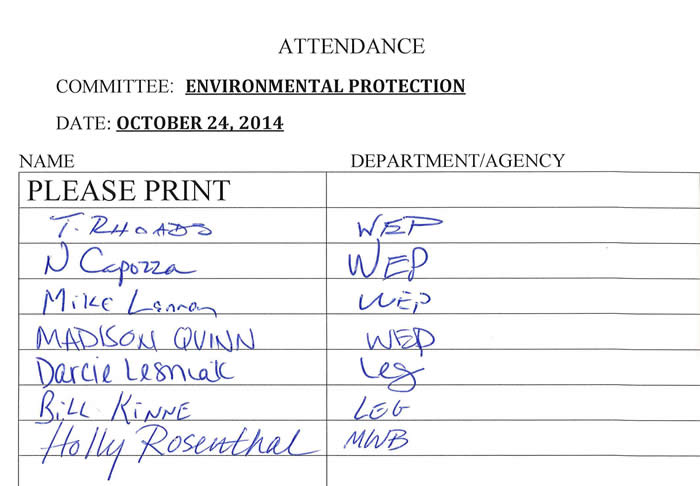
* * *
WAYS AND MEANS COMMITTEE MINUTES – OCTOBER 27, 2014
DAVID KNAPP, CHAIRMAN
MEMBERS PRESENT: Mr. Holmquist, 2Mr. Jordan, Mrs. Ervin, Ms. Williams,1Mr. Kilmartin
MEMBERS ABSENT: Mr. May
ALSO PRESENT: Dr. Chase, Chairman McMahon
Chairman Knapp called the meeting to order at 8:58 a.m. He noted that Legislator May sent his regrets, as he had a family medical matter to attend to this morning, but will try to get here later.
A motion was made by Mr. Kilmartin, seconded by Mrs. Erin to waive the reading of the minutes of the proceedings of the previous committee meeting. Passed unanimously; MOTION CARRIED. A motion was made by Mr. Kilmartin, seconded by Mrs. Ervin to approve the minutes of proceeding of the previous committees meeting. Passed unanimously; MOTION CARRIED.
CONSENT AGENDA
1. CENTERSTATE CEO:
a. Amending the 2014 County Budget to Make Funds Available for Distribution to CenterState Corporation for Economic Opportunity for its Regional Marketing Program ($25,000)
2. HEALTH:
a. Amending the 2014 County Budget to Appropriate Additional Funds Related to the Provision of Medical Examiner Services to Oneida County ($50,000)
3. FACILITIES MANAGEMENT:
a. Amending the 2014 County Budget to Make Funds Available for use in Making Repairs to the Roof Over the Civic Center Theaters ($300,000)
4. PARKS AND RECREATION:
a. Amending the 2014 County Budget to Provide Funding for Planning and Design Work Related to the Expansion at the Onondaga County Veterans Memorial Cemetery ($69,850)
Mr. Jordan had questions regarding item 5a on the Consent agenda. Chairman Knapp moved item 5a to the first item on the regular agenda.
A motion was made by Mrs. Ervin, seconded by Mr. Jordan, to approve item 1 – 4 on the consent agenda. Passed unanimously; MOTION CARRIED.
WAYS AND MEANS COMMITTEE REGULAR AGENDA
Item 5a from the consent agenda was then considered:
5. INFORMATION TECHNOLOGY:
a. Authorizing an Intermunicipal Agreement with the City of Syracuse Regarding the Provision of services for PeopleSoft Financials and Hyperion Software Systems and Amending the 2014 Budget ($125,000)
Mr. Jordan asked why the county isn’t seeing reimbursement for level 1 support services.
Mr. Fisher:
- Level one support – by calling x4750 in the county you reach the Help Desk – 2 people presently -- after Jan 1st will have 3 people
-
They can’t possibly answer all of the questions that people have – often will escalate it to someone else, or put into a pool where trouble tickets are managed and assigned by someone
-
Unless the resolution is to assign someone to a document or by entering in a service request, i.e. setting someone up to access for a part system, then the level 1 person doesn’t have the capability or time to put into all of the trouble tickets that come in
- Everything in the county via form, email, or phone call, goes to these two people
- The number of hours they will spend resolving city issues will be minimal
Mr. Jordan said he is concerned with how much of their time will be devoted to answering phone calls form city employees. Mr. Fisher said it will be so little that it is not worth tracking. The level 1 help desk is not going to resolve the vast majority of incidents – they will assign it to another resource that has skills in that area. Mr. Jordan said that they will be the initial contact for virtually every help request. Mr. Fisher said it is felt that the number of tickets they are going to have to receive and assign somewhere will be increased by such a small margin that it is not worth even tracking. The time that the experts are spending resolving the issues will be tracked. Mr. Jordan suggested that if it is too tedious to track it, then come up with some type of base line and charge that back to the city. Mr. Fisher said that could be done.
Chairman Knapp asked how long does it take when a call comes into the Help Desk – do they ask basic questions or are they truly a conduit. Mr. Fisher said that for county people they do basic troubleshooting. They are not going to troubleshoot anything about PeopleSoft. They do a limited number of things – they won’t take on all the help desk for the city computers.
Mr. Jordan asked if county administrative costs, i.e. Comptroller’s office, Management & Budget, etc. are being calculated. Mr. Fisher said that all of the requests for implementation assistance have to come through one person – the county’s designated program manager. At this point, it is a consultant, but at some point it may transition to someone on the IT staff. The program manager will bill all of their time. Whatever resources they are trying to gather and pull together, not only will those resources be billed, but every hour that liaison spends pulling the resources together will be billed. If they are providing implementation assistance then the county department’s will bill for their time. By and large it will only be IT. The Comptroller’s office, for example, would be asked for advice, but they can say no, which is a perfectly acceptable answer. If Mr. Morgan or Mr. Maturo chose to give advice, it will be given freely to the City. If they are asked to give implementation assistance – to actually go in and do something to the system, or test the county system to make sure it isn’t broken because of something the city changed, then that will be billable. They have to track it and provide the hours to bill the city at the hourly rate plus fringe.
Mr. Jordan asked if the cost of sending those bills out are included in what it being billed to the city. Mr. Fisher said that the program manager is collecting that information and will send a weekly report. That time is tracked, but not for the person who invoices the city, receives the money, and puts it in the bank.
Mr. Kilmartin asked if the essence of the agreement is to allow the city to tap into our consultant, so that the city doesn’t have to hire their own consultant to troubleshoot PeopleSoft—having one point of contact for the city and county. Mr. Fisher said that is part of it, but it is more to leverage the work that the county has done. The city has a consulting team and $1.5 million budgeted for them. Most of the work will be done by their own consulting team. They also have a fair number of people at the city devoting 50% of their time working with the city consulting team. They city is doing most of this work, but the county has people that have done it once and are subject matter experts. The county is trying to be helpful to the city without costing the county any more than a minimal amount of money.
Chairman Knapp said that once we get to $125k, the county either stops or the City agrees to give the county more. Mr. Fisher agreed, and said that it is explicit in the contract; there is no obligation to do anything when the money runs out. It stays open until March of the following year, but if they aren’t paying us, there is no obligation to give them the service.
Chairman Knapp asked if the City asked to put another $50,000 in the contract, would it have to come back to the legislature to accept it. Mr. Cuffy said that it would.
A motion was made by Ms. Williams, seconded by Mrs. Ervin to approve this item. AYES: 5 (Knapp, Holmquist, Kilmartin, Ervin, Williams); NOES: 0; ABSTENTIONS: 1 (Jordan). MOTION CARRIED.
1. EMERGENCY COMMUNICATIONS: Bill Bleyle, Commissioner
a. A Local Law Authorizing an Agreement with New York State Department of Transportation for the Use of the Pompey Radio Tower Site
Mr. Bleyle:
- Request from NYSDOT to locate a base station and radio antennae on Pompey Hill tower
- SEQR negative declaration
- Replacing an existing antennae and coaxial cable – nothing new placed on the ground – will be inside legacy tower site
- They will pay $3,000/year with 3% escalator every year after
Chairman Knapp asked if this is on the tower farm on Sweet and Sevier Roads. Mr. Bleyle said that it is – the county has one of the towers there.
In answer to Mr. Jordan, Mr. Bleyle said that they looked at what is charged to other tenants, and $3,000 is a comparable rate. The county will provide the electric and maintenance at the legacy building – air conditioning, heating, recent roof replacement. It is a reimbursement for the utility and maintenance cost to the building.
Chairman Knapp asked if this is the help NYS DOT communicate with their own radios. Mr. Bleyle agreed that it is.
A motion was made by Ms. Williams, seconded by Mrs. Ervin to approve this item. Passed unanimously; MOTION CARRIED.
2. SHERIFF: Richard Carbery, Chief
a. Amend the 2014 County Budget to Accept State of New York Highway Safety Program Funds and Authorize the County Executive to Enter into Contacts to Implement this Resolution ($110,449)
Mr. Carbery:
- Annual grant – usually listed in budget request, but the numbers change from time to time
A motion was made by Mr. Jordan, seconded by Ms. Williams, to approve this item. Passed unanimously; MOTION CARRIED.
b. 2014 Sheriff’s Vehicle Transfer Resolution – Police ($124,377)
Mr. Carbery:
- Request to transfer from contingency fund
-
Enable adding an additional 5 vehicles to the number previously approved for purchase in addition to next year-- 32 placed in contingency for 2015
-
Dealing with taking care of employees as best they can; issue with PESH investigation
-
This will go a long way toward initial response to them – have met twice with Risk Management and WEP - will meet with them again tomorrow – have developed a process to issue an adequate response to PESH
-
Required to respond to PESH by Feb. 2nd – want to let them know far in advance of that as to what the plan is to remediate the situation and have an ongoing plan so it doesn’t happen again
- What the legislature did with the 2015 budget and actions this fall, will go a long way towards making sure they won’t be back with this problem again
In answer to Mr. Jordan, Mr. Carbery said that in total the Sheriff’s Department has 211 vehicles, 201 are operative. The transfer will provide 5 vehicles. Last month the legislature approved a sufficient amount of money for 9 vehicles. Chairman Knapp said that a total of 26 were put in contingency. Mr. Jordan questions the transfers into supplies and materials and maintenance, utilities & rents. Chairman Knapp asked if that is for the equipment that needs to go into the cars. Mr. Morgan said that it is.
Ms. Williams made a motion to approve this item; seconded by Mrs. Ervin. Passed unanimously; MOTION CARRIED.
1 Mr. Kilmartin left the meeting.
3. WESTERN ONONDAGA LAKE REVITALIZATION: Chairman McMahon
a. Amending the 2014 County Budget to Accept Funds in Support of the Western Onondaga Lake Revitalization Effort, and Authorizing the County Executive to Enter Into Agreements ($30,000,000) (Sponsored by Mr. McMahon)
Mr. McMahon:
- $30 million grant received from NYS regarding the west side lake revitalization strategy
-
The money being spent is broken out into categories In the resolution
-
$27 million to Economic Development Incentive Fund – earmarked for specific usages:
- Bridge Street and Milton Ave road reconstruction, street scape revitalization
- Business façade improvements along Milton Ave. and potentially Charles Ave.
- Village Infrastructure projects
- Grant dollars for senior housing development and Milton Ave mixed used development
- Grant dollars for brownfield remediation sites – a brownfield analysis will tell what is there and provide a potential employer of what they are getting into – grants for business to come in and receive help with putting brownfields back on tax rolls
- Deconstruction
- New residential construction
- Wastewater treatment capacity expansion for northern towns
-
$3 million to Onondaga County Neighborhood Initiative for low interest loans for homeowners in Village of Solvay and Lakeland
Mr. Holmquist stated, as a review, that there is not one dollar going to a PLA in this $30 million. Chairman McMahon said “correct”. Mr. Holmquist said that this $30 million is the state grant. Chairman McMahon agreed. When looking at the different usages of the overall strategy and what the bond could be used for compared to what the grant could be used for – some of these purposes can’t be bonded for. It was cleaner to use these purposes for actual cash.
Mr. Holmquist asked who the members are on the Economic Development Fund Committee. Chairman McMahon said that the members are David Knapp; Jim Corl, Jr.; Travis Glacier; Ben Dublin. The committee makes recommendations and both the County Executive and he have to sign off on them for approval.
Mr. Holmquist said that the Neighborhood Initiative Fund is with the County Legislature. Chairman McMahon agreed, noting that it was an initiative of the legislature in 2013. The contract is with Home Headquarters. There is a phase one – a steering committee made up of: Community Development Specialist – Mike LaFlair, Executive Director, NEHDA; Real Estate Agent – Ted Ackerman, and Robert DeMore. Home Headquarters administers these types of programs, has done the Syracuse Neighborhood Initiative for years; the steering committee works with them on targeted neighborhoods within zones. The goal was to do a village, a town, and a city neighborhood. The recommendations for the first phase were: Mattydale, North Syracuse, East Syracuse, and the valley. This $3 million will go for Village of Solvay and Lakeland for low-interest loans. There is no point to send it to the Economic Development Incentive fund to then send it to Home Headquarters – can directly be appropriated. Mr. Holmquist asked if the the legislature has to vote on this again, or do we empower the committee by virtue of this. Chairman McMahon indicted that they are empowered – the legislature is appropriating money for essentially another phase to be earmarked for this purpose.
Mr. Jordan asked for further detail on the new residential construction component. Chairman McMahon said that there is deconstruction – there are buildings that don’t fit the residential need within the village. The village was built by Solvay Process; the housing stock mirrored the workers – a lot of housing is outdated. Community Development has been working to identify potential parcels for deconstruction. Some of the parcels may allow the county to build new properties on that same site. To build a new home is anywhere between $175,000 - $225,000, and the market rate may not meet that. Essentially this is $50,000 new construction incentives for a builder to offset what they would lose on the sale price. He provided an example of where houses were built on Frasier Ave in the city. In answer to Mr. Jordan, Chairman McMahon said that approximately $400,000 will be allocated out of the $27 million for this.
Chairman McMahon said that the reason why not all of the numbers are earmarked is because, from a competitive process, the county still needs to go out and bid on Bridge Street and on a lot of this.
Chairman Knapp said that the committee will be voting on accepting the $30 million from NYS to be used for the items stated. Chairman McMahon agreed adding that they are used for the items noted in the two accounts.
A motion was made by Mr. Jordan, seconded by Mr. Holmquist, to approve this item. AYES: 5 (Knapp, Jordan, Holmquist, Ervin, Williams); NOES: 0; Out of Room: 1 (Mr. Kilmartin)
1 Mr. Kilmartin returned to the meeting; he did not take part in any discussion or vote related to item 3a.
b. Authorizing the Construction of the Lakeview Amphitheater Facility In and For the County of Onondaga, New York, at a Maximum Estimated Cost of $49,500,000, and Authorize the Issuance of $49,500,000 Bonds of Said County to Pay the Cost thereof (Sponsored by Mr. McMahon)
Chairman McMahon:
- Bond for $49.5 million for amphitheater
-
Considered today because environmental findings have been released and will be considered a special meeting of Environmental Protection Committee later in the week
-
Will pay for amphitheater on park lands
-
Revenue stream targeted for debt service:
- Oneida Nation revenue through state gambling referendum – members have suggested that the number has potential to fluctuate up or down.
- Debt service on average will be $2.4 million per year for 30 years
- Current Oneida revenue is approximately $2.54 million based off of a 2012 number
- Feels it is a conservative estimate and will probably trend up, but there may be years that it doesn’t
-
Facility Use Fee (FUF) – will pay for ongoing capital needs at the facility – the legislature will need to vote on it
-
Heard from SMG regarding how many events will need to be at the amphitheater in order for it to be profitable – 12 to 14 events – felt to be an obtainable goal
-
Economic piece driven off of the ticket sales alone and from people going out, coming here, staying at hotels, etc.
-
Fits into much of what has been talked about for the future of the lake – going back to different studies around the lake – an amphitheater or concert venue has been talked about for decades
-
Since the budget, there have been better numbers and models drawn up on the economics
Mr. Holmquist said that a lot of time has been spent recently on the expenditure, but not much on revenue. Tomorrow a press conference will be held by the Chamber of Commerce in the Oneida Indian Nation area. He thinks, with respect to the amphitheater, it is going to be a bombshell--the revenue isn’t there. A study was conducted indicating that the four upstate casinos that are going to be coming on line very soon will have an extremely negative impact on revenue for the Turning Stone Casino. He is very concerned about committing the county to 30 years of bonding - $2.45 million that we don’t have – the revenue isn’t there. There has been no discussion about it, no analysis; there is no idea where the revenue will come from, and there is a backdrop of casinos around the country closing, including Atlantic City. The topography of casino gambling in the US is changing quickly – becoming more and more of a commodity. It is not going to be that Turning Stone is the only game in town – they will have intense competition. He questioned what’s to come in future years. The room for error on the bonding at $2.45 million, relative to the first year revenue of $2.55 million, isn’t much difference. The county taxpayers are going to be on the hook for this money, and not much, if any, due diligence has been done on the revenue component. Recently, several hours have been spent as a group going over how the pie will be split up, but no one is paying attention to how big is the pie is going to be. It is known in the first year; 30 years going forward, there better be some room for error, some analysis, and some answers before next Monday when legislators will be asked to vote on it.
Chairman McMahon said that Mr. Holmquist is referencing that the Oneida County Executive is against the Seneca location for the potential Seneca Region – Finger Lakes Region casino. It is important to note that the Oneida Co. Executive and Oneida Co. Chamber of Commerce, gets a lot more money than Onondaga County, and have a lot more skin in the game to make sure that the money generates. Additionally, the Oneida Nation drew the lines for their non-compete boundary. As far as casinos go, they are struggling in Atlantic City. The Oneida Nation doesn’t pay taxes, they don’t have some of the regulatory issues that Atlantic City and other casinos do. Essentially, this is the only tax that they are now paying.
Chairman McMahon said that he and Legislator May have been looking at putting aside a debt fund, in addition to the casino money, to take a piece of the increased sales tax that it is generating. It would be similar to what was done with the debt service in fund balance a couple of years ago. In the event that there is a bad year, the pot of money would be there to go against that. It is a valid concern; agrees the margin of error isn’t huge. He doesn’t think that anyone thinks the Turning Stone Casino will go out of business in the next 30 years. The argument with more weight is “can they hit the numbers each year.” With this additional debt fund, and the facility use charge, it won’t be necessary or needed for the first 7 or 8 years – there is enough economics and money there to alleviate some concerns.
Mr. Holmquist referred to the press conference being held tomorrow – understands that they hired an independent, well-respected economist, that did an independent analysis. It wasn’t just the Chamber of Commerce and the Oneida County Executive that came out with the numbers – they wanted to demonstrate the facts. Regarding the sales tax debt fund, this is the first he has heard of it. It is interesting, but he doesn’t have any numbers. Maybe it is because of the realization that “we are not going to have enough revenue to pay for this debt service.”
Mr. Holmquist said that there hasn’t been any conversation about the calculation of how the revenue is generated from the Turning Stone. Generally speaking, we know that if they do well, the revenues could go up. If they don’t do well under the pressure of the increased competition, they could go down. He asked how it is calculated; how the pie is derived; how the revenue gets calculated each year; what the mechanisms are; is it reset annually, how much risk is there. Chairman McMahon said that it is annually and it from their machines. Mr. Fisher agreed and said that it is built into State Finance Law following the Oneida Settlement Agreement being signed by the state and Oneida Nation. Madison and Oneida Counties were the two principal negotiators. Within the exclusivity zone, the other 10 counties (not Madison and Oneida), share 10% of what the state receives. The state receipts are 25% of the take on the gaming machines. It is based on the 2102 numbers. He and Mr. Morgan spoke to the Oneida County Executive, Tony Picente, to ask where he came up with his estimate of $12.5 million. His is based on the 2012 numbers. The 2102 numbers that were calculated off of the Oneida Nation’s take on the gaming machines for 2012 were used as the baseline to say that $50 million is going to the state. Of that, 25% ($12.5 million) goes to Oneida County; 10% goes to the 10 remaining counties. That doesn’t change. Every 10 years the percentage among the counties does change – based on population. Onondaga County’s population, as a portion of the 10 county region, is a little over 50% - $50 million x 10% = $5 million. It is divided up between the 10 counties, with Onondaga County having a little more than 50% of the total population, so we get a little more than $2.5 million. It won’t reset until the 2020 census. Mr. Holmquist asked if legislators have any of this information in writing. Mr. Fisher said that it was provided to Chairman McMahon and would be happy to share it with members. The state law is a public document. Mr. Morgan said that two payments have been received so far – one for just the the month of March, and recently received the full quarter statement. If that payment were tracked out annually, it is closer to $2.6 million; annualized would be approximately $51-$52 million. Right now it is tracking higher. In response to Mr. Holmquist, Mr. Fisher said that he can get the information to legislators today.
Mr. Fisher said that they did some research on what drives casino revenues. One thing to keep in mind is that we want a monopoly. In Atlantic City there is a lot of competition; there will be problems. This casino has a tremendous advantage over its competition – has a 12-county exclusivity region. The state and those 12 counties have a vested interest in making sure the casino is successful. They have had access to $100’s of millions in capital and they have built golf courses, restaurants, hotels, etc., which would be very difficult for their competition to match. If running a casino, you want those kinds of heavily regulated political environments where there is an aligned interest. Also, one of the key drivers of revenues is inflation. Principle and interest will be paid based on dollars that will get cheaper if the pricing index goes up over time. It has been the case since the 1930’s. At 1.75% inflation, the $2.5 million over 30 years grows to close to over $4 million. Onondaga County should get a slight lift over time, not every year – there are ups and downs. If the average is growing because of the CPI a little bit every year, then 10 – 20 years from now, we will be paying with cheaper dollars. There will be more dollars spent at Turning Stone because of inflation. He said that they are relatively comfortable saying that there will be more than enough by a little bit for the next 30 years.
Mr. Holmquist noted that all of the experts have been saying that inflation was coming years ago, and it still hasn’t happened. No one is saying the Turning Stone will go out of business any time soon, but depending on what the independent report says tomorrow, it could have a big impact on what could happen next week. If their revenues take a hit at some point before 2020 – 10% or 15% - and inflation doesn’t kick in like expected, and all of sudden we are under water – he is worried about it. There is not a lot room for error.
Mr. Holmquist asked if there will be a resolutions for the sales tax debt fund next week. Chairman McMahon said that there will be a resolution, which Legislator May is working on. It is to be extraordinarily conservative. He said that we know that there will be economic growth from this; will take a piece of it and put it away in the event that some of these things happen.
Chairman McMahon said that it is important to note that there are 3 locations for the Finger Lakes Casino in play – they all paid the $1 million fee – Tioga Downs, Binghamton, and Tyre. There is a 33% chance that it will actually go to Seneca County. To look at the state politics of it, he can very easily see the State of New York favoring something in the southern tier, for example if a study comes out saying they don’t want to do fracking and would impact the southern tier’s economy. The casino would be operated by a private developer who would be paying taxes and dealing with all of the regulatory climate that the Seneca Nation and the Oneida Nation don’t face. Because of Mr. Holmquist’s concerns, we want to do something. There is value in taking some of the new money and putting it aside in the event that there are any sort of shortfalls.
Mr. Holmquist said that these are all fair points, but are not guarantees. The only known guarantee is that the County owes $2.45 million for 30 years. Without respect to the revenue – a primary concern, he is not convinced that $50 million of benefit out of this for an outdoor, seasonal, amphitheater building built on toxic wastebed.
Chairman McMahon said in just looking at the sales tax generated off of ticket sales, with $200k of ticket sales per year, quite a bit of economic impact will be seen. On top of what folks will be spending. Mr. Fisher said that there would probably be more money from the facility use fee, because we don’t have to charge sales tax – it is not charged on entertainment events at the Oncenter; and half of the sales tax goes to NYS.
Mr. Fisher said that at the request of Chairman McMahon he met with David Holder regarding economic impact studies. He referred to a specific way for the amphitheaters to look at the direct impact that comes from tickets, food, beverage, and hotel rooms. The indirect impact of when that money gets spent -- people receive income and spent it in our economy and there are induced effects of it. The indirect and induced effects are hard to calculate, but there are some pretty good numbers for what the direct impact could be.
Mr. Holder said that they know what other cultural facilities do when they have major concerts and there is a general sense of where their participation is coming from. Between 86% - 90% comes from within Central New York – anywhere from Rochester to Little Falls, north to Watertown, south to Binghamton – all considered as day trips. They are not spending the night – spending on a more conservative basis – on food and transportation. Outside of that area is separated in two ways – domestic, overnight travelers and Canadian, overnight travelers – about 12% overall. It creates more of an impact on the economy – spending money on hotel rooms, and incurring more expenses because of their stay, including retail. In terms of direct travel spending – range between $13 – 17 million/year spent within our community – new money generated because of this facility.
Mr. Holmquist asked for clarification - we are not charging sales tax on ticket sales. Mr. Fisher agreed. Mr. Holmquist asked if when the analysis is received from Mr. May, the sales tax increase will be on that 12 – 14% increase of the people traveling. Mr. Fisher said that food, beverage is taxed; merchandize, anything they buy – restaurant and motel – all subject to sales tax including what is spent at the amphitheater, but not the tickets. Mr. Holmquist asked if the analysis has been done yet – is there anything in writing. Chairman McMahon said that Mr. Holder and Mr. Fisher did the analysis. Mr. Fisher said it is important to know what the assumptions are. Right now it is assumed that Jazz Fest performs the way that it does. However, when looking at other communities, music festivals that attract people from further away are sometimes because of the unique features of the site. They tend to have more room nights. Instead of just having local people come, people come from further away and say for two nights. They are trying to be conservative and say that it is going to look like it does now.
Mr. Holder said that in making some comparisons, they saw that the travel spending numbers that will generate from this estimate really compare to Bangor, Maine. It means that our numbers were on the conservative side. They are way under what the projections are for Saratoga. They looked at several different models – Bangor Maine was based around a study that the University of Maine did directly on that facility. “
Chairman McMahon asked that the study be provided to the committee members.
Mr. Jordan asked if the Bangor facility in a metropolitan area or more of a rural area. Mr. Holder said it is associated with the University of Maine, in Maine. The metropolitan statistical area was about 400,000 – a little smaller than ours. In answer to Mr. Jordan’s question, Mr. Holder said that he was not sure about the location, but will check on it.
Chairman McMahon said that based on these numbers, the local sales tax number would be between $500,000 - $800,000.
Mr. Holmquist said that he appreciates the discussion today, but reiterated that very little due diligence has been done on the revenue side. The sales tax component is to bridge the difference. There is nothing in writing -- are being asked to vote on this in a week. Tomorrow there is press conference that he thinks will end up being a bombshell and affect the amphitheater very negatively. There will be real serious questions about the revenue coming from the Turning Stone Casino – doesn’t think the numbers are there. The sales tax discussion to bridge the gap is helpful, but we don’t have any numbers and questioned how legislators are going to be able to vote on it.
Chairman McMahon said that it is known right now that the revenue is over what the debt service is. To try to mitigate some of Mr. Holmquist’s valid concerns, in a worst case scenario, they are talking about doing the sale tax debt fund and/or a piece of the facility use charge. The legislature will decide what the facility use fee is – do we put an addition $1 or $2 on it to go to anything else. Right now, it is “jumping the shark” a little bit by suggesting that the revenues don’t offset the debt service at this point. Mr. Holmquist said that the problem is that the revenues have to last for 30 years. There is little room for error right now. It is assumed that the revenue will last for 30 years, but we have no idea. This late discussion about the sales tax benefit is too little too late and there is nothing in writing. Chairman McMahon said it is similar to how the budget is done – educated assumptions are made by looking at past performance on our sales tax number. It is not known what the 2014 sales tax number will be, but while still in 2014, we have already budgeted out 2015 on what is assumed to be received in revenue. All that we can go by is what the 2012 number was – based on that, it would have been $2.54; Mr. Morgan told us it was trending closer to $2.6 million. The debt service number, at this point, is less than that without any other consideration – FUF or economic impact regarding sales tax.
Mr. Holmquist appreciates all that everyone has done with the contrived short timeframe; it is a herculean task and everyone has done yeoman’s job, but obligating county taxpayers for 30 years, with not having fully baked revenue that we can be confident about – doesn’t see how anybody could support this.
Chairman Knapp asked what sales year the payments received from the Oneida Nation settlement were based from. Mr. Morgan said that it was from 2014. It started in March, just shy of a month’s worth of payment.
Mr. Jordan thanked the Chairman and everyone involved in the proposal – a lot of work has gone into it to find the least painful way of funding this and appreciates it. He has been on the fence – generally in favor of economic development projects, but continues to have a number of concerns. The predictability/reliability of the income source is a concern. In previous discussion regarding racinos, and OTB, the issue of online gambling came up and its impact – with technology growing by leaps and bounds, we don’t know what impact it will have on casinos in general. Another concern is what happens when the economy takes a down turn – what impact will it have on revenues.
Mr. Jordan said that he is concerned about construction issues. The FEIS says that the environmental issues can be dealt with – driving piles into the ground in substances that are extremely caustic. The engineers said that it can be encased, in the right kind of concrete and it will stand up to it. He has been involved in construction litigation for years. In a perfect world things work out great, but the courts are filled with lawsuits involved with things not going perfectly – especially with concrete. There is a caustic substance ebbing in, affixing itself to the steel and eating away at it. The amphitheater may be on less than good, solid ground.
Mr. Jordan referred to the noise issue – has raised concerns about the projected noise imprint. Based upon the projections, there was roughly 1,100 people within the 65 decibel range. Of them roughly 15%, 179 households, are in the disturbing range. Depending upon the kinds of events held there, there may be people that are disturbed by it. It is not the State Fair where it is for 10 days; talking about every summer, for the entire summer for 30 or more years, where these people will have to deal with the noise. He pointed out how sound travels over water.
Mr. Jordan referred to capital costs – exacerbating the issue of a revenue stream – maybe if things work out great, ongoing operating costs are covered by revenues we are receiving from the casino. It may not necessary incorporate capital costs. There is consideration of using the FUF and perhaps a separate fund for capital improvements, but it is being based on projections of what we expect the capital cost to be. As the payment process goes further out, capital costs are going to continue to escalate as the facility ages.
Mr. Jordan said that he has concerns over the ripple effect. He asked asked for information, but hasn’t received it. He is suspicious of economic ripple effect of projects. The response he gets is “it’s a standard factor in the industry”. He always asks for a critical analysis of the numbers – he never gets anything back to say that the analysis was done and it is an accurate or reasonable predictor of the economic impact of public expenditures. He said that we are replete with examples of government projects that ended up really being a drain on local taxpayers, heavily subsidized. He is very concerned that we will end up with an amphitheater that is sinking to the ground, because it isn’t on solid ground, and that the taxpayers are having to subsidize the project. He would encourage more information. He asked Mr. Holder for a critical evaluation of the standard factors in the industry that are talked about.
Chairman McMahon said regarding the noise concern, if the neighborhoods are upset because there are 30 – 40 events there, there will be cash coming in just off of the operation to cover everything. He thinks the facility use charge will cover the capital. Regarding the structural concerns, he is not an expert, but experts were brought on who said this can be done, will be done in a way that makes sense. Regarding the noise, and being a representative of that area, 60 decibels is probably what is being spoken right now – not an extreme amount of noise. When certain bands come on, they may be a lot louder. The impact into a geographic boundary is less than the footprint of the State Fair. It is the same folks that bought homes and live by the State Fair. He represents them; has heard from one individual in the course of this process who had a concern about this. He has been put in touch with the engineers, and the issue has been addressed.
Mr. Fisher pointed out that the design is not done and the experts hired are continuing to do their work and getting feedback. There was feedback about not wanting the community theater, so it is out of the design. The event space could have been used in the off season, but as Legislator May said, it doesn’t make any sense – it has been taken out of the plan. As they get closer to 40% or 50% design, some of the engineering/design questions will be answered. The cost questions have to be answered. Before the projects starts, it has to be known how much it is going to cost. They think there are good strategies, like design-build, to bring it in as a really great asset to the community, at the budget we have, but we are not at the point yet to say “this is exactly what we are going to get when we are done.” He said that we have a lot of smart people, fairly compensated, to put the design in place. It is a like a business – want it properly sewn – at this point in the business plan, we are where we want to be.
Mr. Fisher said, regarding the point of measuring the impact that we get, we are doing better than that. He referred to a study done by a LeMoyne professor and a study in Maine on the impact of music festivals. Sometimes CVB’s go out and measure these things - they survey visitors, report to SMG (for example) on what should continue, do more of or stop doing because it didn’t have much impact. There is a good system now – collaboration with CVB, SMG, County Executive, and Legislature are collaborated well – going forward can continue to improve the product offered. If the impact of the economy is measured, should be able to get the benefits which are expected.
Mr. Holder said this is an estimate – basing some of these projections on the current level of activity seen in other venues and cultural assets. The numbers are based on an actual visitor profile study done back in 2007 – they aren’t updated numbers based on current level of spending. In the 2015 budget, the legislature asked for an update to the visitor profile – they are trying to give an as accurate connections as they can make with assumptions. They can channel the information across and base it against what is seen at facilities in other locations. They look for models where they have actually gone through this, and the Bangor, Maine study is a good scenario. Mr. Jordan asked to be provided with the study.
Mrs. Ervin said that she needs to see something in writing regarding the revenues side, and the offset to the debt in the next 30 years. Until she gets that, she can’t say she’s in favor of the project. Mr. Fisher said that everything is based on the SMG proforma; can provide what the CVB has put together and the comparables from other communities, the forecast of the Turning Stone money and why, the State Law, reports of payments so far; and the forecast made on different inflation rates. There is also a little bit more budgeting information – impact on Parks Department – another $10,080 might be needed on top of the 103 line dollars in there today – expect an increase of 5% or 6%. Can use the same equipment and people that do jobs elsewhere in the park and deploy them down to the other side of the lake. SMG is happy to sit with any legislator this week. Mrs. Ervin said that she would like them available for a Democratic caucus on Thursday.
Chairman McMahon asked that the following be provided to members: the SMG model shows that 12 events per year will make $100,000; forecast on $12-$17 million of economic impact – break out 8% sales tax; assume a $3 - $6 FUF and what it does for revenue for a capital account.
Mr. Fisher said that if it is successful and we make a profit, the money is on hand. In 2017 if $1.239 million, in brought in and we spend $1.096 million, there is $102,000 left over – it becomes something that the legislature can appropriate if there is a need to make up from a shortfall.
Mr. Holmquist said that the meeting has created a whole litany of questions, which hopefully will get answers in the next week before being asked to vote on this. He referred to a FUF, noting that there are capital needs, maintenance needs, and bonding needs to bridge the gap. He is hearing that the additional sales tax from the additional business is going to be Mr. May’s plan; it is not going to be included in the FUF fee. Chairman McMahan agreed. Mr. Holmquist said that there are county assets in facilities that have incurred millions of unforeseen dollars in maintenance, i.e. ball park, War Memorial. Facilities need maintenance within a few years. The legislature has been presented with things that come down the pike, – i.e. score board, turf, etc., but during the original presentations those issues weren’t brought out and flushed out. To say that the FUF fee will pay for capital is a great statement, but questioned where the numbers are – what are the projections. He asked what the experience is in the amphitheater world of potential maintenance fees that we could see coming down the pike; what have other amphitheaters experienced. He asked what differences could be experienced here, as it is being built on a former toxic wastebed. He asked about a professional analysis that he can see to be assured that the FUF is, in fact, going to be able to pay this.
Chairman McMahon said that the FUF has been discussed for months. There has to be a project before there is a FUF. He asked Mr. Carr to provide the Canandaigua numbers that SMG managers – the impact and capital expenses. It is fair to say that on a $3 - $6 model we can figure out what kind of revenue a FUF would generate – anywhere from $600,000 to $1.2 million/year, based off of $200,000, based off of what the legislature appropriates for a FUF.
Mr. Holmquist referenced the ball park, with it being new and the additional costs that occurred. Chairman McMahon said that was due to having a professional baseball team --have to know going into it that it is part of what makes the community and the culture. To the same degree, this is a park, an asset that $1 billion has been invested in collectively between all the different governments and private sector. It will enrich the cultural asset. The legislature came up with a plan on how to pay for it going forward – if done well, it will make money and further offset the cost to the taxpayers.
Mr. Holmquist said that regarding the maintenance, there hasn’t been any discussion on the proposed amphitheater that it will be out on an artificial point in the middle of the elements, on the water. There will be a lot of wear and tear on the facility, and what will this committee behold 5 years from now. Chairman McMahon said he would assume the team takes the sporadic Central New York winters into consideration. These are assumptions that we have to have confidence in the professionals for.
A motion was made by Mr. Kilmartin, seconded by Mr. Knapp to approve this item. AYES: 3 (Knapp, Kilmartin, Williams); NOES: 2 (Ervin, Holmquist); ABSTENTIONS: 1 (Jordan). MOTION CARRIED.
4. ONCENTER: Bill Fisher, Deputy County Executive
a. Designating the Former Hotel Syracuse as the Convention Center Headquarters Hotel and Authorizing the Execution of Agreements to Implement the Intent of this Resolution
Mr. Fisher distributed a room block and co-marketing agreement.
- The legislature approved $1.1 million grant, out of $15 million grant
-
Not asking to approve the rest of the grant money yet – still need to get a grant disbursement agreement from NYS
-
Anticipate putting the $15 million grant into the redevelopment of Hotel Syracuse
-
There is a re-grant of SIDA t to the County for $1.25 million
-
Designate the hotel as an official convention center hotel
-
Valuable to developer to raise financing, line up a hotel chain – looking at leading hotel chains
-
Developer has title – city went forward with eminent domain
-
This agreement establishes terms as the designated convention center hotel for the next 20 years
-
They would have exclusive right to call themselves that within the convention center hotel district for 10 years
-
Hotel district area is bounded by Jefferson, Salina, Adams and Townsend Streets
-
Does not stop the county from working with hotels outside the hotel district, which is needed
-
Rooms at new hotel will not be sufficient to meet the kind of business that CVB is going after – will be able to get 200 – 250 rooms, but looking for business to bring in 350 – 450 rooms on a given night
-
Work with other hotels with different terms – the won’t be asked to give the same pricing
-
To receive designation, they will have to provide favorable pricing – set the rate below what Mr. Reilly expects to get for a room, but at the same rate that other area hotels are selling their rooms at
Mr. Fisher referred to Attachment A to the Room Block Agreement (below):
- Rates remain the same throughout the week, but change during different months based on what is seen for hotel rooms here
-
Jan, Feb, Nov., Dec – hardest months to fill rooms and need to lower rates to be successful, $109 – goes up 2% per year in 2019 and 2020; March – May, Sept, Oct – business is the best - $129; June – Aug - $119
-
Valuable to the County because it is known that there will be a first class headquarters hotel, with grand lobby space, at prices comparable with other hotels here without the same amenities
Mr. Fisher reviewed the public benefits:
- Federal government has historic tax credit, which will provide up to 20% of Qualified Rehabilitation expenses (QRE) – will be worth more than $5 million in tax credits
- Restore New York Grant, $1.1 million - grant with the Hotel Syracuse for years
- Capital Assistance Program – NYS Assembly program - $1.7 million – sitting around for years unused
- State Historic Tax Credits – 20%, capped at $5 million
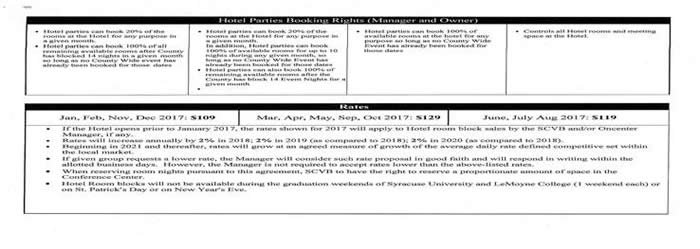
Request now in to Economic Development Council for a $3.9 million grant- City, through SIDA, 485b exemption, and authorized PILOT over 14 years with benefits estimated close to $14.6 million
- City is waiving mortgage recording tax, sales tax
- Expensive project – spending over $60 million
- State money comes with strings attached
- Has to be built through the unions
- Has to be operated as a union hotel (one of 2 union hotels in the county)
- Advantage from marking perspective – a lot of association business is unions
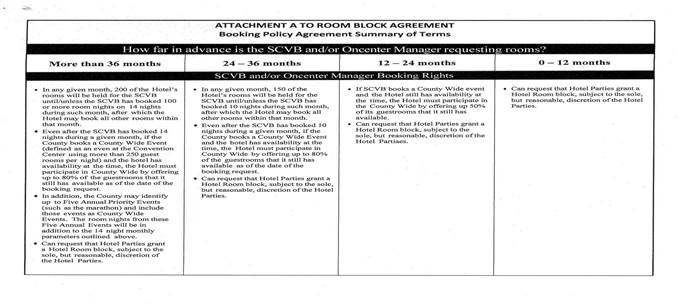
Mr. Jordan asked if all of the grants mentioned are in addition to the $15 million coming from the State. Mr. Fisher said that they are. Mr. Jordan asked what the additional economic benefit would be to the other programs. Mr. Fisher said that when the hotel is done, it will be worth about $30 million, but over $60 million will be spent to bring it back. Roughly half of the value comes from tax credits or grants
Mr. Holmquist asked what extent PLA’s are involved in this project. Mr. Fisher said there is not a PLA in this project. Mr. Holmquist questioned, of the $60 million project, not one dollar is in PLA’s. Mr. Fisher said that normally PLA’s aren’t budgeted for; if done right they can save money – there is not a PLA required on this. There is prevailing wage, and expected that a union, such as Unite Here, will be represented at the hotel.
Chairman Knapp said, as information was just received on this, he will not call for a vote today.
5. ONONDAGA COUNTY PUBLIC LIBRARY: William Fisher, County Executive, Susan Mitchell, Executive Dir.
a. A Local Law Authorizing a Lease of County-Owned Property Located in the Galleries of Syracuse to the State University of New York, and Repealing Local Law No. 8-2013
b. A Local Law Providing for a Lease of Space from the Onondaga Galleries, LLC, for the Onondaga County Central Library Renovation Project, and Repealing Local Law No. 8-2013
Items 5a and 5b were discussed simultaneously.
Mr. Fisher:
-
Local Law asks for repeal of the local law passed before – before had asked for the County executive to be able to enter into a lease agreement with Galleries, LLC:
- Terms were that the County would pay $8/sq. ft. for a while, then swap leasing rights – take 60,000 sq. ft. out of library condominium unit and swap for 27,000 sq. feet of LLC space
- It was going to be straight swap and Galleries, LLC would take on the risk
- Traveler’s gave notice that they were downsizing – and Galleries LLC did not want to take on that risk
-
Informed at Condominium Board meeting in January (legislator Rapp and Mr. Fisher are members) that County would go out and market the space that the library wasn’t going to use
-
Using proceeds from lease, take the cash and pay for space County wanted to lease from Onondaga Galleries LLC
-
County Executive found a willing lessee in Upstate Medical University
-
Upstate Medical University has a need for approx. 60,0000 square feet
-
Lease is for 60,000 sq. feet of county space to Upstate Medical University on 4th and 5th floor
-
County would lease from Onondaga Galleries a little space in the basement, where there is dirt and an ideal location for an elevator that has to be added; space on 1st and 2nd floors
-
Originally were going to lease 3, 4 and library hold onto 5 – Susan Mitchell and her team concluded that they would like to keep the library on floors 1,2,3 and lease floors 4 and 5 to Upstate
-
Library reduced by approx. 30% of sq. ft., but more welcoming and more able to bring people in from street level
Ms. Mitchell:
-
Make sure open to the mandated number of hours required by the State – currently work around it by opening only the 2nd floor for some periods of time
-
Moving floor 5 down deals with some of issues in the preconstruction phase where looking at floor load capacity
-
Floors 1 & 2 were never built for the capacity needed for library books, but floor 3 was
-
Majority of collection on 3 and more of the services are available on floors 1 & 2
-
Staffing was a concern long term and right sizing the library
-
The 5th floor is approx. 95% staff – by bringing it down will be able to create staff areas around the public service stations, which will include safety and security and not just deploying staff to those areas. There will be back up so there won’t have to be 2 people on the desk at any given time – can have one person there and if someone has to float to another area they can.
-
Moving 5 down meets a lot of service objections; staff is thrilled; cohesiveness of floors 1 -3 will really help
-
Renting out floors 4 & 5 with approx. 450 people combined – would be trying to move materials from the basement to staff on 5th floor for processing, then books disbursed to other floors. By being on floors 1-3, they will have a second elevator just for the library and able to move through their own space.
Mr. Fisher noted that at Planning Committee there were questions about the rent from one lease going to pay for the rent on the other lease. He distributed and reviewed the following:

10 year lease for the 4th floors; 11 year lease for 5th floor
- Shows how money comes in, covers the lease and builds up a reserve
-
OCPL to lease Galleries space for 23 years because bonds were borrowed at probable usefulness of 25 years – by the time leased next summer, bonds will be 2 years old
-
In years when both spaces are rented, will receive $$684,000, but for 1 year it will just be the 5th floor – Upstate Medical Univ. is moving their IT department in June/July; will take over the 4th floor the following October
-
$394,000 expenses – net operation income $294,000
-
$235,552 annually rent; $58,448 can be used to being accumulating a reserve
-
Proposing to pay condo unit charges – county gets heat, chilled, & potable water, fire suppression systems, etc. for other condo owner – proposed that Upstate Medical University pay toward that cost – currently part of OCPL budget. Since OCPL will be paying for less space, they will be paying less towards those services.
-
Spreadsheet shows how the reserve builds up – amortized $2,400,000; net cash flow $615,928
-
Over the 11 years, county should have a couple of years rent – want to be in a position wherein after 11 years, Upstate Medical walks, county can continue to pay the rent while finding a tenant for 4th and 5th floors
-
Upstate Medical has 2 – five year renewal options
A motion was made by Mr. Kilmartin, seconded by Mrs. Ervin to approve item 5a. Passed unanimously; MOTION CARRIED.
A motion was made by Mrs. Ervin, seconded by Ms. Williams to approve item 5b. Passed unanimously; MOTION CARRIED.
2 Mr. Jordan left the meeting.
6. MISC.:
a. Amending the 2014 County Budget to Release Contingency Funds for Distribution to the Village of Skaneateles, and Authorizing the County Executive to Enter into Agreements ($30,000) (Sponsored by Mr. McMahon)
Chairman Knapp said that items 6a and 6b are part of the Village Improvement fund. The Village of Skaneateles is installing UV system for their water – improved piping, reconstruction of curbing, etc.
A motion was made by Ms. Williams, seconded by Mrs. Ervin, to approve this item. Passed unanimously; MOTION CARRIED.
b. Amending the 2014 County Budget to Release Contingency Funds for the Distribution to the Village of Jordan, and Authorizing the County Executive to Enter into Agreements ($30,000) (Sponsored by Mr. McMahon)
Chairman Knapp said that the Village of Jordan project relates to a pump station, along the lines of our Save the Rain project.
A motion was made by Ms. Williams, seconded by Mr. Kilmartin, to approve this item. Passed unanimously; MOTION CARRIED.
7. COMMUNITY DEVELOPMENT: Robert DeMore, Director
a. INFORMATIONAL: Authorizing the Transfer of Tax Delinquent Properties to the Onondaga County Housing Development Fund Company
Mr. DeMore distributed photos of properties (also distributed at the Planning Committee meeting).
- County tax auction starts tomorrow
- Tracking houses since end of summer – looking at approx. 10; want to get 5 or 6 pulled from the auction
- Can’t provide the exact properties, but will chose the properties today at 4:00 p.m.
- At session, will have the properties and asking for approval so he can get into them before winter
Chairman Knapp noted that the pictures in the packet are past projects that have been done very effectively. Mr. DeMore reviewed the properties in the packet. Chairman Knapp noted that many of the properties are pretty far gone. A contractor can’t really take them on economically. It gives folks an opportunity to get into a first time home reasonably, in nice shape, and local contractors are hired.
Mrs. Ervin noted that many the properties are in Onondaga and District 12 and asked if properties beyond those areas are looked at. Mr. DeMore said that they are. Onondaga and Nedrow have had a lot; now looking at Geddes, Van Buren, Salina, Manlius, and Clay.
8. PURCHASE:
a. Revenue Contract Report - NONE
The meeting was adjourned at 11:04 a.m.
Respectfully submitted,

DEBORAH L. MATURO, Clerk
Onondaga County Legislature
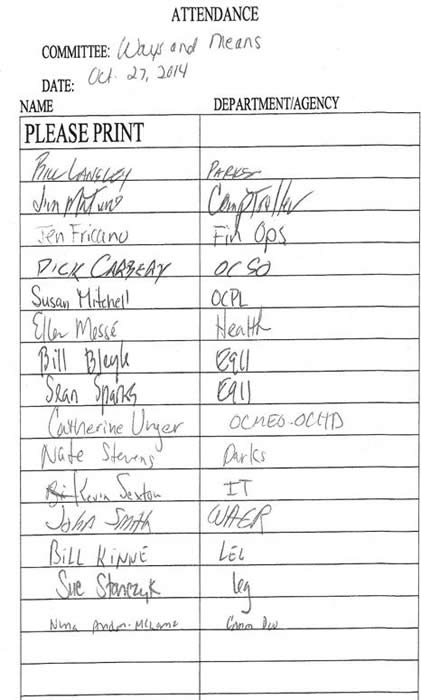
* * *
SPECIAL MEETING
ENVIRONMENTAL PROTECTION COMMITTEE MINUTES – OCTOBER 30, 2014
MICHAEL E. PLOCHOCKI, CHAIRMAN
MEMBERS PRESENT: Dr. Chase, Mr. Corl, Mr. Shepard, Mrs. Rapp
ALSO ATTENDING: Chairman McMahon, Mr. Jordan, Mrs. Ervin and see attached list
Chairman Plochocki called the meeting to order at 9:05 AM.
Chair Plochocki said that they have had some scheduling delays and naturally whenever there are scheduling delays there was some frustration. He appreciates everyone patience as they move through this process. Preliminary there are three things he would like to say:
1) This morning a few members of the Sierra Club are among their guests. All members of the legislature received emails over the last few days and these members asked to pass out hard copies of those emails before the meeting.
2) Introduced Zach Sauro, as senior at Marcellus High School who was shadowing someone in politics for half a day and was assigned to Chairman Plochocki.
3) Lastly, wanted to restate what he said at the last meeting. First and foremost he respects people however they vote. There was a lot of information and they had a lot to review. He was sure everyone on the committee read the document however, reasonable people can come down in different ways. He understands that and will respect that. He would like to emphasis to everyone that what they are voting on today was not an up or down vote on the amphitheater, they were voting on a legal process. The question before them today- was the FEIS complete. By complete he means have all of the potential reasonably foreseeable environmental issues, at this site, been given a hard look and remedies proposed. He asked that those with issues focus on what they believe was deficient in the document, in other words what were they not taking a hard look or hard enough look at. Those were the issues here. Fundamentally, whether someone supports or opposes the amphitheater there comes a day for all projects when there has to be a final impact statement. Ultimately, if the Legislature doesn’t approve the FEIS they go back and another statement is done or amended. He wants everyone to understand that this was a process and as they go forward on the process they are answering, was the statement complete. He asks that everyone not bias themselves with any other views they may have with regard to the amphitheater or the project as a whole.
A. PRESENTATION OF RESOLUTIONS AND LOCAL LAWS:
1. OFFICE OF THE ENVIRONMENT: David Coburn, Director; Bob Duclos, C&S Companies
a. For the Lakeview Amphitheater Facility (The Project) Under Review by the County of Onondaga: Adopting Findings Pursuant to the State Environmental Quality Review Act (SEQRA) and Authorizing the Publication, Circulation, Service, and Filing of Same (Sponsored by Mr. McMahon)
Mr. Coburn invited Mr. Duclos to join in at the table and provided the following:
-
Introduced other members of the technical team Bob Palladine from C&S Companies, Ben Brezell from EDR, Louis Mendez and Ben Yaz from the Law Department, and Kevin Row from the Gilberti Law Firm
-
Resolution based on information developed and provided to the Legislature over the past 9 months via SEQRA process, final step
-
Findings statement (On File with Clerk) prepared following 10-14-14 acceptance of the FEIS, confirms all SEQRA requirements for making decisions on the project have been met; resolution, findings statement highlights steps taken to satisfy SEQRA and identifies documents providing record upon which all findings are based, record indicates all significant impacts identified were avoided, minimized or mitigated to maximum extent practical, mitigation measures identified becomes part of the project if approved, documents Legislature has weighed and balanced all environmental impacts identified, also economic, social and any other concerns; from SEQRA standpoint project is approvable
-
Document should look familiar, identifies all impacts first identified in the DEIS
Mr. Coburn asked that Mr. Duclos highlight key findings from the document. Mr. Duclos:
-
2 weeks ago provided PowerPoint presentation to various members, used document as talking point for key issues; summarized 6-7 key topics and/or issues, not singled out to diminish or downplay other issues or concerns, were issues that garnered most public attention and discussion amongst constituents
 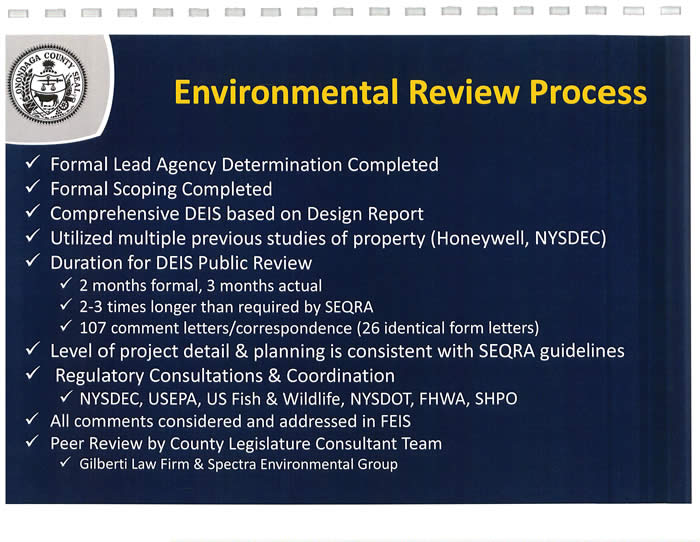
-
Review process summarized in FEIS, County went through number of formal steps required as part of SEQRA, also did optional things not required, i.e. formal scoping process – received public and community input before DEIS was developed; DEIS prepared after completing scoping process, adopted by the County in July 2014, Legislature extended public review period to September 5, 2014, held a number of public hearing to obtain public input on DEIS throughout the process; Legislature accepted FEIS as acceptable in form and content, findings statement next part of process for Legislature to consider
 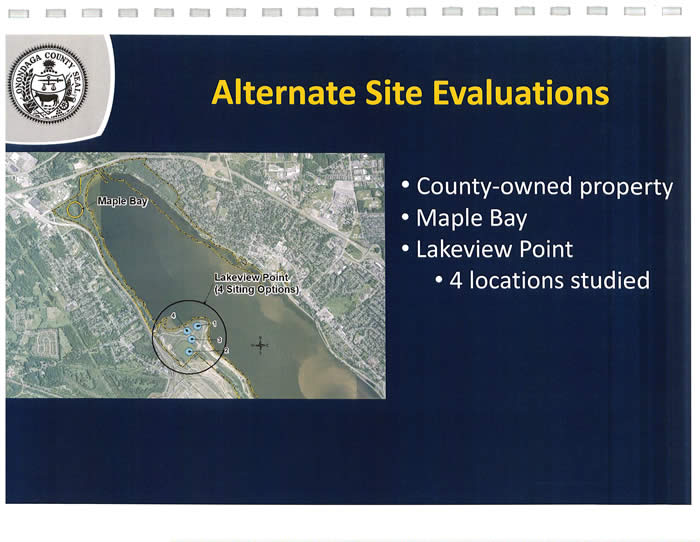
-
Alternative site evaluation part of scoping process for DEIS, primary objectives, purpose and need of the project was to enhance the west shore of Onondaga Lake, the surrounding community, and take advantage of investments made over past 15 years in that area relative to lake improvement project and other things; number of sites and properties evaluated along west shore of the lake for suitability to accommodate venue of this size, documents seen over past 6-8 months summarized that process, consisted of Maple Bay area and Lakeview Point area, host of alternatives were explored in the Lakeview Point area
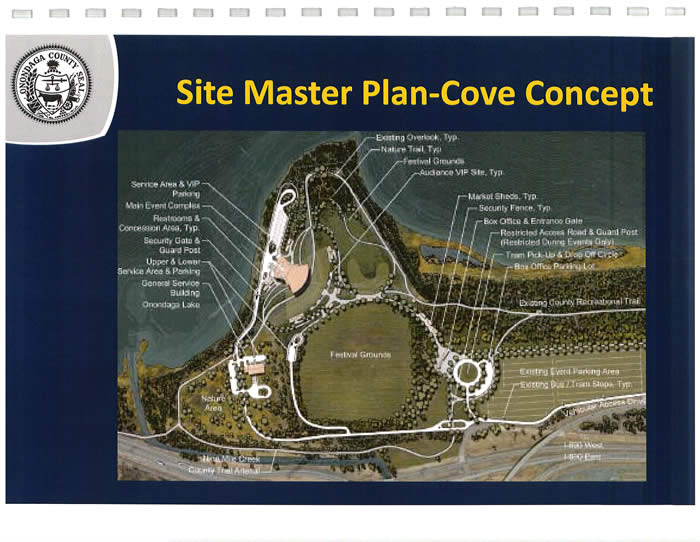 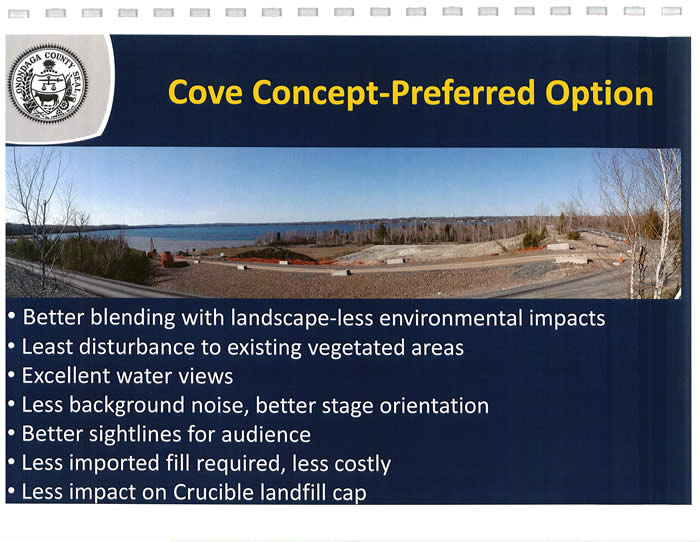
-
Cove option identified as preferred development plan for amphitheater on Lakeview Point site, reasons are several and numerous, summarized on slide, number 1 advantage primarily related to the environmental review process – minimizes environmental impacts associated with the project, fits into petrography and landscape of Lakeview Point, minimizes visual impacts for community surrounding the site, minimizes to greatest extent practical noise impacts from facility located on west shore of Onondaga Lake and reduces noise from neighboring sources, i.e. I-690, also provides desirable attributes for facility making it an attraction for the community and entertainers; facility integrated into landscape requiring less imported fill and construction materials, least costly construction option of all alternatives evaluated
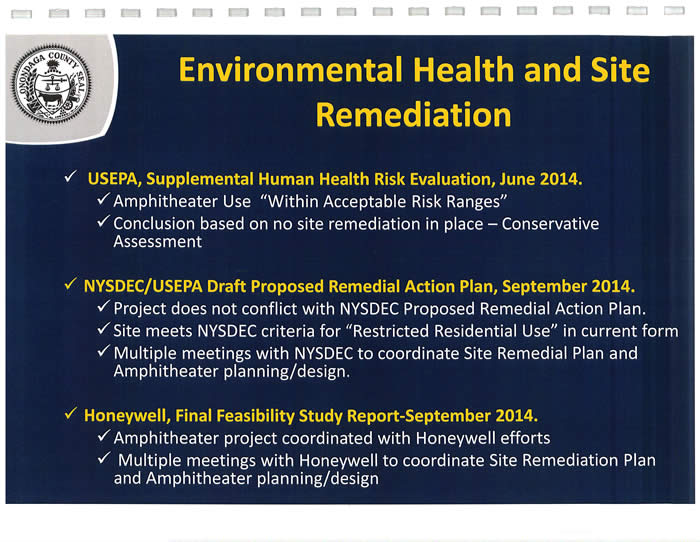 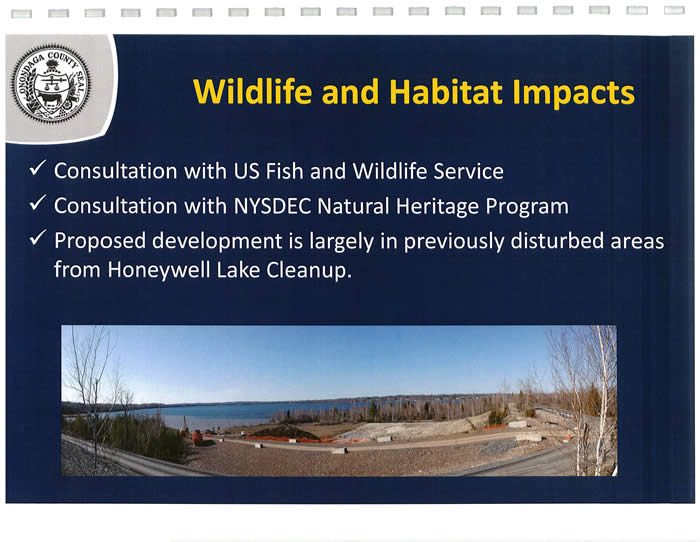
-
Great interest amongst Legislature and community for environmental health and remediation plans associated with the project, past 8-9 months exhausting amount of studies by County team working on project and outside agencies including the NYS DEC, US EPA and Honeywell; 3 parallel studies done while DEIS was done, US EPA determined site without remediation, using very conservative assumptions for exposure scenarios was within acceptable risk levels for an amphitheater
-
Exerting an additional level of conservatism and due diligence, NYS DEC, Honeywell & US EPA put together remedial plan for site, includes additional cover material for all areas around amphitheater where the public would be visiting the site, goes beyond amphitheater area of influence, process has gone through formal review, public comment and response period, NYS DEC and US EPA follow rigorous approach in that regard; public comment period ended October 15, 2014, DEC to issue final record of decision in near future, confirmed to County remedial plan outlined publically won’t be changed based on comments received
-
Wildlife and habitat impacts important to County, Legislature, and County staff, has been diligently reviewed, selected preferred option minimizes to greatest extent practical further impacts on wildlife and habitat along the west shore area, beautiful part of the lake, current location very disturbed, result of Honeywell remediation and construction project going on for a number of years, one benefit of selected location was minimization of additional trees, vegetation and disturbance to wildlife that could occur as a result of the development project; all appropriate regulatory agencies have been consulted as part of the DEIS and the FEIS process with regard to all of these issues, i.e. NYS Office of Parks & Recreation & Historic Preservation, responded back - in their opinion proposed develop does not pose any adverse impacts on wildlife and habitat resources along the west shore of the lake
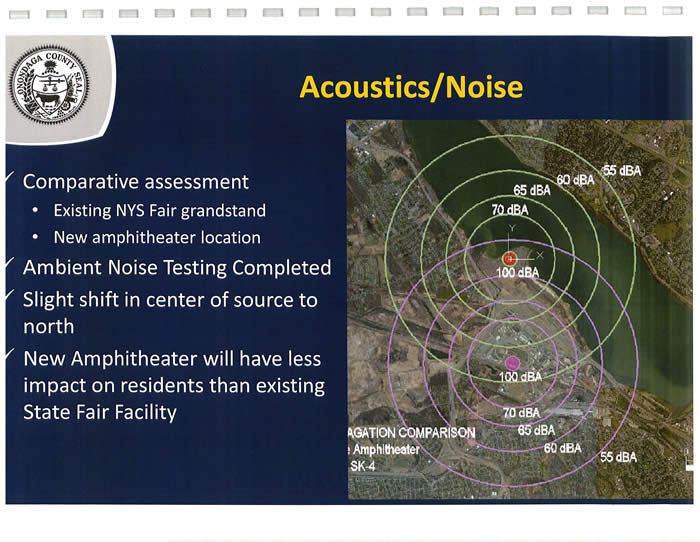 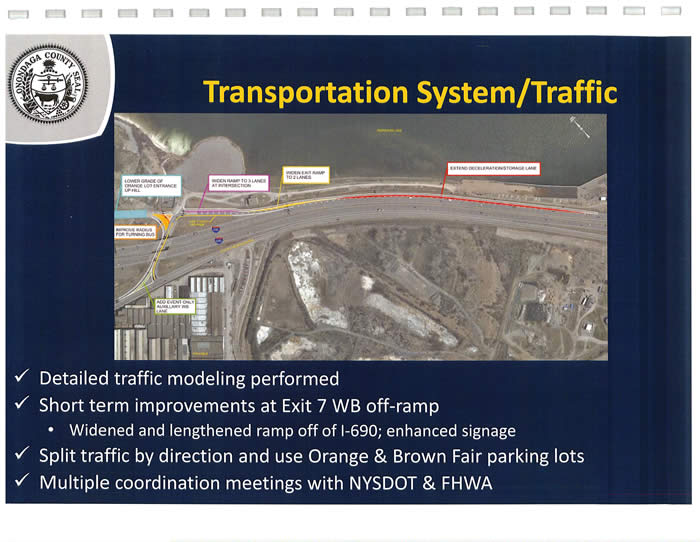
-
Have talked about acoustics and noise at several meetings, project of this size and nature has some impacts - there are no projects without impacts, County’s due diligence with regard to SEQRA was to avoid or minimize to greatest extent practical any impact associated with the project, concert venue regardless of location would have impacts such as noise and temporary periods of traffic impacts; assessment relative to noise looked at how the location balances those requirements, comparative assessment concluded moving location to proposed site in broader since would impact less residential properties and residents in the Solvay/Geddes area than current State Fair venue; conservative assumption for noise, doesn’t take into account damping effects due to petrography, trees and vegetation, information presented was conservative approximation of what might be experienced in the community
-
Identified need for traffic and safety improvements, conclusions arrived at through detailed traffic modeling studies done in collaboration; widening and extension of I-690 off-ramp to Exit 7 to minimize potential for backups on the off-ramp, off-ramp not very good in current form, improvements would be welcome with or without the amphitheater, through meetings with NYS DOT and FHWA received written support in agreement with mitigation measures proposed relative to transportation and traffic; all of the traffic modeling and improvements identified were based on State Fair traffic control measures not being in place, very conservative view, only looks at various ingresses and egresses being available for the amphitheater
Mrs. Rapp asked if the traffic improvements would be made with or without the amphitheater. Mr. Duclos said that if the amphitheater project was not completed there would be no requirement for the County or the DOT to make the improvements.

-
Site has some unique characteristics, exhaustive amount of study and work to characterize the site both from environmental and geotechnical standpoint, has been benefitted by approximately 10 years of intensive study by NYS DEC and Honeywell at project site, over last 6-8 months has been supplemented by very extensive subsurface testing to characterize and quantify all the different materials present on the site; things taken into account – environmental health considerations, and things seen on this slide
Dr. Chase said that this was a lot of work and they have done a great job however, step one of the decision was not put out to the public; 1) do they want an amphitheater, 2) where would they like it. This was brought forward by the County saying that they had made the decision and this was where it was going to be, then there were public meetings and people were very verbal, wanting to know why they weren’t looking at other sites. This is a beautiful area but it has a lot of problems. It seems like they could have saved a lot of time, effort and money looking at some place without so many problems. She feels that there really was no public input. Onondaga County has beautiful landscape, not the least of which is Onondaga Lake. She feels that they could have done a better job of picking a location and wonders if someone could come back and say that they didn’t look at everything, they narrowed in one spot and put all their resources into looking at that. They did a great job and covered all the items but she would have liked to see 2 or 3 other locations also covered. Mr. Duclos:
-
Dr. Chase’s point well taken, all have heard and read about what other areas that could be considered; within context of SEQRA and as part of the scoping process the purpose and need were defined for the project before any work was done - purpose and need was to develop and enhance the west shore of Onondaga Lake, take advantage of previous investments and maximize opportunities available through county-owned parkland, public had opportunity to comment on principal objectives outlined in scoping process, perfectly within the County’s rights to frame discussion and evaluation of SEQRA with those objectives; many could suggest a broader vision could have been outlined, County did not misstep by stating what objectives where and then looking for properties in areas that fit within those objectives
-
Outside of that many other areas could have been considered for venue of this size and nature, from a technical and engineering prospective many other issues would crop up when looking at different sites; doesn’t want to go down exhausted concept of talking about different sites, if facility of this size and nature were put in a more rural area would have a whole host of other issues that would counter balance or be the same as the things they are talking about relative to this location, i.e. adequacy of transportation network to support a facility of this size, one apparent benefit of this location, community and emergency responders are accustomed to hosting or receiving large-scale events in the area, rural location would likely run into traffic congestion, wouldn’t be close to interstate system; where would parking be accommodated, this location has benefit of State Fair parking lots; water and sewer for rural area - was there the ability to support the needs for a facilities such as this, current location has fairly robust facilities available; noise – will have noise impact wherever it is located
Mr. Gilberti said that from a legal prospective he agreed with Mr. Duclos on the appropriateness of considering policy objectives identified for the project, which was to enhance the west shore of the lake. The SEQRA process was influenced by that objective. That does not mean that Legislators are bond by that, it was just the objective at this point and they are allowed to say that they do not agree with that objective. In determining whether this was an appropriate project to serve that objective, the SEQRA review basically says that among the alternatives available this was the one that minimized the environmental impacts to the greatest extent practical to serve that objective.
Mrs. Rapp said that builders are telling her that it will be a challenge to build on that site and asked how far down the piles were going to go. Mr. Duclos:
-
Primary building structures would be supported on pile foundation resting on bedrock, buildings won’t be dependent upon sitting on Solvay waste or material; very common for any construction, even if it weren’t Solvay material, i.e. Destiny, Inner Harbor projects, not doing something special
-
Bedrock elevation varies along Lakeview Point area, amphitheater piles approximately 100 – 120 feet; Metro WWTP built in the same manner with bedrock depth even greater than the Lakeview Point area
Mrs. Rapp asked about stability concerns. Mr. Duclos:
- Large scale facilities would be on bedrock, characteristics of Solvay material won’t have a big influence on the building structures because of that
- Some special design technics implemented for things like roads and utilities; doesn’t play a large role in the stability for the major buildings
Mrs. Rapp asked about corrosive agents. Mr. Duclos said that for things such as underground conduit and other things of that nature there are things that can be done; utilize high density polyethylene and things of that nature, which are corrosion resistant. The testing in the area alluded to earlier has not indicated that materials are hostile to the materials needed to construct the facilities, as long as appropriate materials are selected. Chair Plochocki said that some may say that there could be something unexpected, perhaps something could corrode despite the best materials used and there could be added costs because of the nature of this site. He asked Mr. Duclos to talk about how the County would be insulated from surprises of that nature, given that it was a design build project. Mr. Duclos said that there are certain things that can be done through the selection of materials and design to provide an extra level of conservatism and safety with regard to the longevity of the facility, i.e. utilizing different types of plastic materials for conduits, water pipelines, etc. Very common in other types of sites as well. In answer to Mrs. Rapp, Mr. Duclos confirmed that the cement would not be coated.
Chairman Plochocki asked if he was able to speak to the aspect that this was a design build project as opposed to a standard bidding project. Mr. Duclos:
- Question outside environmental impact scope of today’s decision
-
NYS Legislature granted Onondaga County the ability for the design build procurement method, if they so desired, offers a number of advantages and maintains the competitive procurement process, more latitude on quality, costs control and schedules:
-
Quality – doesn’t have to be lowest bidder, can use discretion and consider other factors in choosing construction team
-
Cost Control - work collaboratively with contractor during design, minimizes potential for things to come up during construction that haven’t been discussed or considered
-
Schedule – allows project to be done in an expeditious manner - design and construction take place at the same time; from very high level these are the kinds of things that are offered
- Granted to the County via State legislation adopted June 2014
Mr. Corl said that the big concern was the human health risk and the analysis in the SEQRA document, which incorporates the EPA report by reference. Asked that he expand further, including how the EPA arrived at their decision that there are no health risks, a little about remediation and the supplement to the report for younger children. Mr. Duclos:
-
Original assessment done as part of Honeywell remedial investigation for the site
-
EPA conducted independent assessment of the site based on proposed amphitheater use, used significant number of conservative assumptions to arrive at conclusion explained earlier, i.e.:
-
Assumes potential visitor would be exposed to absolute worst environmental condition identified anywhere in the area – not really representative of the amphitheater site
-
Used conservative assumptions with regard to exposure scenarios – roughly 75 hours of attendance over the course of 1 year for a 30 year period
-
Assumes direct dermal exposure to the Solvay material – meaning direct contact with the skin
-
EPA determined site without any remediation does not pose unacceptable risk
-
Review process of the DEC Remediation Plan asked if the EPA considered infants or small children as part of their human health risk, in response EPA evaluated that condition as well with same assumed conditions and had the same conclusion in the supplement – no unacceptable risk for infants and small children
-
Honeywell and DEC provided Proposed Remediation Plan for the site, goes above and beyond human health risk assessment, which said it was ok for all attendees to visit the facility without any remediation, plan provides cover over entire amphitheater site and Wastebeds 1-8:
-
Minimum 2 feet of clean soil material for areas with active recreational use or potential for people to be sitting on the ground
-
Minimum 1 foot cover for areas with walkways, paths, road, etc.
-
4 inches of cover material for areas with no potential for visitors or wooded, will enhance vegetation already on site; Honeywell responsible for implementing and paying cost of remedial measures, part of their obligations relative to the property as a whole
For the record, Chairman Plochocki said that this was critical to him. Months ago he said that there were three threshold issues before he could deem the FEIS complete, let alone move forward on the amphitheater:
- There was no remedial action proposed at that time and he said that there had to be a serious remedial action plan put forward - a serious plan that talked about what the DEC and EPA wanted for restoring the environment and protecting human health in the area
- The proposed plan put forward as the preferred option cannot conflict with the amphitheater plans – in other words if the proposed remediation would be hindered by the amphitheater, needless to say that would be a problem
- It was critical for the DEC to say that their preferred remediation plan would not change based on whether or not the amphitheater was built – wanted to know their one plan to protect the environment and human health for the site; all 3 things have been meet, DEC put forward a plan which they said was not in conflict with the building of the amphitheater
For the record, Chairman Plochocki said that during a NYS DEC public hearing he point blank asked Ken Lynch, Regional Director, “You’re telling me that your proposed remedial action plan would not be hindered by the proposed amphitheater and that it would not change based on whether or not we built the amphitheater” and on the record Mr. Lynch said, “Yes”. In building to Mr. Duclos’ answer, Chairman Plochocki wanted to make sure that everyone understood those concerns were discussed. Mr. Duclos added that in the end the lawn area, where the public would be sitting, would have much more than 2 feet of additional cover. Fill would be brought in to create the sloped seating area, on average it would be about 10 feet, adding another mitigation measure or level of conservatism.
Dr. Chase said that they have been listening to mitigation and remediation of wastebeds for construction of an amphitheater and asked why. She cannot believe that there aren’t other sites that do not need this degree of remediation to ensure a safe location - this just boggles her mind. Mr. Corl said that perhaps he misunderstood but he believes Dr. Chase’s point was that if the site was left as is, per the DEC or EPA there was no necessity for any remediation. Chairman Plochocki said that remediation was needed. Mr. Duclos said that the site would need to be remediated by Honeywell regardless of anything being built there. Chairman McMahon said that this was the remediation plan, it did not matter what was built there or if it was left alone.
Chairman McMahon said that he appreciated what Dr. Chase was saying but believes she continues to ignore the policy, adding that it was ok to disagree with the police. The policy setout was for the western side of Onondaga Lake, the side where the pollution came from, the side where communities around it had their waterfront taken away, decimated, and left abandoned throughout all of the revitalization efforts the County has seen. Unlike the east side of the lake were an Onondaga County Park was created and an investment was made to help revitalize the neighboring villages, this hasn’t happened on the west side. In the Inner Harbor area millions and millions of dollars have been spent in the City of Syracuse for cleanup of Onondaga Lake and Onondaga Creek but nothing has happened on the west side. This is parkland and they looked at other factors but it was not apples to apples to say build it downtown or somewhere else such as a rural area, they don’t own parkland downtown. Perhaps they could build in a rural area, if they had parkland, but there have been studies on shelves for decades where there was talk of an amphitheater or concert venue on the lake. A FOCUS study was funded that talked about the usages and what people wanted to see around the lake and he feels that this plan is very consistent with those goals. The Loop the Lake Trail was done to meet those goals and this plan is consistent. The idea that other areas were not looked at was just not true and they do not own the State Fair that was a state issue. They have a plan that was consistent with what has been talked about and studied, which they feel will revitalize the western side of the lake, just like the eastern and just like the millions of dollars the County has put into the City of Syracuse for the Inner Harbor. If someone was against the policy, that was fine but what they were considering today was the environmental factors - was it safe to do what they have been talking about doing.
Mrs. Rapp said that the legal community has a concern that they are setting themselves up for future lawsuits and asked if they had sufficiently addressed the what ifs so that they could confidently go forward knowing that they are proposing a facility that was as safe as it could be anywhere else it was built. Mr. Mendez said that they have relied on regulatory facilities that have addressed any health concerns for use of the site with or without remediation. To the extent that they have done that and are making discretionary decisions based on those studies, he believes that state law would grant the County immunity based on those decisions. That does not mean that people aren’t going to sue. Chair Rapp agreed that they could not control that but asked if they could backup there decision. Mr. Mendez said that he thinks the health studies would significantly help in backing up that decision. Mr. Gilberti said that he agreed, adding that they had every reason to rely on the expertise of the US EPA and the DEC, using their evaluations and exercising discretion and judgment. In addition, it is ultimately Honeywell’s responsibility to remediate the site and protect public health in accordance with the intended use identified as the amphitheater. They can’t prevent anyone from suing them.
Mrs. Rapp said that Mr. Gilberti deals with environmental law and asked if he would be on a solid platform if called upon on to defend the County in this case. Mr. Gilberti said that she was assuming some facts where someone sued the County who had been a long-term concert attendee and developed some sort of illness. Mrs. Rapp interjected saying that she realizes this was all what if. Mr. Gilberti said that if that was the scenario, he believes it would be adjudicated to be protected by governmental entities as they made reasonable decisions based on reasonable reliance of existing studies by agencies who had been delegated that responsibility with expertise and used discretionary judgment based upon that. Mrs. Rapp said that this was important as they don’t want to come back and find out that, in an effort to move this quickly, they had put people in the community at risk unnecessarily, and that they truly are creating something better and safer than what they had before.
Chairman McMahon said that comparatively they constructed the Loop the Lake Trail on roughly the same soil and these issues were considered then also. This was just a different type of use. Mrs. Rapp said that there was a difference when they were spinning by on their bike. Chairman McMahon said or they could be walking on or off the trail, it was the same thing, this is parkland and that was what this process was all about. Anyone can sue - as they have learned throughout this process there are many experts in the community that think they know all the answers, so they have to rely on their own experts. Mrs. Rapp said that she had to find out the answers to be able to support this with some degree of authenticity that they had asked to have these questions answered. Mr. Gilberti said that it was important to point out that Honeywell was on the table for remediation. Remediation was not being undertaken by the County for this project. The County would ultimately be coming to this project through a remediated segment in conjunction with Honeywell during construction, like other types of constructions that would remediate the site first and then construction would take place. It was not as if part of the project they are looking at involves undertaking remediation of the site that was not what this involves, Honeywell will undertake that responsibility. Mrs. Rapp said that this was interesting.
Chairman Plochocki said that at another meeting he questioned the concentric circles on the acoustics/noise slide, as he was concerned that they didn’t seem to be taking terrain into account. The answer he received at the time from Mr. Duclos and others was that the diagram was terrain neutral and was meant to give a conservative sound estimate regardless of terrain. Mrs. Rapp asked if he was saying that there would be less of an impact because of the terrain. Chairman Plochocki said that was what he would image Mr. Duclos was saying. Mrs. Rapp said that people in Liverpool are concerned about that. Mr. Duclos said that it would be a fair statement as the facility itself was situated down by the water and was nestled at a low point as opposed to being in a very prominent location. Based on the location chosen they would have some attenuation because of the pictography. In answer to Mrs. Rapp, Mr. Duclos confirmed that attenuation meant a reduction. Mrs. Rapp asked if there would be something built behind the shell to help with the attenuation. Mr. Duclos said that there would not. In the interest of propagating the sound for people listening, they are pushing the sound toward the audience. As mentioned in the previous meeting there was a lot of consideration given to the orientation of the stage and the speakers so that it was not pointed across the lake or towards Liverpool. It will be pointed in a direction that provides the greatest separation to sensitive receptors such as residential houses and communities. The terrain hopefully will assist in that regard also because of the location for the lawn and seating receptors and the stage being down low. In answer to Mrs. Rapp, Mr. Duclos said that the sound would not be reflected because of the grass. Mrs. Rapp said that the people along the lake have some concern about that. She has a summer camp and can be out in the middle of the lake and hear people making breakfast because of the way sound travels across water.
Mr. Jordan said that he was not a chemical engineer but his understanding was that soda ash was potentially very caustic especially for a substance like steel and asked what they were going to be doing to protect that structural steel. Mr. Duclos said that as previously stated they have not found the material to be as caustic as others may have been mentioning in pervious discussions. In any event, a portion of the steel piles would be coated with a bituminous or epoxy coating to provide added protection in the event that there was potential for corrosion. Honeywell has been doing that as a course of business for anything they have been building in there. It was not an expensive or labor intensive process, it was just putting a shop applied coating to a certain portion of the piles. In answer to Mr. Jordan, Mr. Duclos said that the application was normally shop applied to provide quality control.
Mr. Jordan questioned the stability of the area around the amphitheater, which could be settling and causing problems. In layman’s explanation, gaps between the substrate around it and the actual structure itself. Mr. Duclos:
-
Much investigation and analysis has been done relative to potential settlement of Solvay material, County geotechnical consulting team has worked on all the Honeywell construction projects on Solvay material for the last 10 years
-
Procedures have been implemented over the years to address this, i.e. preloading for areas with fill, pavement and ultimate construction, put fill on Solvay material causing consolidation or settlement over a certain period of time; studies have been done by Honeywell and consultants to quantify length of time and how they cause that to occur
-
Issue well known by those building, measures could be taken during design and construction that would provide completed facility without long-term settlement issues
Mr. Jordan said that they were adding fill on top of a spongy material and no matter how much fill they put on top of it, it would still be subject to compacting further. Mr. Duclos said that the studies have shown that by preloading material they get the settlement characteristics out of that material. As mentioned earlier, the buildings themselves are not supported on that. The weights that the Solvay material would have are actually quite low - foot traffic, lawn seating and things of that nature. There was inherent stability and carrying capacity associated with that material. It was not a situation where that material wouldn’t have any valuable support characteristics associated with it. As long as they don’t exceed the characteristics quantified, it would not be an ongoing issue that would never solve itself.
Mr. Jordan said that he had recently driven passed the planned construction site and the odor made him recall the days when he traveled the route daily and the aroma from the wastebeds, particularly in the summer time. Projections have been made as to revenues and attendance but those projections would have to factor in the fact that people are coming to an outside amphitheater with this aroma. Mr. Duclos:
- People in the community have a lot of historical prospective about the lake and west shore area, which has changed a lot in the past 10 years
-
Lake conditions have dramatically improved over past 15 years, look and smell much different today; he utilizes the lake often for fishing and the West Shore Trail, never noticed obnoxious orders or unsightly things in the area
-
Over past 1-2 years Honeywell put in interim remedial measures, ground water collection trenches and pipelines along west shore of the lake, captures ground water that may have contaminants - where the odors used to come from, built groundwater treatment facility to treat and release captured ground water
- Many long standing things heard from the community have changed for the better
Mr. Jordan said that last Tuesday it still smelled. In answer to Dr. Chase, Mr. Jordan said that he had his windows closed. Dr. Chase said that it still smells. Mr. Duclos said that there was still active work going on in the area, it was not 100% complete. Honeywell was actively involved in completing the work over the course of this year. Mr. Corl asked if the trenching was being done around the lake point on the site or down further. Mr. Duclos said that it was all along the lakeshore on the west side. It would not interfere with the amphitheater and would capture any ground water that would potentially leak out or seep into the lake itself. In answer to Mrs. Rapp, Chairman Plochocki confirmed that Metro was going through additional odor control, in addition to the many things that they have already done. Mrs. Rapp said that it had failed and was not working. Mr. Duclos said that he had not heard that.
Mrs. Rapp said that their vote today was on whether or not the DEIS was complete and if all their questions were answered on the environmental side. Chairman Plochocki confirmed that was correct.
A motion was made by Mr. Shepard, seconded by Mr. Corl to approve this item. Ayes: 4 (Shepard, Corl, Rapp, Plochocki), Noes: 1 (Chase); MOTION CARRIED.
The meeting was adjourned at 10:15 AM.
Respectfully submitted,

KATHERINE M. FRENCH, Deputy Clerk
Onondaga County Legislature
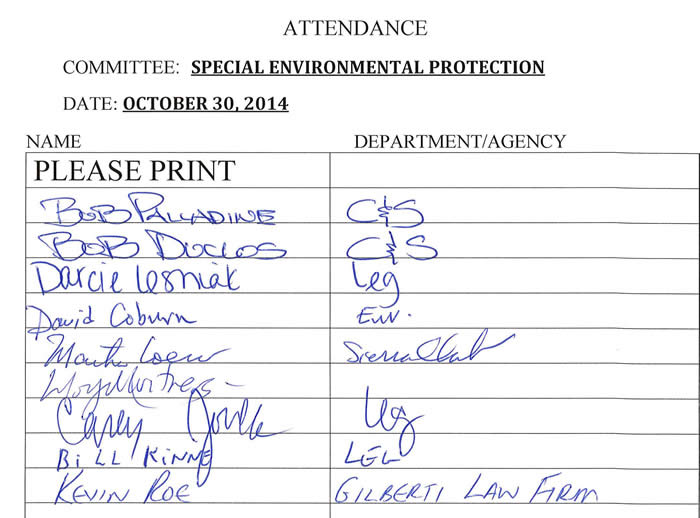
|



































































































































































